Quick filters:
Top of the trenches Stock Photos and Images
 TRENCHES WW1 Over the top ‘Battle Of The Somme’ 1916 Stark grim powerful image of British troops in line ‘to go over the top’...of the trenches, under heavy German Empire Army fire during the Battle of the Somme. (Somme Offensive) Harrowing numbers of casualties were suffered on both sides... Western Front Pas de Calais France World War 1 First World War World War One 1916. This image has been carefully re-mastered to retain its original image detail impact... Stock Photohttps://www.alamy.com/image-license-details/?v=1https://www.alamy.com/trenches-ww1-over-the-top-battle-of-the-somme-1916-stark-grim-powerful-image-of-british-troops-in-line-to-go-over-the-topof-the-trenches-under-heavy-german-empire-army-fire-during-the-battle-of-the-somme-somme-offensive-harrowing-numbers-of-casualties-were-suffered-on-both-sides-western-front-pas-de-calais-france-world-war-1-first-world-war-world-war-one-1916-this-image-has-been-carefully-re-mastered-to-retain-its-original-image-detail-impact-image189209417.html
TRENCHES WW1 Over the top ‘Battle Of The Somme’ 1916 Stark grim powerful image of British troops in line ‘to go over the top’...of the trenches, under heavy German Empire Army fire during the Battle of the Somme. (Somme Offensive) Harrowing numbers of casualties were suffered on both sides... Western Front Pas de Calais France World War 1 First World War World War One 1916. This image has been carefully re-mastered to retain its original image detail impact... Stock Photohttps://www.alamy.com/image-license-details/?v=1https://www.alamy.com/trenches-ww1-over-the-top-battle-of-the-somme-1916-stark-grim-powerful-image-of-british-troops-in-line-to-go-over-the-topof-the-trenches-under-heavy-german-empire-army-fire-during-the-battle-of-the-somme-somme-offensive-harrowing-numbers-of-casualties-were-suffered-on-both-sides-western-front-pas-de-calais-france-world-war-1-first-world-war-world-war-one-1916-this-image-has-been-carefully-re-mastered-to-retain-its-original-image-detail-impact-image189209417.htmlRMMYR6F5–TRENCHES WW1 Over the top ‘Battle Of The Somme’ 1916 Stark grim powerful image of British troops in line ‘to go over the top’...of the trenches, under heavy German Empire Army fire during the Battle of the Somme. (Somme Offensive) Harrowing numbers of casualties were suffered on both sides... Western Front Pas de Calais France World War 1 First World War World War One 1916. This image has been carefully re-mastered to retain its original image detail impact...
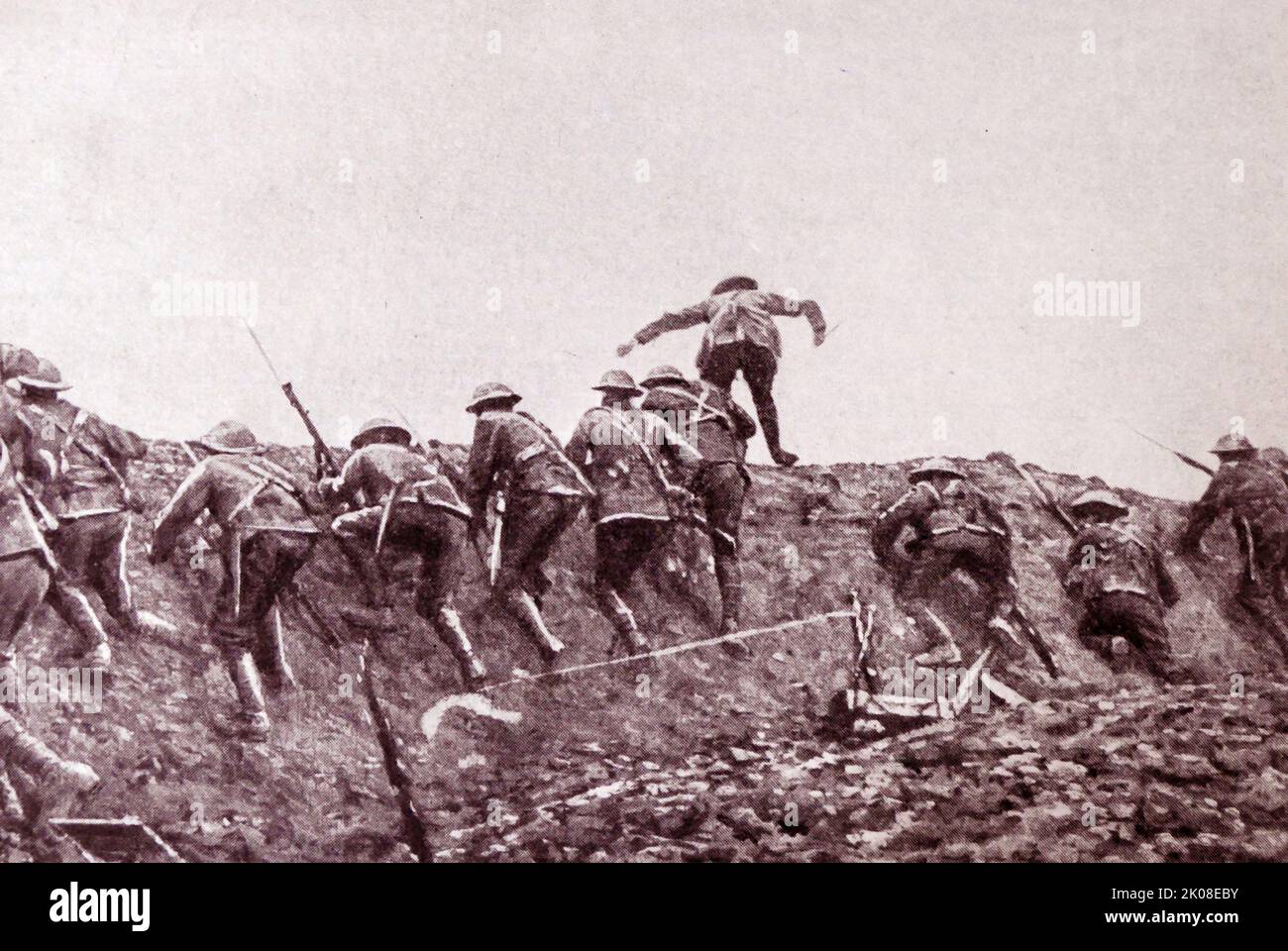 Zero hour on the Somme. British troops go over the top of the trenches to charge the German lines on July 1, 1916 Stock Photohttps://www.alamy.com/image-license-details/?v=1https://www.alamy.com/zero-hour-on-the-somme-british-troops-go-over-the-top-of-the-trenches-to-charge-the-german-lines-on-july-1-1916-image482077231.html
Zero hour on the Somme. British troops go over the top of the trenches to charge the German lines on July 1, 1916 Stock Photohttps://www.alamy.com/image-license-details/?v=1https://www.alamy.com/zero-hour-on-the-somme-british-troops-go-over-the-top-of-the-trenches-to-charge-the-german-lines-on-july-1-1916-image482077231.htmlRM2K08EBY–Zero hour on the Somme. British troops go over the top of the trenches to charge the German lines on July 1, 1916
 A raiding party of the 10th Battalion, Cameronians (Scottish Rifles) waiting in nap for the signal to go. Near Arras, 24 March 1917. Stock Photohttps://www.alamy.com/image-license-details/?v=1https://www.alamy.com/a-raiding-party-of-the-10th-battalion-cameronians-scottish-rifles-waiting-in-nap-for-the-signal-to-go-near-arras-24-march-1917-image463068123.html
A raiding party of the 10th Battalion, Cameronians (Scottish Rifles) waiting in nap for the signal to go. Near Arras, 24 March 1917. Stock Photohttps://www.alamy.com/image-license-details/?v=1https://www.alamy.com/a-raiding-party-of-the-10th-battalion-cameronians-scottish-rifles-waiting-in-nap-for-the-signal-to-go-near-arras-24-march-1917-image463068123.htmlRM2HWAG37–A raiding party of the 10th Battalion, Cameronians (Scottish Rifles) waiting in nap for the signal to go. Near Arras, 24 March 1917.
 Photograph of Canadian soldiers practicing going over the top of training trenches during the First World War. Dated 1916 Stock Photohttps://www.alamy.com/image-license-details/?v=1https://www.alamy.com/stock-photo-photograph-of-canadian-soldiers-practicing-going-over-the-top-of-training-90842252.html
Photograph of Canadian soldiers practicing going over the top of training trenches during the First World War. Dated 1916 Stock Photohttps://www.alamy.com/image-license-details/?v=1https://www.alamy.com/stock-photo-photograph-of-canadian-soldiers-practicing-going-over-the-top-of-training-90842252.htmlRMF7P664–Photograph of Canadian soldiers practicing going over the top of training trenches during the First World War. Dated 1916
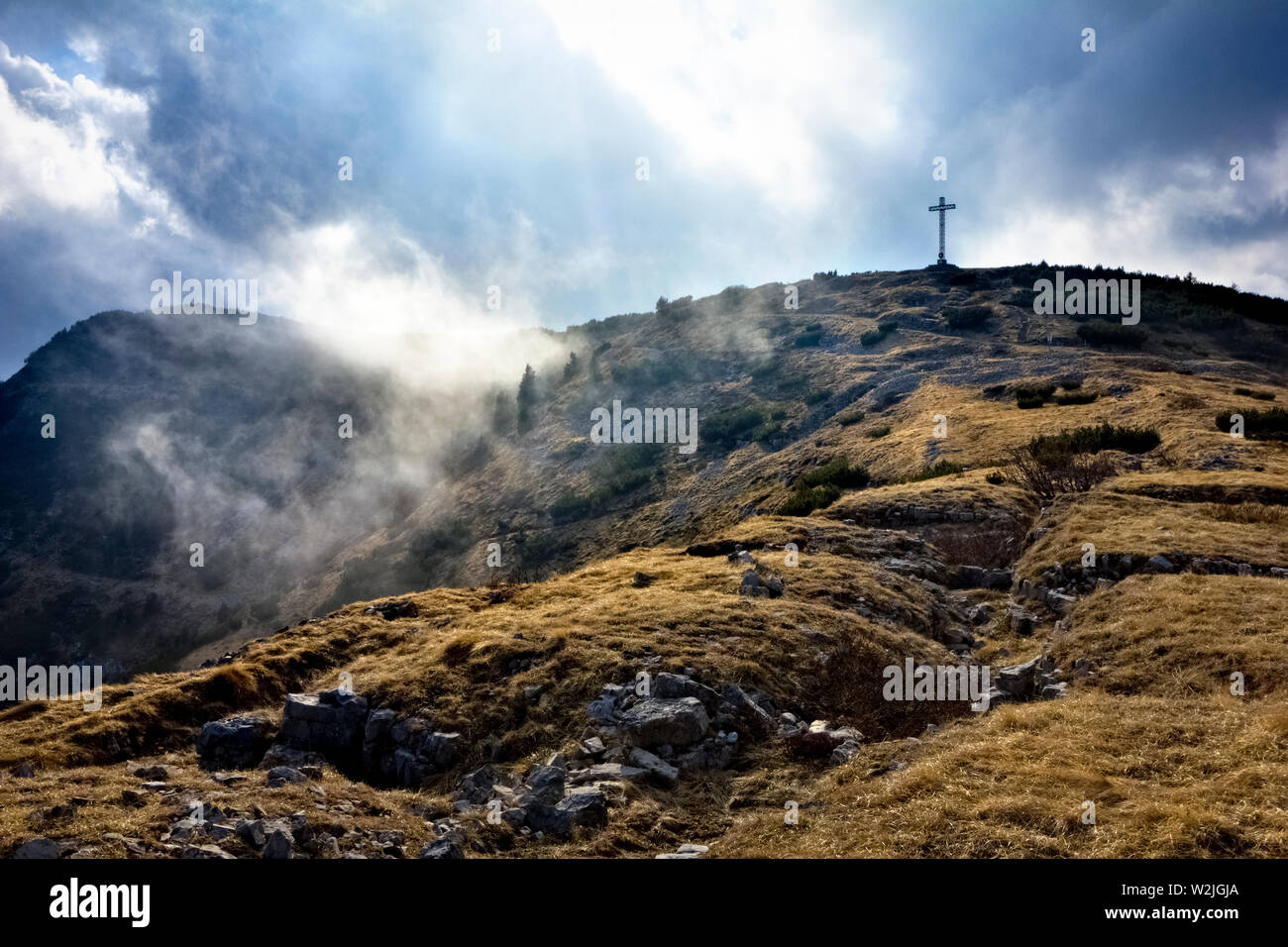 Mount Maggio: the cross on the top and the trenches of the Great War. Folgaria, Trento province, Trentino Alto-Adige, Italy, Europe. Stock Photohttps://www.alamy.com/image-license-details/?v=1https://www.alamy.com/mount-maggio-the-cross-on-the-top-and-the-trenches-of-the-great-war-folgaria-trento-province-trentino-alto-adige-italy-europe-image259793026.html
Mount Maggio: the cross on the top and the trenches of the Great War. Folgaria, Trento province, Trentino Alto-Adige, Italy, Europe. Stock Photohttps://www.alamy.com/image-license-details/?v=1https://www.alamy.com/mount-maggio-the-cross-on-the-top-and-the-trenches-of-the-great-war-folgaria-trento-province-trentino-alto-adige-italy-europe-image259793026.htmlRFW2JGJA–Mount Maggio: the cross on the top and the trenches of the Great War. Folgaria, Trento province, Trentino Alto-Adige, Italy, Europe.
 Zero hour! Prompt to the second, our men go over the top in a grand assault on Wytschaete Wood, trenches, private soldier, Realistic Travels (mentioned on object), Vlaanderen, 1914 - 1918, cardboard, photographic paper, gelatin silver print, h 85 mm × w 170 mm Stock Photohttps://www.alamy.com/image-license-details/?v=1https://www.alamy.com/zero-hour!-prompt-to-the-second-our-men-go-over-the-top-in-a-grand-assault-on-wytschaete-wood-trenches-private-soldier-realistic-travels-mentioned-on-object-vlaanderen-1914-1918-cardboard-photographic-paper-gelatin-silver-print-h-85-mm-w-170-mm-image261393075.html
Zero hour! Prompt to the second, our men go over the top in a grand assault on Wytschaete Wood, trenches, private soldier, Realistic Travels (mentioned on object), Vlaanderen, 1914 - 1918, cardboard, photographic paper, gelatin silver print, h 85 mm × w 170 mm Stock Photohttps://www.alamy.com/image-license-details/?v=1https://www.alamy.com/zero-hour!-prompt-to-the-second-our-men-go-over-the-top-in-a-grand-assault-on-wytschaete-wood-trenches-private-soldier-realistic-travels-mentioned-on-object-vlaanderen-1914-1918-cardboard-photographic-paper-gelatin-silver-print-h-85-mm-w-170-mm-image261393075.htmlRMW57DEY–Zero hour! Prompt to the second, our men go over the top in a grand assault on Wytschaete Wood, trenches, private soldier, Realistic Travels (mentioned on object), Vlaanderen, 1914 - 1918, cardboard, photographic paper, gelatin silver print, h 85 mm × w 170 mm
 WW1: Northern France: Lord Kitchener and General Maxwell on Russell's top, 13th Nov. 1915; in a quiet frontline position about 60 yards from enemy trenches. Stock Photohttps://www.alamy.com/image-license-details/?v=1https://www.alamy.com/ww1-northern-france-lord-kitchener-and-general-maxwell-on-russells-top-13th-nov-1915-in-a-quiet-frontline-position-about-60-yards-from-enemy-trenches-image268821440.html
WW1: Northern France: Lord Kitchener and General Maxwell on Russell's top, 13th Nov. 1915; in a quiet frontline position about 60 yards from enemy trenches. Stock Photohttps://www.alamy.com/image-license-details/?v=1https://www.alamy.com/ww1-northern-france-lord-kitchener-and-general-maxwell-on-russells-top-13th-nov-1915-in-a-quiet-frontline-position-about-60-yards-from-enemy-trenches-image268821440.htmlRMWH9TDM–WW1: Northern France: Lord Kitchener and General Maxwell on Russell's top, 13th Nov. 1915; in a quiet frontline position about 60 yards from enemy trenches.
 A German dud on the top of our trenches at Thiepval, Bestanddeelnr 158-0179. Stock Photohttps://www.alamy.com/image-license-details/?v=1https://www.alamy.com/a-german-dud-on-the-top-of-our-trenches-at-thiepval-bestanddeelnr-158-0179-image231051817.html
A German dud on the top of our trenches at Thiepval, Bestanddeelnr 158-0179. Stock Photohttps://www.alamy.com/image-license-details/?v=1https://www.alamy.com/a-german-dud-on-the-top-of-our-trenches-at-thiepval-bestanddeelnr-158-0179-image231051817.htmlRMRBW8XH–A German dud on the top of our trenches at Thiepval, Bestanddeelnr 158-0179.
 Members of the Signal Platoon of the Infantry planting a flare in the grass that grows on top of the trenches. These flares, at intervals, are placed along the top in the day time. Seichprey, France, June 25, 1918. Pvt. C. E. Painter, S. C., photographer. Photograph from June 25, 1918. Stock Photohttps://www.alamy.com/image-license-details/?v=1https://www.alamy.com/members-of-the-signal-platoon-of-the-infantry-planting-a-flare-in-the-grass-that-grows-on-top-of-the-trenches-these-flares-at-intervals-are-placed-along-the-top-in-the-day-time-seichprey-france-june-25-1918-pvt-c-e-painter-s-c-photographer-photograph-from-june-25-1918-image558397541.html
Members of the Signal Platoon of the Infantry planting a flare in the grass that grows on top of the trenches. These flares, at intervals, are placed along the top in the day time. Seichprey, France, June 25, 1918. Pvt. C. E. Painter, S. C., photographer. Photograph from June 25, 1918. Stock Photohttps://www.alamy.com/image-license-details/?v=1https://www.alamy.com/members-of-the-signal-platoon-of-the-infantry-planting-a-flare-in-the-grass-that-grows-on-top-of-the-trenches-these-flares-at-intervals-are-placed-along-the-top-in-the-day-time-seichprey-france-june-25-1918-pvt-c-e-painter-s-c-photographer-photograph-from-june-25-1918-image558397541.htmlRM2RCD5N9–Members of the Signal Platoon of the Infantry planting a flare in the grass that grows on top of the trenches. These flares, at intervals, are placed along the top in the day time. Seichprey, France, June 25, 1918. Pvt. C. E. Painter, S. C., photographer. Photograph from June 25, 1918.
 The front in France Description: A German dud on the top of our trenches at Thiepval Annotation: The front in France. German bling anger at a French trench at Thiepval Date: {1914-1918} Location: France, Thiepval Keywords: duds, First World War fronts, trenches villages Stock Photohttps://www.alamy.com/image-license-details/?v=1https://www.alamy.com/the-front-in-france-description-a-german-dud-on-the-top-of-our-trenches-at-thiepval-annotation-the-front-in-france-german-bling-anger-at-a-french-trench-at-thiepval-date-1914-1918-location-france-thiepval-keywords-duds-first-world-war-fronts-trenches-villages-image342157475.html
The front in France Description: A German dud on the top of our trenches at Thiepval Annotation: The front in France. German bling anger at a French trench at Thiepval Date: {1914-1918} Location: France, Thiepval Keywords: duds, First World War fronts, trenches villages Stock Photohttps://www.alamy.com/image-license-details/?v=1https://www.alamy.com/the-front-in-france-description-a-german-dud-on-the-top-of-our-trenches-at-thiepval-annotation-the-front-in-france-german-bling-anger-at-a-french-trench-at-thiepval-date-1914-1918-location-france-thiepval-keywords-duds-first-world-war-fronts-trenches-villages-image342157475.htmlRM2ATJH9R–The front in France Description: A German dud on the top of our trenches at Thiepval Annotation: The front in France. German bling anger at a French trench at Thiepval Date: {1914-1918} Location: France, Thiepval Keywords: duds, First World War fronts, trenches villages
 World War I. On the battlefields of 1918. At the top of Mount Ranaud. By François Flameng Stock Photohttps://www.alamy.com/image-license-details/?v=1https://www.alamy.com/world-war-i-on-the-battlefields-of-1918-at-the-top-of-mount-ranaud-by-franois-flameng-image549759769.html
World War I. On the battlefields of 1918. At the top of Mount Ranaud. By François Flameng Stock Photohttps://www.alamy.com/image-license-details/?v=1https://www.alamy.com/world-war-i-on-the-battlefields-of-1918-at-the-top-of-mount-ranaud-by-franois-flameng-image549759769.htmlRM2PXBM5D–World War I. On the battlefields of 1918. At the top of Mount Ranaud. By François Flameng
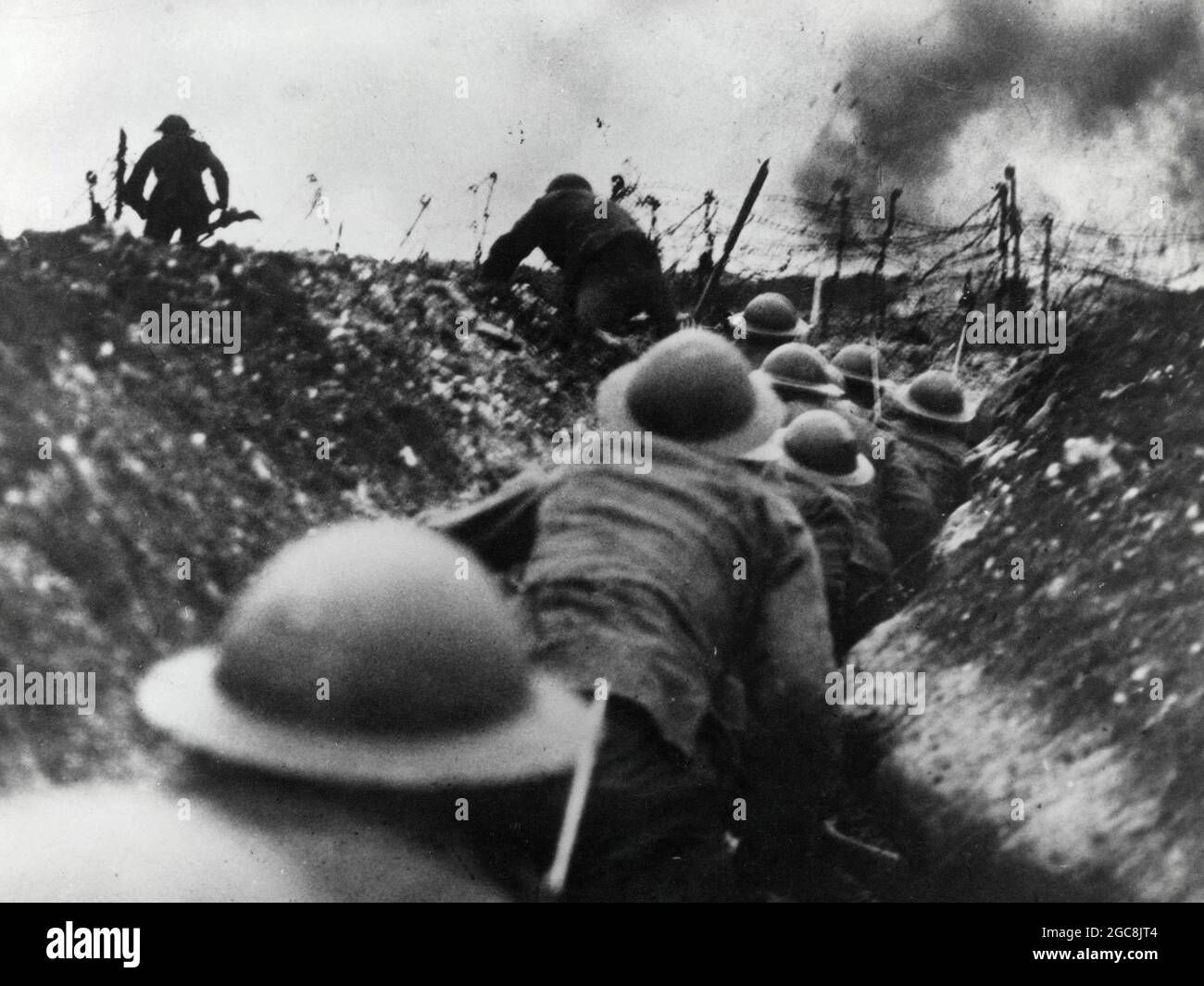 THE SOMME, FRANCE - July 1916 - British soldiers go 'over the top' from a trench during the Battle of the Somme during the First World War. The Battle Stock Photohttps://www.alamy.com/image-license-details/?v=1https://www.alamy.com/the-somme-france-july-1916-british-soldiers-go-over-the-top-from-a-trench-during-the-battle-of-the-somme-during-the-first-world-war-the-battle-image437825476.html
THE SOMME, FRANCE - July 1916 - British soldiers go 'over the top' from a trench during the Battle of the Somme during the First World War. The Battle Stock Photohttps://www.alamy.com/image-license-details/?v=1https://www.alamy.com/the-somme-france-july-1916-british-soldiers-go-over-the-top-from-a-trench-during-the-battle-of-the-somme-during-the-first-world-war-the-battle-image437825476.htmlRM2GC8JT4–THE SOMME, FRANCE - July 1916 - British soldiers go 'over the top' from a trench during the Battle of the Somme during the First World War. The Battle
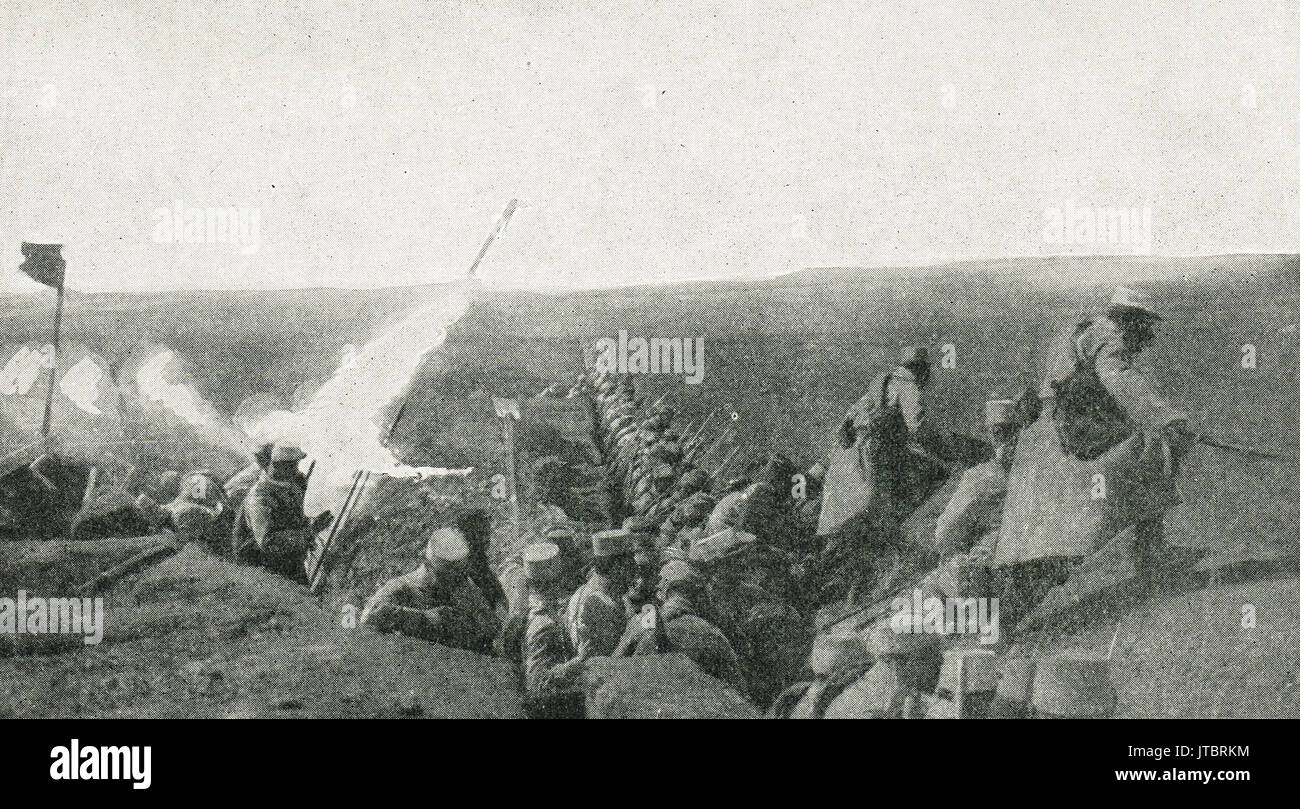 Going over the top, Bois le Pretre, 1915 Stock Photohttps://www.alamy.com/image-license-details/?v=1https://www.alamy.com/going-over-the-top-bois-le-pretre-1915-image152694744.html
Going over the top, Bois le Pretre, 1915 Stock Photohttps://www.alamy.com/image-license-details/?v=1https://www.alamy.com/going-over-the-top-bois-le-pretre-1915-image152694744.htmlRMJTBRKM–Going over the top, Bois le Pretre, 1915
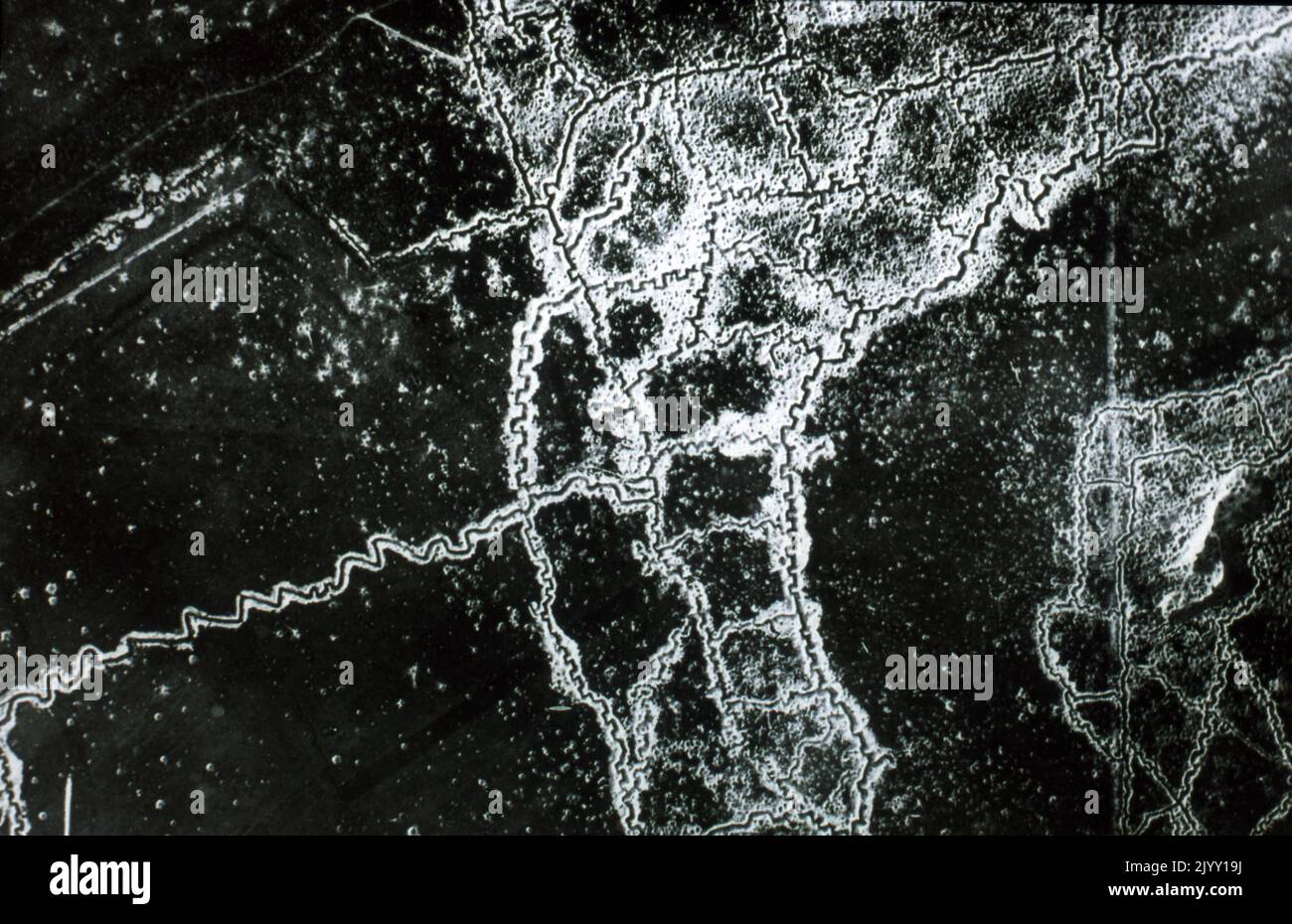 Aerial reconnaissance photograph of the opposing trenches and no-man's land between Loos and Hulluch in Artois, France, taken at 7.15 pm, 22 July 1917. German trenches are at the right and bottom, British trenches are at the top left. The vertical line to the left of centre indicates the course of a pre-war road or track. The location is Hill 70, attacked and taken between 15 and 25 August 1917 by the Canadian Corps. World War One 1919 Stock Photohttps://www.alamy.com/image-license-details/?v=1https://www.alamy.com/aerial-reconnaissance-photograph-of-the-opposing-trenches-and-no-mans-land-between-loos-and-hulluch-in-artois-france-taken-at-715-pm-22-july-1917-german-trenches-are-at-the-right-and-bottom-british-trenches-are-at-the-top-left-the-vertical-line-to-the-left-of-centre-indicates-the-course-of-a-pre-war-road-or-track-the-location-is-hill-70-attacked-and-taken-between-15-and-25-august-1917-by-the-canadian-corps-world-war-one-1919-image481869406.html
Aerial reconnaissance photograph of the opposing trenches and no-man's land between Loos and Hulluch in Artois, France, taken at 7.15 pm, 22 July 1917. German trenches are at the right and bottom, British trenches are at the top left. The vertical line to the left of centre indicates the course of a pre-war road or track. The location is Hill 70, attacked and taken between 15 and 25 August 1917 by the Canadian Corps. World War One 1919 Stock Photohttps://www.alamy.com/image-license-details/?v=1https://www.alamy.com/aerial-reconnaissance-photograph-of-the-opposing-trenches-and-no-mans-land-between-loos-and-hulluch-in-artois-france-taken-at-715-pm-22-july-1917-german-trenches-are-at-the-right-and-bottom-british-trenches-are-at-the-top-left-the-vertical-line-to-the-left-of-centre-indicates-the-course-of-a-pre-war-road-or-track-the-location-is-hill-70-attacked-and-taken-between-15-and-25-august-1917-by-the-canadian-corps-world-war-one-1919-image481869406.htmlRM2JYY19J–Aerial reconnaissance photograph of the opposing trenches and no-man's land between Loos and Hulluch in Artois, France, taken at 7.15 pm, 22 July 1917. German trenches are at the right and bottom, British trenches are at the top left. The vertical line to the left of centre indicates the course of a pre-war road or track. The location is Hill 70, attacked and taken between 15 and 25 August 1917 by the Canadian Corps. World War One 1919
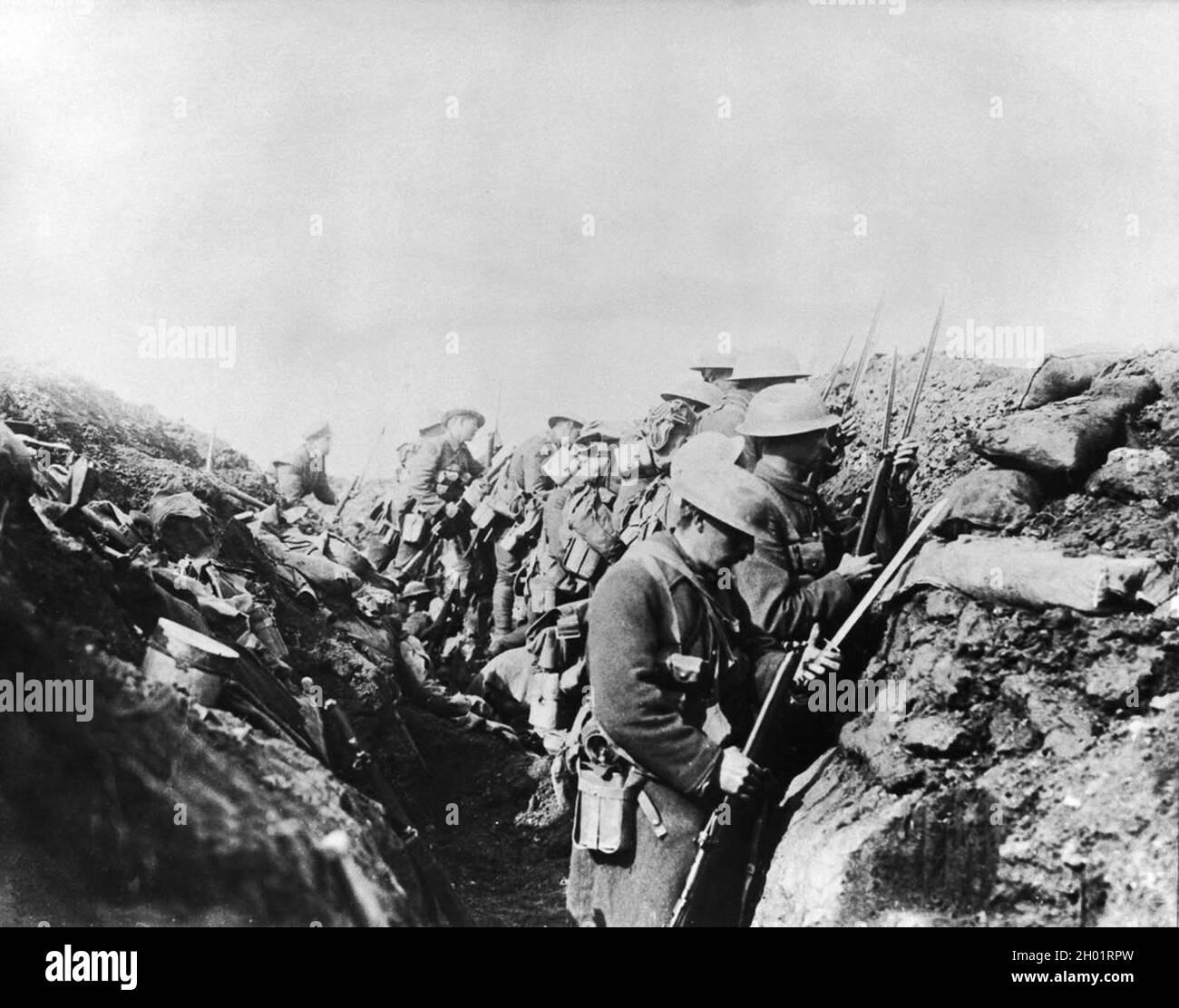 Canadian soldiers fixing bayonets before going over the top. Stock Photohttps://www.alamy.com/image-license-details/?v=1https://www.alamy.com/canadian-soldiers-fixing-bayonets-before-going-over-the-top-image447510193.html
Canadian soldiers fixing bayonets before going over the top. Stock Photohttps://www.alamy.com/image-license-details/?v=1https://www.alamy.com/canadian-soldiers-fixing-bayonets-before-going-over-the-top-image447510193.htmlRM2H01RPW–Canadian soldiers fixing bayonets before going over the top.
 A landscape view over the top of the trenches at Anzac. From a selection of printed photographs first published in 1916. The Gallipoli Campaign began during the Great War on 19 February 1915 and continued until 9 January 1916. This is sometimes referred to as the Dardanelles Campaign, The Battle of Gallipoli and the Defence of Gallipoli. Stock Photohttps://www.alamy.com/image-license-details/?v=1https://www.alamy.com/a-landscape-view-over-the-top-of-the-trenches-at-anzac-from-a-selection-of-printed-photographs-first-published-in-1916-the-gallipoli-campaign-began-during-the-great-war-on-19-february-1915-and-continued-until-9-january-1916-this-is-sometimes-referred-to-as-the-dardanelles-campaign-the-battle-of-gallipoli-and-the-defence-of-gallipoli-image626372231.html
A landscape view over the top of the trenches at Anzac. From a selection of printed photographs first published in 1916. The Gallipoli Campaign began during the Great War on 19 February 1915 and continued until 9 January 1916. This is sometimes referred to as the Dardanelles Campaign, The Battle of Gallipoli and the Defence of Gallipoli. Stock Photohttps://www.alamy.com/image-license-details/?v=1https://www.alamy.com/a-landscape-view-over-the-top-of-the-trenches-at-anzac-from-a-selection-of-printed-photographs-first-published-in-1916-the-gallipoli-campaign-began-during-the-great-war-on-19-february-1915-and-continued-until-9-january-1916-this-is-sometimes-referred-to-as-the-dardanelles-campaign-the-battle-of-gallipoli-and-the-defence-of-gallipoli-image626372231.htmlRM2YB1M4R–A landscape view over the top of the trenches at Anzac. From a selection of printed photographs first published in 1916. The Gallipoli Campaign began during the Great War on 19 February 1915 and continued until 9 January 1916. This is sometimes referred to as the Dardanelles Campaign, The Battle of Gallipoli and the Defence of Gallipoli.
 Sappers of the Royal Engineers fix scaling ladders in front line trenches during 8 April 1917, the day prior to the opening of the Arras offensive. Stock Photohttps://www.alamy.com/image-license-details/?v=1https://www.alamy.com/sappers-of-the-royal-engineers-fix-scaling-ladders-in-front-line-trenches-during-8-april-1917-the-day-prior-to-the-opening-of-the-arras-offensive-image463471228.html
Sappers of the Royal Engineers fix scaling ladders in front line trenches during 8 April 1917, the day prior to the opening of the Arras offensive. Stock Photohttps://www.alamy.com/image-license-details/?v=1https://www.alamy.com/sappers-of-the-royal-engineers-fix-scaling-ladders-in-front-line-trenches-during-8-april-1917-the-day-prior-to-the-opening-of-the-arras-offensive-image463471228.htmlRM2HX0X7T–Sappers of the Royal Engineers fix scaling ladders in front line trenches during 8 April 1917, the day prior to the opening of the Arras offensive.
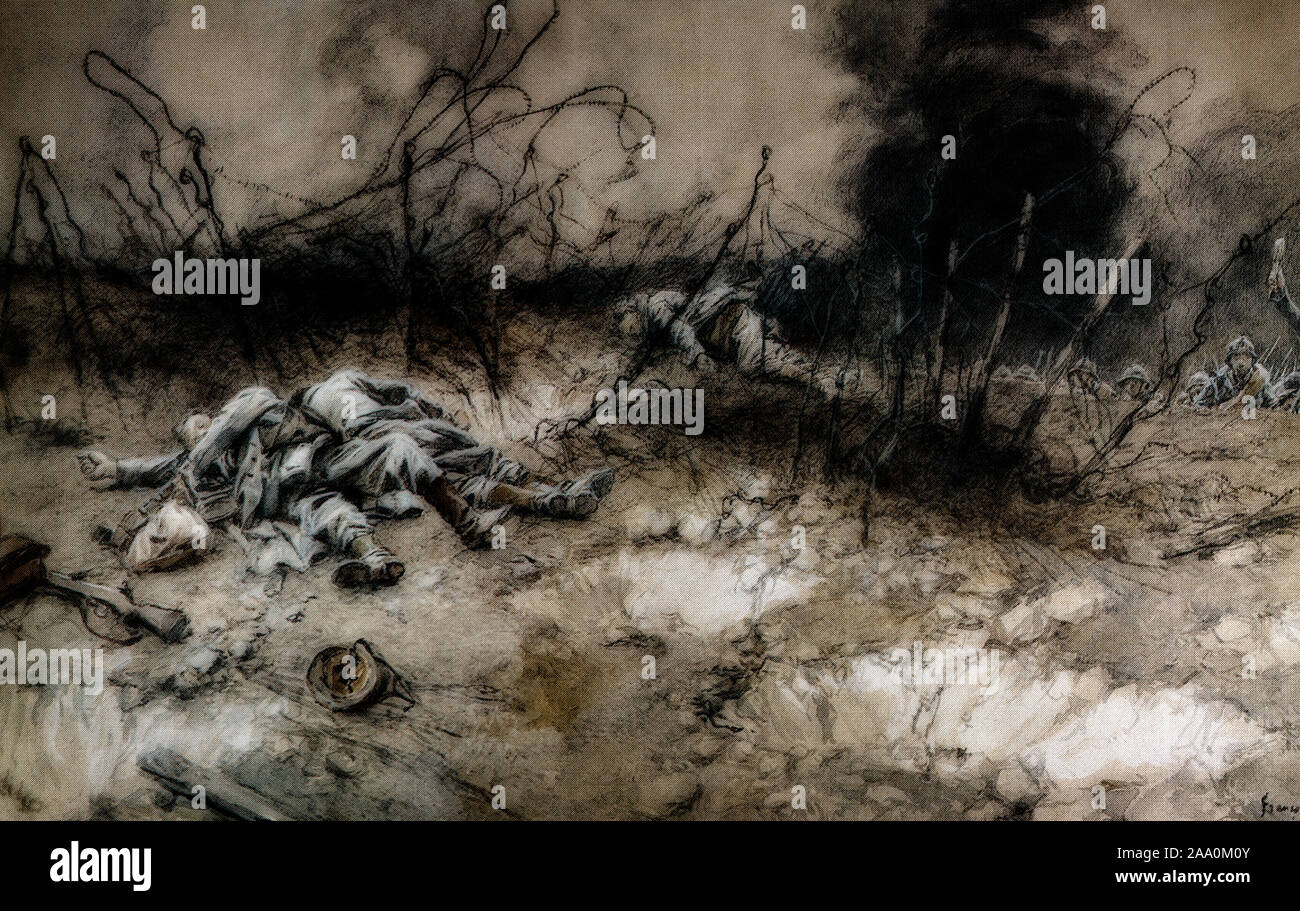 1917, and French soldiers prepare to leave their trench and go 'over the top', through coils of barbed wire, passing their fallen comrades as they attack the German lines during World War One. Painting by François Fleming Stock Photohttps://www.alamy.com/image-license-details/?v=1https://www.alamy.com/1917-and-french-soldiers-prepare-to-leave-their-trench-and-go-over-the-top-through-coils-of-barbed-wire-passing-their-fallen-comrades-as-they-attack-the-german-lines-during-world-war-one-painting-by-franois-fleming-image333159259.html
1917, and French soldiers prepare to leave their trench and go 'over the top', through coils of barbed wire, passing their fallen comrades as they attack the German lines during World War One. Painting by François Fleming Stock Photohttps://www.alamy.com/image-license-details/?v=1https://www.alamy.com/1917-and-french-soldiers-prepare-to-leave-their-trench-and-go-over-the-top-through-coils-of-barbed-wire-passing-their-fallen-comrades-as-they-attack-the-german-lines-during-world-war-one-painting-by-franois-fleming-image333159259.htmlRM2AA0M0Y–1917, and French soldiers prepare to leave their trench and go 'over the top', through coils of barbed wire, passing their fallen comrades as they attack the German lines during World War One. Painting by François Fleming
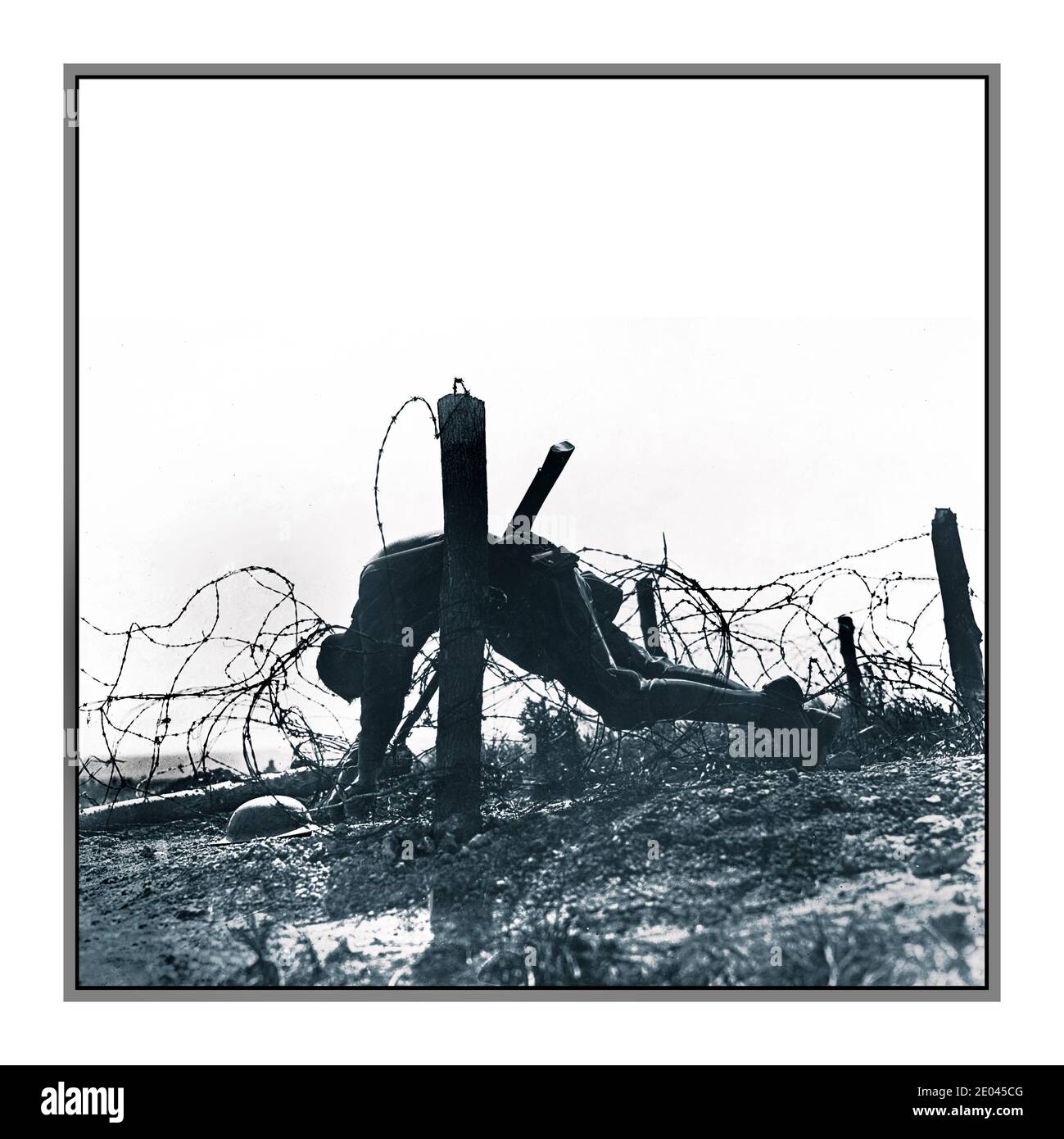 WW1 Soldier lies dead “In the wire” Stark Battlefield graphic poignant reminder of the horrors of war. American soldier caught on German barbed wire fence Western Front France. The Meuse–Argonne offensive (also known as the Meuse River–Argonne Forest offensive, the Battles of the Meuse–Argonne, and the Meuse–Argonne campaign) was a major part of the final Allied offensive of World War I that stretched along the entire Western Front .Powell, Eyre, 1891-1949, photographer 1918 - World War, 1914-1918--Casualties--American--France - Soldiers--American--France--1910-1920 alt version 2E045CX Stock Photohttps://www.alamy.com/image-license-details/?v=1https://www.alamy.com/ww1-soldier-lies-dead-in-the-wire-stark-battlefield-graphic-poignant-reminder-of-the-horrors-of-war-american-soldier-caught-on-german-barbed-wire-fence-western-front-france-the-meuseargonne-offensive-also-known-as-the-meuse-riverargonne-forest-offensive-the-battles-of-the-meuseargonne-and-the-meuseargonne-campaign-was-a-major-part-of-the-final-allied-offensive-of-world-war-i-that-stretched-along-the-entire-western-front-powell-eyre-1891-1949-photographer-1918-world-war-1914-1918-casualties-american-france-soldiers-american-france-1910-1920-alt-version-2e045cx-image395930544.html
WW1 Soldier lies dead “In the wire” Stark Battlefield graphic poignant reminder of the horrors of war. American soldier caught on German barbed wire fence Western Front France. The Meuse–Argonne offensive (also known as the Meuse River–Argonne Forest offensive, the Battles of the Meuse–Argonne, and the Meuse–Argonne campaign) was a major part of the final Allied offensive of World War I that stretched along the entire Western Front .Powell, Eyre, 1891-1949, photographer 1918 - World War, 1914-1918--Casualties--American--France - Soldiers--American--France--1910-1920 alt version 2E045CX Stock Photohttps://www.alamy.com/image-license-details/?v=1https://www.alamy.com/ww1-soldier-lies-dead-in-the-wire-stark-battlefield-graphic-poignant-reminder-of-the-horrors-of-war-american-soldier-caught-on-german-barbed-wire-fence-western-front-france-the-meuseargonne-offensive-also-known-as-the-meuse-riverargonne-forest-offensive-the-battles-of-the-meuseargonne-and-the-meuseargonne-campaign-was-a-major-part-of-the-final-allied-offensive-of-world-war-i-that-stretched-along-the-entire-western-front-powell-eyre-1891-1949-photographer-1918-world-war-1914-1918-casualties-american-france-soldiers-american-france-1910-1920-alt-version-2e045cx-image395930544.htmlRM2E045CG–WW1 Soldier lies dead “In the wire” Stark Battlefield graphic poignant reminder of the horrors of war. American soldier caught on German barbed wire fence Western Front France. The Meuse–Argonne offensive (also known as the Meuse River–Argonne Forest offensive, the Battles of the Meuse–Argonne, and the Meuse–Argonne campaign) was a major part of the final Allied offensive of World War I that stretched along the entire Western Front .Powell, Eyre, 1891-1949, photographer 1918 - World War, 1914-1918--Casualties--American--France - Soldiers--American--France--1910-1920 alt version 2E045CX
 Worlds greatest foresters. Forest Academy of Korkeakoski 1939 digging trenches and tank traps One of the students of the Academy digging trank traps, ditches some 6 feet wide at the top in the swamp ground on the borders of forests. From a series These Men Built the Mannerheim Line - the Finnish zone of frontier fortifications was designed and constructed entirely by the Finnish people. Finnish engineers began work on the line in 1937 but it was not until this summer in 1939 that the work was speeded up and completed. Then, conscious of the dangers of a weak frontier, Finnish young men and stu Stock Photohttps://www.alamy.com/image-license-details/?v=1https://www.alamy.com/worlds-greatest-foresters-forest-academy-of-korkeakoski-1939-digging-trenches-and-tank-traps-one-of-the-students-of-the-academy-digging-trank-traps-ditches-some-6-feet-wide-at-the-top-in-the-swamp-ground-on-the-borders-of-forests-from-a-series-these-men-built-the-mannerheim-line-the-finnish-zone-of-frontier-fortifications-was-designed-and-constructed-entirely-by-the-finnish-people-finnish-engineers-began-work-on-the-line-in-1937-but-it-was-not-until-this-summer-in-1939-that-the-work-was-speeded-up-and-completed-then-conscious-of-the-dangers-of-a-weak-frontier-finnish-young-men-and-stu-image359460116.html
Worlds greatest foresters. Forest Academy of Korkeakoski 1939 digging trenches and tank traps One of the students of the Academy digging trank traps, ditches some 6 feet wide at the top in the swamp ground on the borders of forests. From a series These Men Built the Mannerheim Line - the Finnish zone of frontier fortifications was designed and constructed entirely by the Finnish people. Finnish engineers began work on the line in 1937 but it was not until this summer in 1939 that the work was speeded up and completed. Then, conscious of the dangers of a weak frontier, Finnish young men and stu Stock Photohttps://www.alamy.com/image-license-details/?v=1https://www.alamy.com/worlds-greatest-foresters-forest-academy-of-korkeakoski-1939-digging-trenches-and-tank-traps-one-of-the-students-of-the-academy-digging-trank-traps-ditches-some-6-feet-wide-at-the-top-in-the-swamp-ground-on-the-borders-of-forests-from-a-series-these-men-built-the-mannerheim-line-the-finnish-zone-of-frontier-fortifications-was-designed-and-constructed-entirely-by-the-finnish-people-finnish-engineers-began-work-on-the-line-in-1937-but-it-was-not-until-this-summer-in-1939-that-the-work-was-speeded-up-and-completed-then-conscious-of-the-dangers-of-a-weak-frontier-finnish-young-men-and-stu-image359460116.htmlRM2BTPR18–Worlds greatest foresters. Forest Academy of Korkeakoski 1939 digging trenches and tank traps One of the students of the Academy digging trank traps, ditches some 6 feet wide at the top in the swamp ground on the borders of forests. From a series These Men Built the Mannerheim Line - the Finnish zone of frontier fortifications was designed and constructed entirely by the Finnish people. Finnish engineers began work on the line in 1937 but it was not until this summer in 1939 that the work was speeded up and completed. Then, conscious of the dangers of a weak frontier, Finnish young men and stu
![WESTERN FRONT over the top WW1 Soldier lies ‘IN THE WIRE’ dead dying trapped in German battlefield barbed wire at dramatic sunset. Stark sad poignant reminder of the horrors of First World War. American soldier caught on barbed wire barrier in France. Meuse–Argonne offensive a major part of the final Allied offensive of World War I that stretched along the entire Western Front . Powell, Eyre, 1891-1949, photographer [1918] World War, 1914-1918--Casualties--American--France Soldiers--1910-1920 *This image has been carefully restored and enhanced to re-create its original impact and quality.* Stock Photo WESTERN FRONT over the top WW1 Soldier lies ‘IN THE WIRE’ dead dying trapped in German battlefield barbed wire at dramatic sunset. Stark sad poignant reminder of the horrors of First World War. American soldier caught on barbed wire barrier in France. Meuse–Argonne offensive a major part of the final Allied offensive of World War I that stretched along the entire Western Front . Powell, Eyre, 1891-1949, photographer [1918] World War, 1914-1918--Casualties--American--France Soldiers--1910-1920 *This image has been carefully restored and enhanced to re-create its original impact and quality.* Stock Photo](https://c8.alamy.com/comp/2E045CX/western-front-over-the-top-ww1-soldier-lies-in-the-wire-dead-dying-trapped-in-german-battlefield-barbed-wire-at-dramatic-sunset-stark-sad-poignant-reminder-of-the-horrors-of-first-world-war-american-soldier-caught-on-barbed-wire-barrier-in-france-meuseargonne-offensive-a-major-part-of-the-final-allied-offensive-of-world-war-i-that-stretched-along-the-entire-western-front-powell-eyre-1891-1949-photographer-1918-world-war-1914-1918-casualties-american-france-soldiers-1910-1920-this-image-has-been-carefully-restored-and-enhanced-to-re-create-its-original-impact-and-quality-2E045CX.jpg) WESTERN FRONT over the top WW1 Soldier lies ‘IN THE WIRE’ dead dying trapped in German battlefield barbed wire at dramatic sunset. Stark sad poignant reminder of the horrors of First World War. American soldier caught on barbed wire barrier in France. Meuse–Argonne offensive a major part of the final Allied offensive of World War I that stretched along the entire Western Front . Powell, Eyre, 1891-1949, photographer [1918] World War, 1914-1918--Casualties--American--France Soldiers--1910-1920 *This image has been carefully restored and enhanced to re-create its original impact and quality.* Stock Photohttps://www.alamy.com/image-license-details/?v=1https://www.alamy.com/western-front-over-the-top-ww1-soldier-lies-in-the-wire-dead-dying-trapped-in-german-battlefield-barbed-wire-at-dramatic-sunset-stark-sad-poignant-reminder-of-the-horrors-of-first-world-war-american-soldier-caught-on-barbed-wire-barrier-in-france-meuseargonne-offensive-a-major-part-of-the-final-allied-offensive-of-world-war-i-that-stretched-along-the-entire-western-front-powell-eyre-1891-1949-photographer-1918-world-war-1914-1918-casualties-american-france-soldiers-1910-1920-this-image-has-been-carefully-restored-and-enhanced-to-re-create-its-original-impact-and-quality-image395930554.html
WESTERN FRONT over the top WW1 Soldier lies ‘IN THE WIRE’ dead dying trapped in German battlefield barbed wire at dramatic sunset. Stark sad poignant reminder of the horrors of First World War. American soldier caught on barbed wire barrier in France. Meuse–Argonne offensive a major part of the final Allied offensive of World War I that stretched along the entire Western Front . Powell, Eyre, 1891-1949, photographer [1918] World War, 1914-1918--Casualties--American--France Soldiers--1910-1920 *This image has been carefully restored and enhanced to re-create its original impact and quality.* Stock Photohttps://www.alamy.com/image-license-details/?v=1https://www.alamy.com/western-front-over-the-top-ww1-soldier-lies-in-the-wire-dead-dying-trapped-in-german-battlefield-barbed-wire-at-dramatic-sunset-stark-sad-poignant-reminder-of-the-horrors-of-first-world-war-american-soldier-caught-on-barbed-wire-barrier-in-france-meuseargonne-offensive-a-major-part-of-the-final-allied-offensive-of-world-war-i-that-stretched-along-the-entire-western-front-powell-eyre-1891-1949-photographer-1918-world-war-1914-1918-casualties-american-france-soldiers-1910-1920-this-image-has-been-carefully-restored-and-enhanced-to-re-create-its-original-impact-and-quality-image395930554.htmlRM2E045CX–WESTERN FRONT over the top WW1 Soldier lies ‘IN THE WIRE’ dead dying trapped in German battlefield barbed wire at dramatic sunset. Stark sad poignant reminder of the horrors of First World War. American soldier caught on barbed wire barrier in France. Meuse–Argonne offensive a major part of the final Allied offensive of World War I that stretched along the entire Western Front . Powell, Eyre, 1891-1949, photographer [1918] World War, 1914-1918--Casualties--American--France Soldiers--1910-1920 *This image has been carefully restored and enhanced to re-create its original impact and quality.*
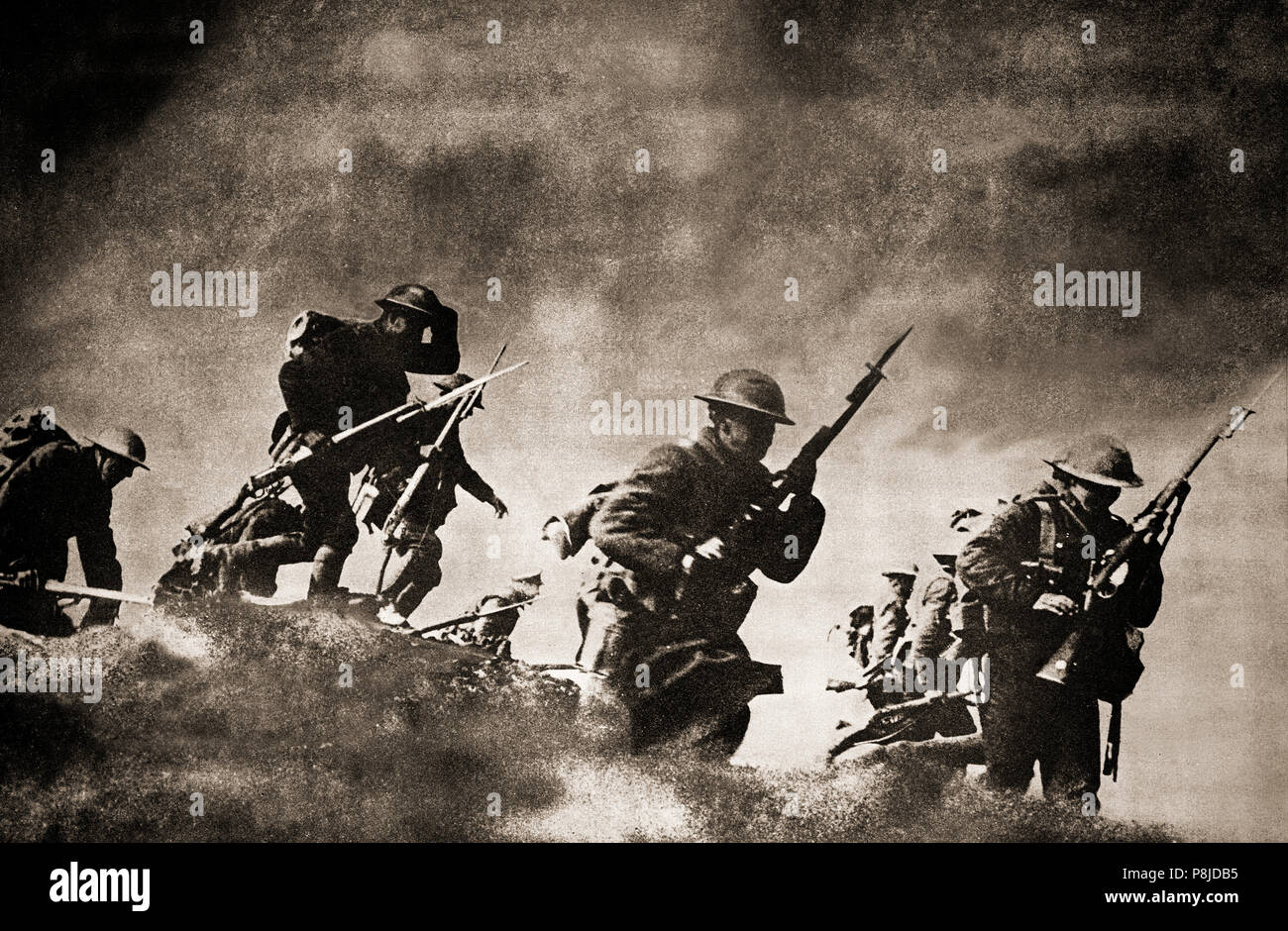 British soldiers going 'over the top' when they emerged from trenches and charged out over open land to attack the enemy. Soldiers did not look forward this moment, and certainly many of them must have regarded it as foolhardy and dangerous. Trench warfare was a type of land warfare using occupied fighting lines consisting largely of military trenches, in which troops are well-protected from the enemy's small arms fire and are substantially sheltered from artillery. The most famous use of trench warfare was the Western Front in World War I. Stock Photohttps://www.alamy.com/image-license-details/?v=1https://www.alamy.com/british-soldiers-going-over-the-top-when-they-emerged-from-trenches-and-charged-out-over-open-land-to-attack-the-enemy-soldiers-did-not-look-forward-this-moment-and-certainly-many-of-them-must-have-regarded-it-as-foolhardy-and-dangerous-trench-warfare-was-a-type-of-land-warfare-using-occupied-fighting-lines-consisting-largely-of-military-trenches-in-which-troops-are-well-protected-from-the-enemys-small-arms-fire-and-are-substantially-sheltered-from-artillery-the-most-famous-use-of-trench-warfare-was-the-western-front-in-world-war-i-image211847305.html
British soldiers going 'over the top' when they emerged from trenches and charged out over open land to attack the enemy. Soldiers did not look forward this moment, and certainly many of them must have regarded it as foolhardy and dangerous. Trench warfare was a type of land warfare using occupied fighting lines consisting largely of military trenches, in which troops are well-protected from the enemy's small arms fire and are substantially sheltered from artillery. The most famous use of trench warfare was the Western Front in World War I. Stock Photohttps://www.alamy.com/image-license-details/?v=1https://www.alamy.com/british-soldiers-going-over-the-top-when-they-emerged-from-trenches-and-charged-out-over-open-land-to-attack-the-enemy-soldiers-did-not-look-forward-this-moment-and-certainly-many-of-them-must-have-regarded-it-as-foolhardy-and-dangerous-trench-warfare-was-a-type-of-land-warfare-using-occupied-fighting-lines-consisting-largely-of-military-trenches-in-which-troops-are-well-protected-from-the-enemys-small-arms-fire-and-are-substantially-sheltered-from-artillery-the-most-famous-use-of-trench-warfare-was-the-western-front-in-world-war-i-image211847305.htmlRMP8JDB5–British soldiers going 'over the top' when they emerged from trenches and charged out over open land to attack the enemy. Soldiers did not look forward this moment, and certainly many of them must have regarded it as foolhardy and dangerous. Trench warfare was a type of land warfare using occupied fighting lines consisting largely of military trenches, in which troops are well-protected from the enemy's small arms fire and are substantially sheltered from artillery. The most famous use of trench warfare was the Western Front in World War I.
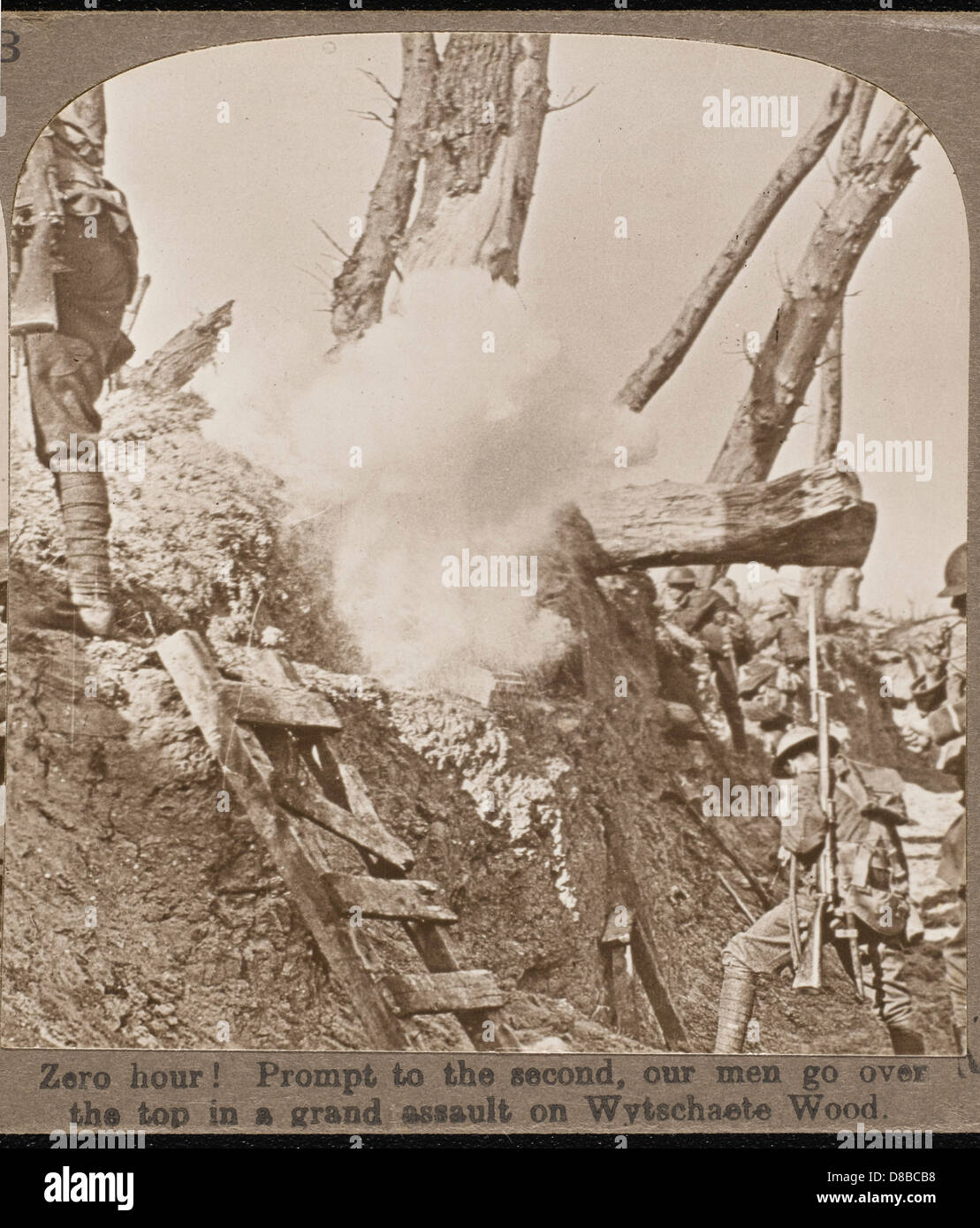 INFANTRY GO OVER THE TOP Stock Photohttps://www.alamy.com/image-license-details/?v=1https://www.alamy.com/stock-photo-infantry-go-over-the-top-56799548.html
INFANTRY GO OVER THE TOP Stock Photohttps://www.alamy.com/image-license-details/?v=1https://www.alamy.com/stock-photo-infantry-go-over-the-top-56799548.htmlRMD8BCB8–INFANTRY GO OVER THE TOP
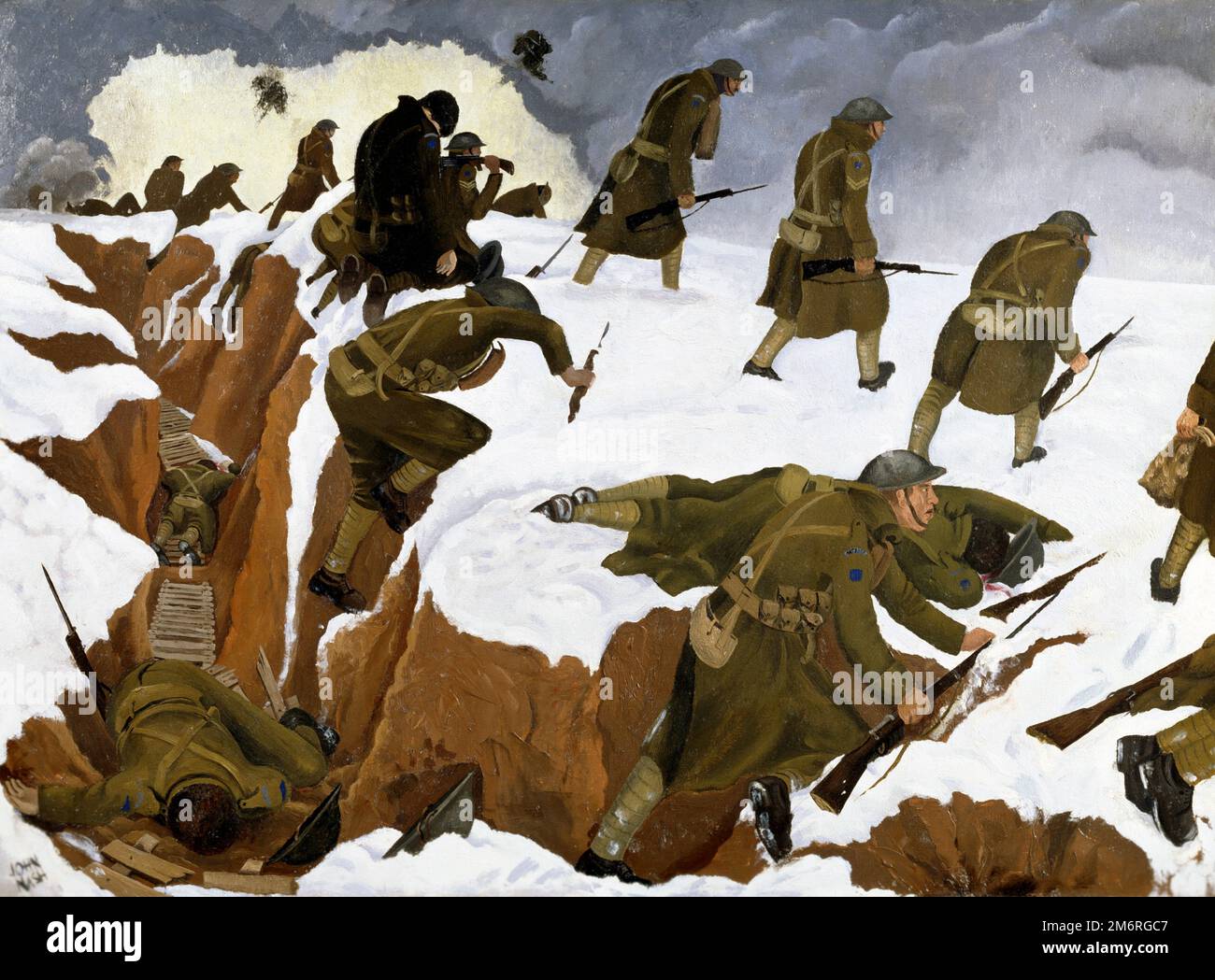 John Nash. Painting entitled 'Over The Top'. 1st Artists' Rifles at Marcoing, 30th December 1917' by John Northcote Nash (1893-1977), oil, 1918 Stock Photohttps://www.alamy.com/image-license-details/?v=1https://www.alamy.com/john-nash-painting-entitled-over-the-top-1st-artists-rifles-at-marcoing-30th-december-1917-by-john-northcote-nash-1893-1977-oil-1918-image503306391.html
John Nash. Painting entitled 'Over The Top'. 1st Artists' Rifles at Marcoing, 30th December 1917' by John Northcote Nash (1893-1977), oil, 1918 Stock Photohttps://www.alamy.com/image-license-details/?v=1https://www.alamy.com/john-nash-painting-entitled-over-the-top-1st-artists-rifles-at-marcoing-30th-december-1917-by-john-northcote-nash-1893-1977-oil-1918-image503306391.htmlRM2M6RGC7–John Nash. Painting entitled 'Over The Top'. 1st Artists' Rifles at Marcoing, 30th December 1917' by John Northcote Nash (1893-1977), oil, 1918
 View along trenches, Russell's Top, Gallipoli, Turkey, 1915 Stock Photohttps://www.alamy.com/image-license-details/?v=1https://www.alamy.com/view-along-trenches-russells-top-gallipoli-turkey-1915-image573407338.html
View along trenches, Russell's Top, Gallipoli, Turkey, 1915 Stock Photohttps://www.alamy.com/image-license-details/?v=1https://www.alamy.com/view-along-trenches-russells-top-gallipoli-turkey-1915-image573407338.htmlRM2T8TXWE–View along trenches, Russell's Top, Gallipoli, Turkey, 1915
 Turkish troops emerging from trenches, Palestine, WW1 Stock Photohttps://www.alamy.com/image-license-details/?v=1https://www.alamy.com/turkish-troops-emerging-from-trenches-palestine-ww1-image66158904.html
Turkish troops emerging from trenches, Palestine, WW1 Stock Photohttps://www.alamy.com/image-license-details/?v=1https://www.alamy.com/turkish-troops-emerging-from-trenches-palestine-ww1-image66158904.htmlRMDRHPA0–Turkish troops emerging from trenches, Palestine, WW1
 OVER THE TOP Poster for 1918 Vitagraph film with Arthur Empey Stock Photohttps://www.alamy.com/image-license-details/?v=1https://www.alamy.com/stock-photo-over-the-top-poster-for-1918-vitagraph-film-with-arthur-empey-48081298.html
OVER THE TOP Poster for 1918 Vitagraph film with Arthur Empey Stock Photohttps://www.alamy.com/image-license-details/?v=1https://www.alamy.com/stock-photo-over-the-top-poster-for-1918-vitagraph-film-with-arthur-empey-48081298.htmlRMCP6856–OVER THE TOP Poster for 1918 Vitagraph film with Arthur Empey
 1916 'trench' whistle, by Hudson and Co, Birmingham. This would have been used by an officer to signal his troops to go 'over the top'. Stock Photohttps://www.alamy.com/image-license-details/?v=1https://www.alamy.com/stock-image-1916-trench-whistle-by-hudson-and-co-birmingham-this-would-have-been-160637450.html
1916 'trench' whistle, by Hudson and Co, Birmingham. This would have been used by an officer to signal his troops to go 'over the top'. Stock Photohttps://www.alamy.com/image-license-details/?v=1https://www.alamy.com/stock-image-1916-trench-whistle-by-hudson-and-co-birmingham-this-would-have-been-160637450.htmlRMK99JKP–1916 'trench' whistle, by Hudson and Co, Birmingham. This would have been used by an officer to signal his troops to go 'over the top'.
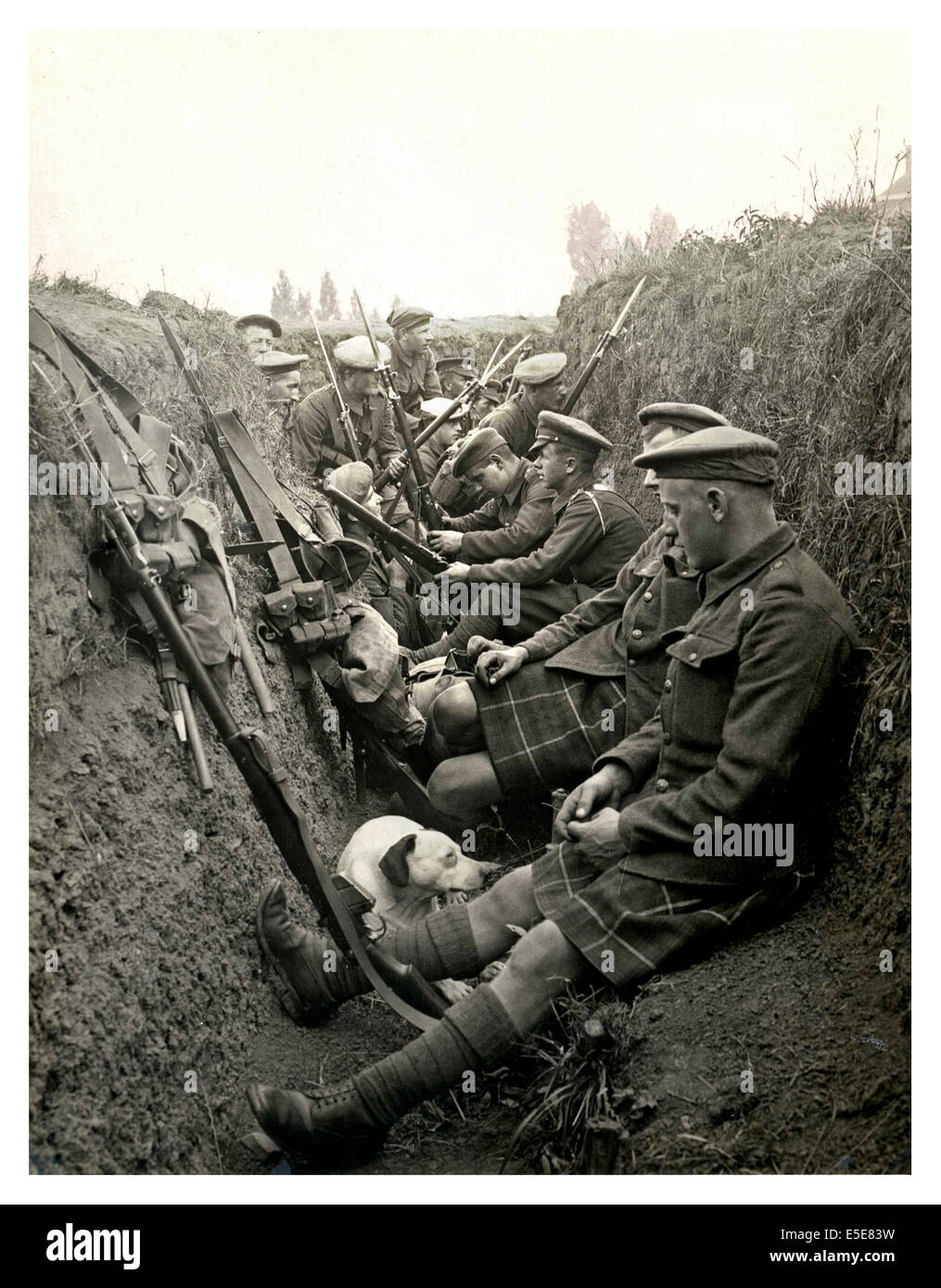 Historic image of WW1 Highland territorials and their mascot dog wait to 'go over the top' in a trench in Northern France Stock Photohttps://www.alamy.com/image-license-details/?v=1https://www.alamy.com/stock-photo-historic-image-of-ww1-highland-territorials-and-their-mascot-dog-wait-72228461.html
Historic image of WW1 Highland territorials and their mascot dog wait to 'go over the top' in a trench in Northern France Stock Photohttps://www.alamy.com/image-license-details/?v=1https://www.alamy.com/stock-photo-historic-image-of-ww1-highland-territorials-and-their-mascot-dog-wait-72228461.htmlRME5E83W–Historic image of WW1 Highland territorials and their mascot dog wait to 'go over the top' in a trench in Northern France
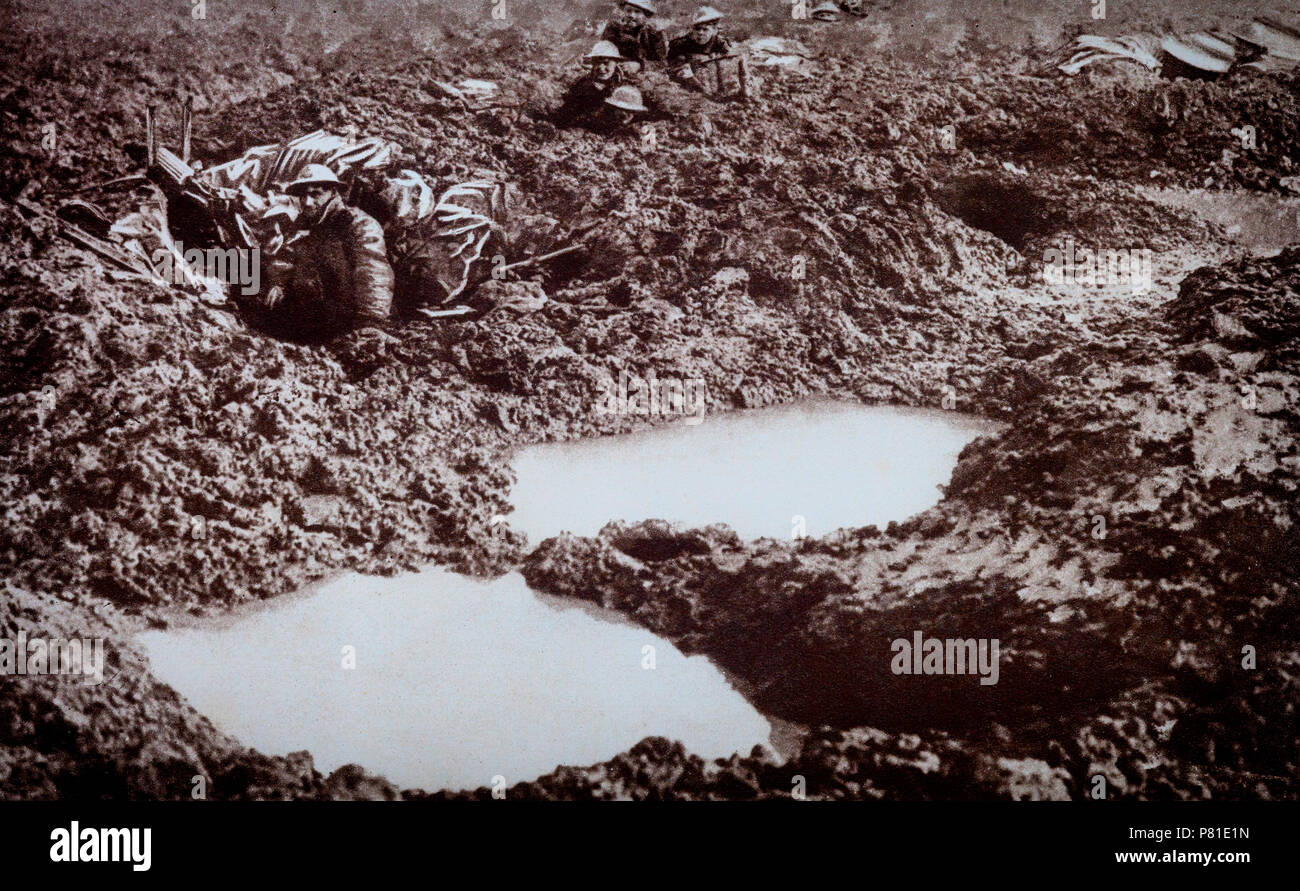 Shocking casualty rates suffered by troops on all sides who were sent “over the top”, during trench warfare but also due to the often horrific conditions the men endured whilst living in the trenches. Aside from the danger of enemy attacks, soldiers in the trenches faced other challenges. Trenches frequently became waterlogged and particularly heavy storms could lead to flooding. On the Western Front in the winter of 1915 the trenches became so wet that in one sector German soldiers reportedly began sitting on top of the trench walls just to dry off and avoid such nasty ailments. Stock Photohttps://www.alamy.com/image-license-details/?v=1https://www.alamy.com/shocking-casualty-rates-suffered-by-troops-on-all-sides-who-were-sent-over-the-top-during-trench-warfare-but-also-due-to-the-often-horrific-conditions-the-men-endured-whilst-living-in-the-trenches-aside-from-the-danger-of-enemy-attacks-soldiers-in-the-trenches-faced-other-challenges-trenches-frequently-became-waterlogged-and-particularly-heavy-storms-could-lead-to-flooding-on-the-western-front-in-the-winter-of-1915-the-trenches-became-so-wet-that-in-one-sector-german-soldiers-reportedly-began-sitting-on-top-of-the-trench-walls-just-to-dry-off-and-avoid-such-nasty-ailments-image211474641.html
Shocking casualty rates suffered by troops on all sides who were sent “over the top”, during trench warfare but also due to the often horrific conditions the men endured whilst living in the trenches. Aside from the danger of enemy attacks, soldiers in the trenches faced other challenges. Trenches frequently became waterlogged and particularly heavy storms could lead to flooding. On the Western Front in the winter of 1915 the trenches became so wet that in one sector German soldiers reportedly began sitting on top of the trench walls just to dry off and avoid such nasty ailments. Stock Photohttps://www.alamy.com/image-license-details/?v=1https://www.alamy.com/shocking-casualty-rates-suffered-by-troops-on-all-sides-who-were-sent-over-the-top-during-trench-warfare-but-also-due-to-the-often-horrific-conditions-the-men-endured-whilst-living-in-the-trenches-aside-from-the-danger-of-enemy-attacks-soldiers-in-the-trenches-faced-other-challenges-trenches-frequently-became-waterlogged-and-particularly-heavy-storms-could-lead-to-flooding-on-the-western-front-in-the-winter-of-1915-the-trenches-became-so-wet-that-in-one-sector-german-soldiers-reportedly-began-sitting-on-top-of-the-trench-walls-just-to-dry-off-and-avoid-such-nasty-ailments-image211474641.htmlRMP81E1N–Shocking casualty rates suffered by troops on all sides who were sent “over the top”, during trench warfare but also due to the often horrific conditions the men endured whilst living in the trenches. Aside from the danger of enemy attacks, soldiers in the trenches faced other challenges. Trenches frequently became waterlogged and particularly heavy storms could lead to flooding. On the Western Front in the winter of 1915 the trenches became so wet that in one sector German soldiers reportedly began sitting on top of the trench walls just to dry off and avoid such nasty ailments.
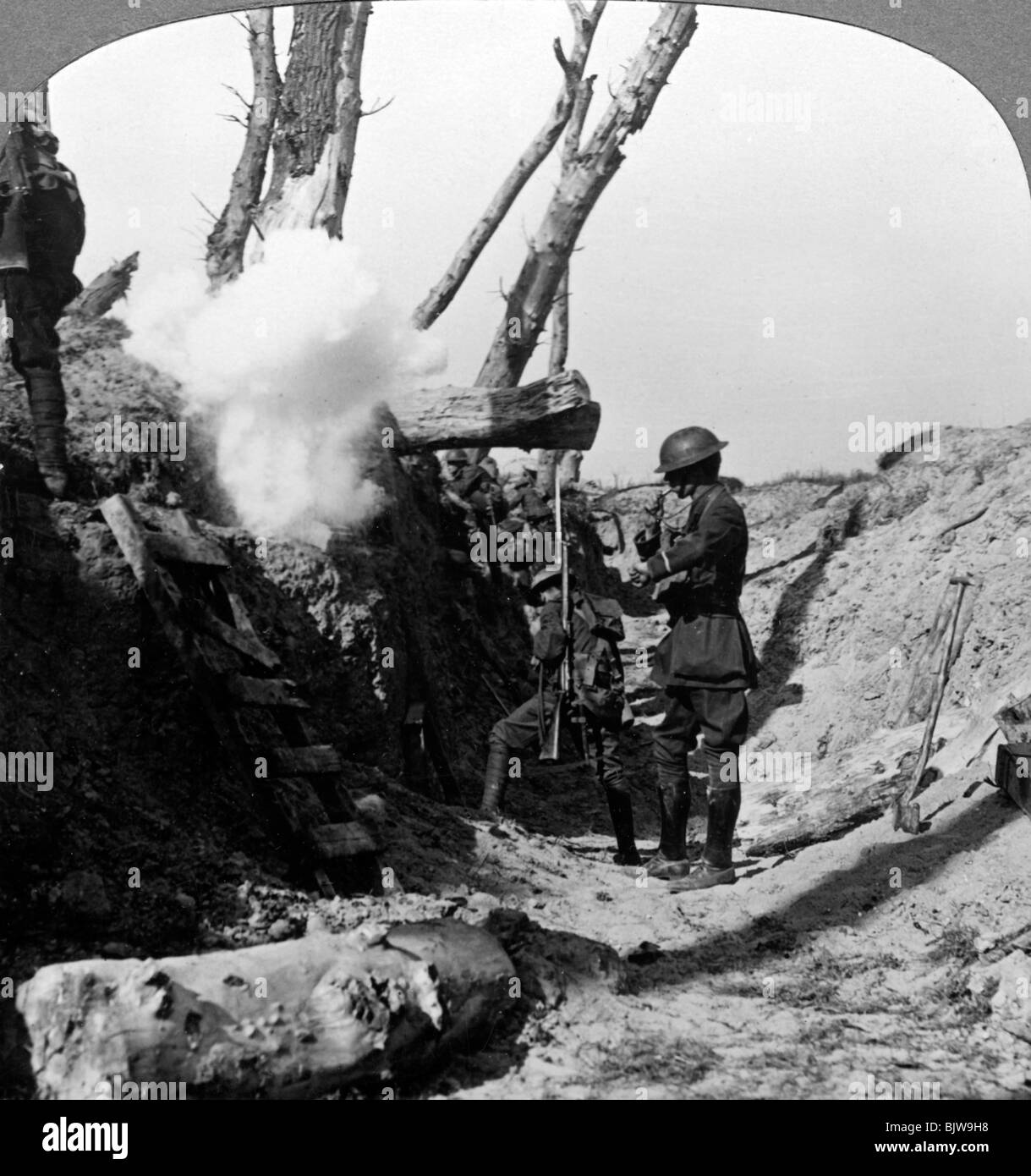 Soldiers waiting in the trenches to go over the top, World War I, 1914-1918.Artist: Realistic Travels Publishers Stock Photohttps://www.alamy.com/image-license-details/?v=1https://www.alamy.com/stock-photo-soldiers-waiting-in-the-trenches-to-go-over-the-top-world-war-i-1914-28830516.html
Soldiers waiting in the trenches to go over the top, World War I, 1914-1918.Artist: Realistic Travels Publishers Stock Photohttps://www.alamy.com/image-license-details/?v=1https://www.alamy.com/stock-photo-soldiers-waiting-in-the-trenches-to-go-over-the-top-world-war-i-1914-28830516.htmlRMBJW9H8–Soldiers waiting in the trenches to go over the top, World War I, 1914-1918.Artist: Realistic Travels Publishers
 French Army using a periscope in the trenches, WW 1, 1915 Stock Photohttps://www.alamy.com/image-license-details/?v=1https://www.alamy.com/stock-photo-french-army-using-a-periscope-in-the-trenches-ww-1-1915-146625672.html
French Army using a periscope in the trenches, WW 1, 1915 Stock Photohttps://www.alamy.com/image-license-details/?v=1https://www.alamy.com/stock-photo-french-army-using-a-periscope-in-the-trenches-ww-1-1915-146625672.htmlRMJEFAF4–French Army using a periscope in the trenches, WW 1, 1915
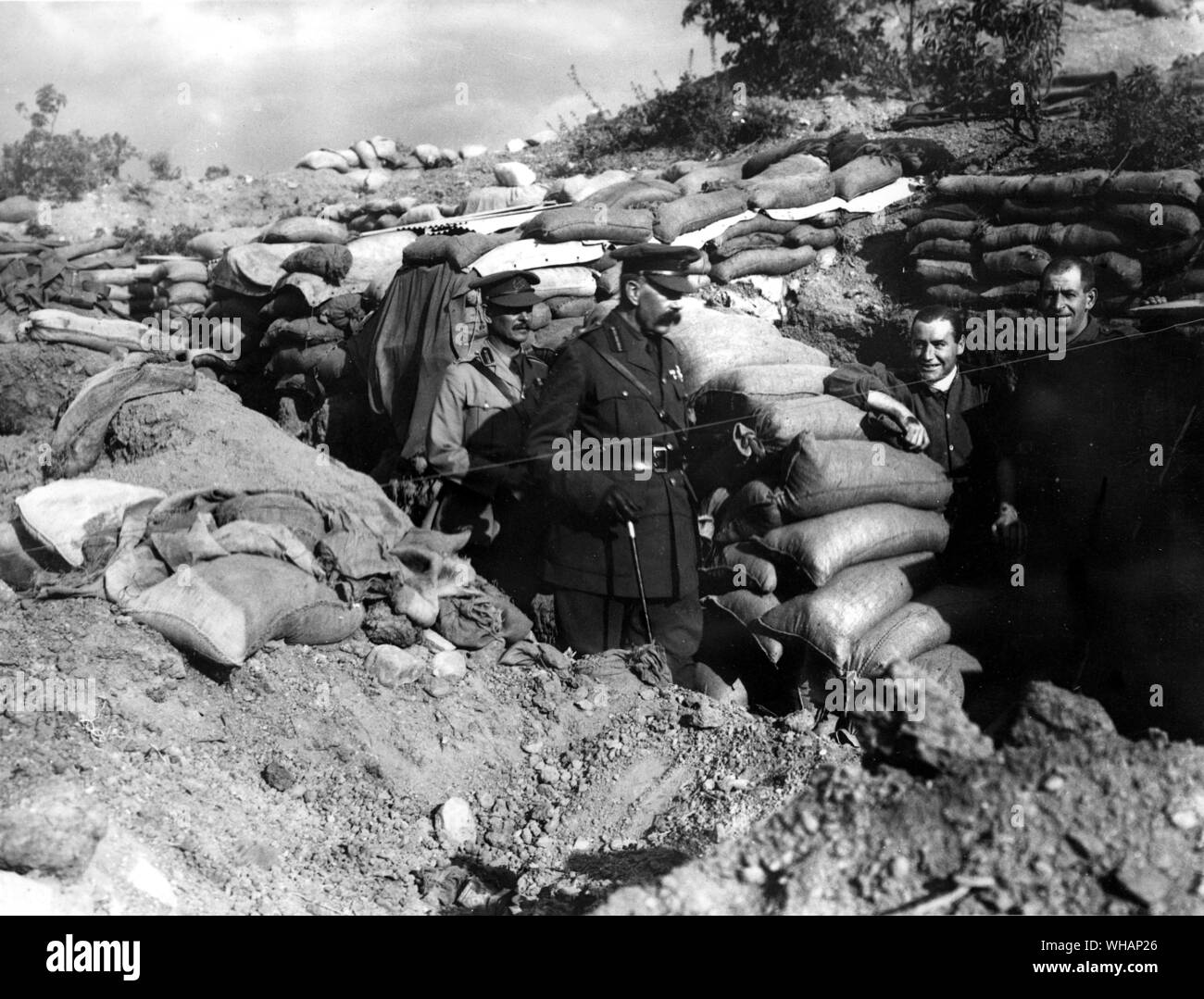 Lord Kitchener at Anzac, 13th November 1915, returning through trenches to the beach from Russell's Top & Bully Beef Sap.. With him is General Birdwood. . . Kitchener, Horatio Herbert British general in Boer War, Sudan, and World War I. won battle of Khartoum 1898. 1st Anglo-Egyptian governor-general of Sudan 1898-1899 1850-1916 . . Stock Photohttps://www.alamy.com/image-license-details/?v=1https://www.alamy.com/lord-kitchener-at-anzac-13th-november-1915-returning-through-trenches-to-the-beach-from-russells-top-bully-beef-sap-with-him-is-general-birdwood-kitchener-horatio-herbert-british-general-in-boer-war-sudan-and-world-war-i-won-battle-of-khartoum-1898-1st-anglo-egyptian-governor-general-of-sudan-1898-1899-1850-1916-image268841502.html
Lord Kitchener at Anzac, 13th November 1915, returning through trenches to the beach from Russell's Top & Bully Beef Sap.. With him is General Birdwood. . . Kitchener, Horatio Herbert British general in Boer War, Sudan, and World War I. won battle of Khartoum 1898. 1st Anglo-Egyptian governor-general of Sudan 1898-1899 1850-1916 . . Stock Photohttps://www.alamy.com/image-license-details/?v=1https://www.alamy.com/lord-kitchener-at-anzac-13th-november-1915-returning-through-trenches-to-the-beach-from-russells-top-bully-beef-sap-with-him-is-general-birdwood-kitchener-horatio-herbert-british-general-in-boer-war-sudan-and-world-war-i-won-battle-of-khartoum-1898-1st-anglo-egyptian-governor-general-of-sudan-1898-1899-1850-1916-image268841502.htmlRMWHAP26–Lord Kitchener at Anzac, 13th November 1915, returning through trenches to the beach from Russell's Top & Bully Beef Sap.. With him is General Birdwood. . . Kitchener, Horatio Herbert British general in Boer War, Sudan, and World War I. won battle of Khartoum 1898. 1st Anglo-Egyptian governor-general of Sudan 1898-1899 1850-1916 . .
 Royal Naval Division going over the top in WW1 Stock Photohttps://www.alamy.com/image-license-details/?v=1https://www.alamy.com/stock-photo-royal-naval-division-going-over-the-top-in-ww1-58704403.html
Royal Naval Division going over the top in WW1 Stock Photohttps://www.alamy.com/image-license-details/?v=1https://www.alamy.com/stock-photo-royal-naval-division-going-over-the-top-in-ww1-58704403.htmlRFDBE61R–Royal Naval Division going over the top in WW1
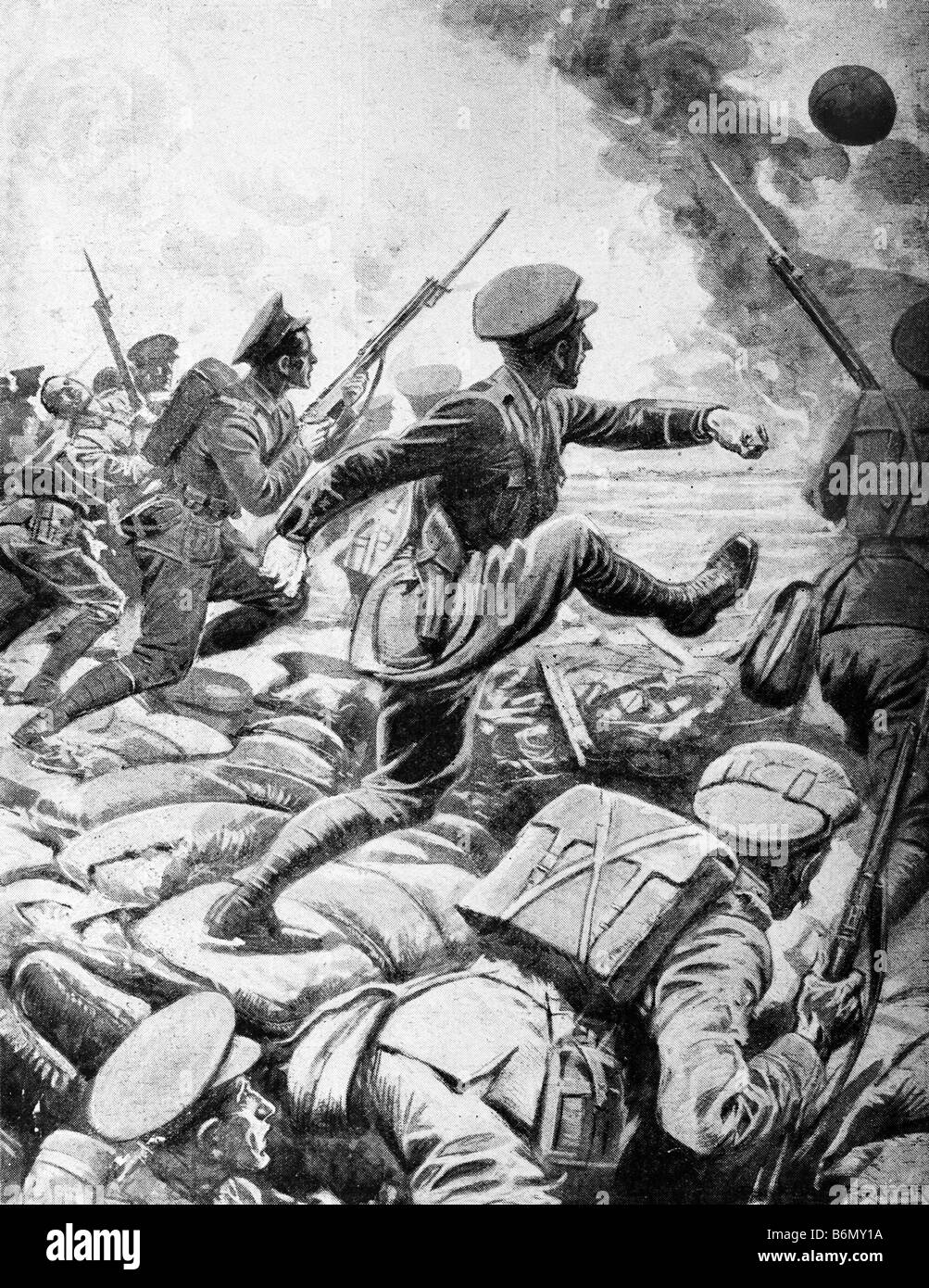 Contemporary World War One illustration of a British officer kicking a football towards German trenches as he leads an attack. Stock Photohttps://www.alamy.com/image-license-details/?v=1https://www.alamy.com/stock-photo-contemporary-world-war-one-illustration-of-a-british-officer-kicking-21358550.html
Contemporary World War One illustration of a British officer kicking a football towards German trenches as he leads an attack. Stock Photohttps://www.alamy.com/image-license-details/?v=1https://www.alamy.com/stock-photo-contemporary-world-war-one-illustration-of-a-british-officer-kicking-21358550.htmlRMB6MY1A–Contemporary World War One illustration of a British officer kicking a football towards German trenches as he leads an attack.
 Inspired by Bulwarks and trenches, 1624-1625, Agger a Spinola iactus palustri loco Lorica, vallis ligneis, munitionibus, aggeribusq. tormentarijs firmatus, Bulwarks and trenches, in use at the siege of Breda by the Spanish army under Spinola, 1624-1625. Top right legend A-G., print maker:, print, Reimagined by Artotop. Classic art reinvented with a modern twist. Design of warm cheerful glowing of brightness and light ray radiance. Photography inspired by surrealism and futurism, embracing dynamic energy of modern technology, movement, speed and revolutionize culture Stock Photohttps://www.alamy.com/image-license-details/?v=1https://www.alamy.com/inspired-by-bulwarks-and-trenches-1624-1625-agger-a-spinola-iactus-palustri-loco-lorica-vallis-ligneis-munitionibus-aggeribusq-tormentarijs-firmatus-bulwarks-and-trenches-in-use-at-the-siege-of-breda-by-the-spanish-army-under-spinola-1624-1625-top-right-legend-a-g-print-maker-print-reimagined-by-artotop-classic-art-reinvented-with-a-modern-twist-design-of-warm-cheerful-glowing-of-brightness-and-light-ray-radiance-photography-inspired-by-surrealism-and-futurism-embracing-dynamic-energy-of-modern-technology-movement-speed-and-revolutionize-culture-image459378141.html
Inspired by Bulwarks and trenches, 1624-1625, Agger a Spinola iactus palustri loco Lorica, vallis ligneis, munitionibus, aggeribusq. tormentarijs firmatus, Bulwarks and trenches, in use at the siege of Breda by the Spanish army under Spinola, 1624-1625. Top right legend A-G., print maker:, print, Reimagined by Artotop. Classic art reinvented with a modern twist. Design of warm cheerful glowing of brightness and light ray radiance. Photography inspired by surrealism and futurism, embracing dynamic energy of modern technology, movement, speed and revolutionize culture Stock Photohttps://www.alamy.com/image-license-details/?v=1https://www.alamy.com/inspired-by-bulwarks-and-trenches-1624-1625-agger-a-spinola-iactus-palustri-loco-lorica-vallis-ligneis-munitionibus-aggeribusq-tormentarijs-firmatus-bulwarks-and-trenches-in-use-at-the-siege-of-breda-by-the-spanish-army-under-spinola-1624-1625-top-right-legend-a-g-print-maker-print-reimagined-by-artotop-classic-art-reinvented-with-a-modern-twist-design-of-warm-cheerful-glowing-of-brightness-and-light-ray-radiance-photography-inspired-by-surrealism-and-futurism-embracing-dynamic-energy-of-modern-technology-movement-speed-and-revolutionize-culture-image459378141.htmlRF2HKADE5–Inspired by Bulwarks and trenches, 1624-1625, Agger a Spinola iactus palustri loco Lorica, vallis ligneis, munitionibus, aggeribusq. tormentarijs firmatus, Bulwarks and trenches, in use at the siege of Breda by the Spanish army under Spinola, 1624-1625. Top right legend A-G., print maker:, print, Reimagined by Artotop. Classic art reinvented with a modern twist. Design of warm cheerful glowing of brightness and light ray radiance. Photography inspired by surrealism and futurism, embracing dynamic energy of modern technology, movement, speed and revolutionize culture
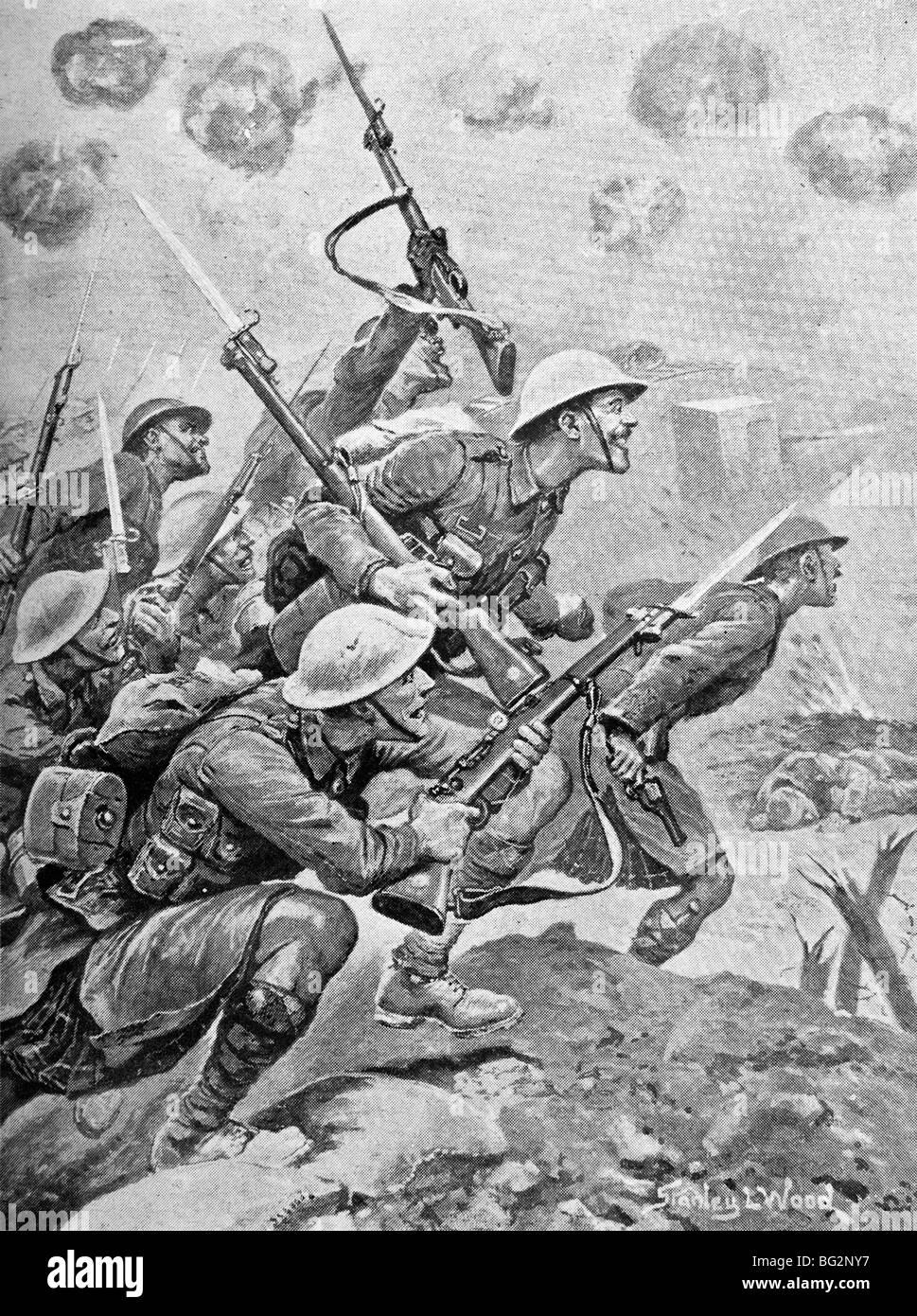 Contemporary WW1 illustration of Scottish troops going 'over the top' to attack enemy lines in France in 1917. Stock Photohttps://www.alamy.com/image-license-details/?v=1https://www.alamy.com/stock-photo-contemporary-ww1-illustration-of-scottish-troops-going-over-the-top-27105995.html
Contemporary WW1 illustration of Scottish troops going 'over the top' to attack enemy lines in France in 1917. Stock Photohttps://www.alamy.com/image-license-details/?v=1https://www.alamy.com/stock-photo-contemporary-ww1-illustration-of-scottish-troops-going-over-the-top-27105995.htmlRMBG2NY7–Contemporary WW1 illustration of Scottish troops going 'over the top' to attack enemy lines in France in 1917.
 A recreation of a British advertising recruitment poster from 1915, with two soldiers bearing bayonets at the crest of a hill, in silhouette. The slogan is don't stand looking at this, go and help! Artist Unknown. Original poster Alamy number 2J607HW Stock Photohttps://www.alamy.com/image-license-details/?v=1https://www.alamy.com/a-recreation-of-a-british-advertising-recruitment-poster-from-1915-with-two-soldiers-bearing-bayonets-at-the-crest-of-a-hill-in-silhouette-the-slogan-is-dont-stand-looking-at-this-go-and-help!-artist-unknown-original-poster-alamy-number-2j607hw-image468373946.html
A recreation of a British advertising recruitment poster from 1915, with two soldiers bearing bayonets at the crest of a hill, in silhouette. The slogan is don't stand looking at this, go and help! Artist Unknown. Original poster Alamy number 2J607HW Stock Photohttps://www.alamy.com/image-license-details/?v=1https://www.alamy.com/a-recreation-of-a-british-advertising-recruitment-poster-from-1915-with-two-soldiers-bearing-bayonets-at-the-crest-of-a-hill-in-silhouette-the-slogan-is-dont-stand-looking-at-this-go-and-help!-artist-unknown-original-poster-alamy-number-2j607hw-image468373946.htmlRM2J607MX–A recreation of a British advertising recruitment poster from 1915, with two soldiers bearing bayonets at the crest of a hill, in silhouette. The slogan is don't stand looking at this, go and help! Artist Unknown. Original poster Alamy number 2J607HW
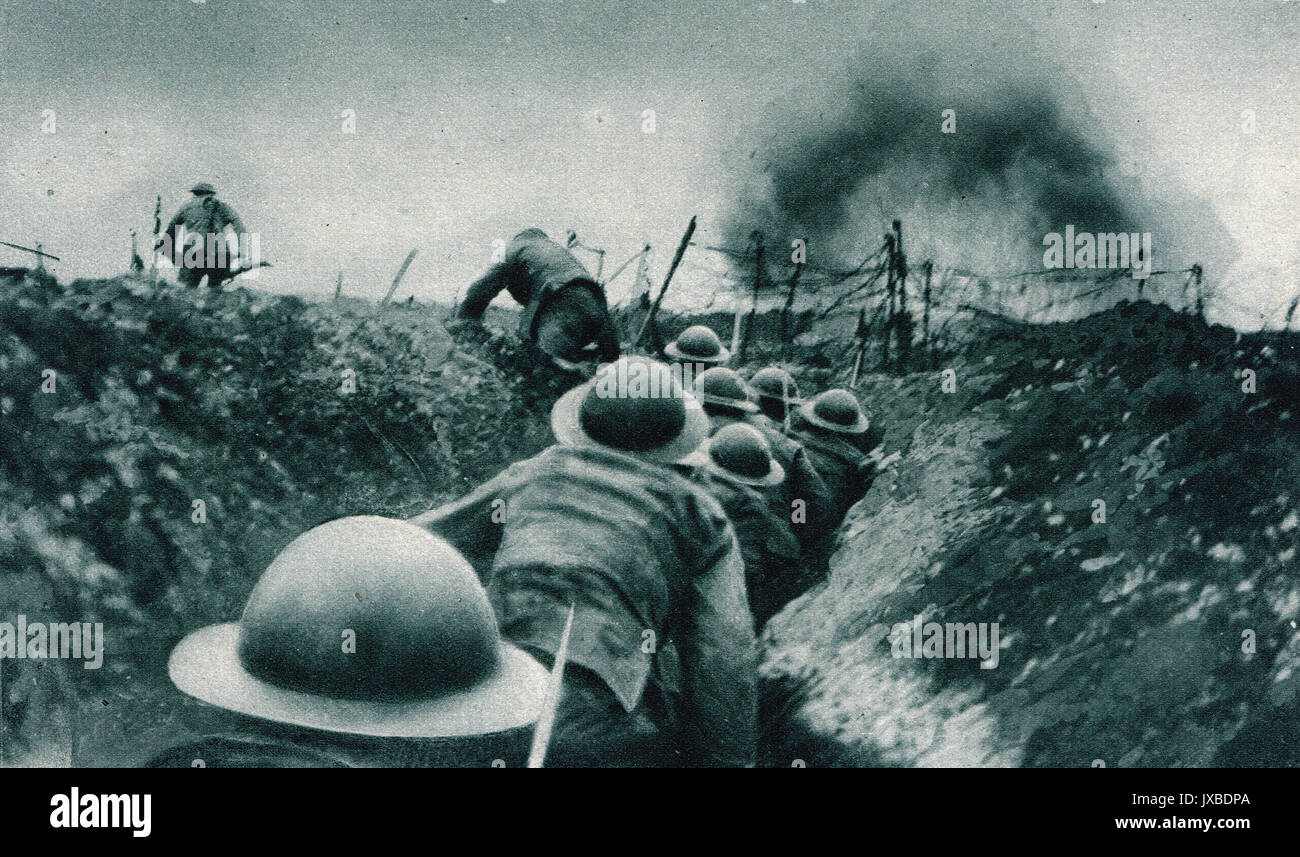 Officer leading men over the top, WW1 Stock Photohttps://www.alamy.com/image-license-details/?v=1https://www.alamy.com/officer-leading-men-over-the-top-ww1-image153916290.html
Officer leading men over the top, WW1 Stock Photohttps://www.alamy.com/image-license-details/?v=1https://www.alamy.com/officer-leading-men-over-the-top-ww1-image153916290.htmlRMJXBDPA–Officer leading men over the top, WW1
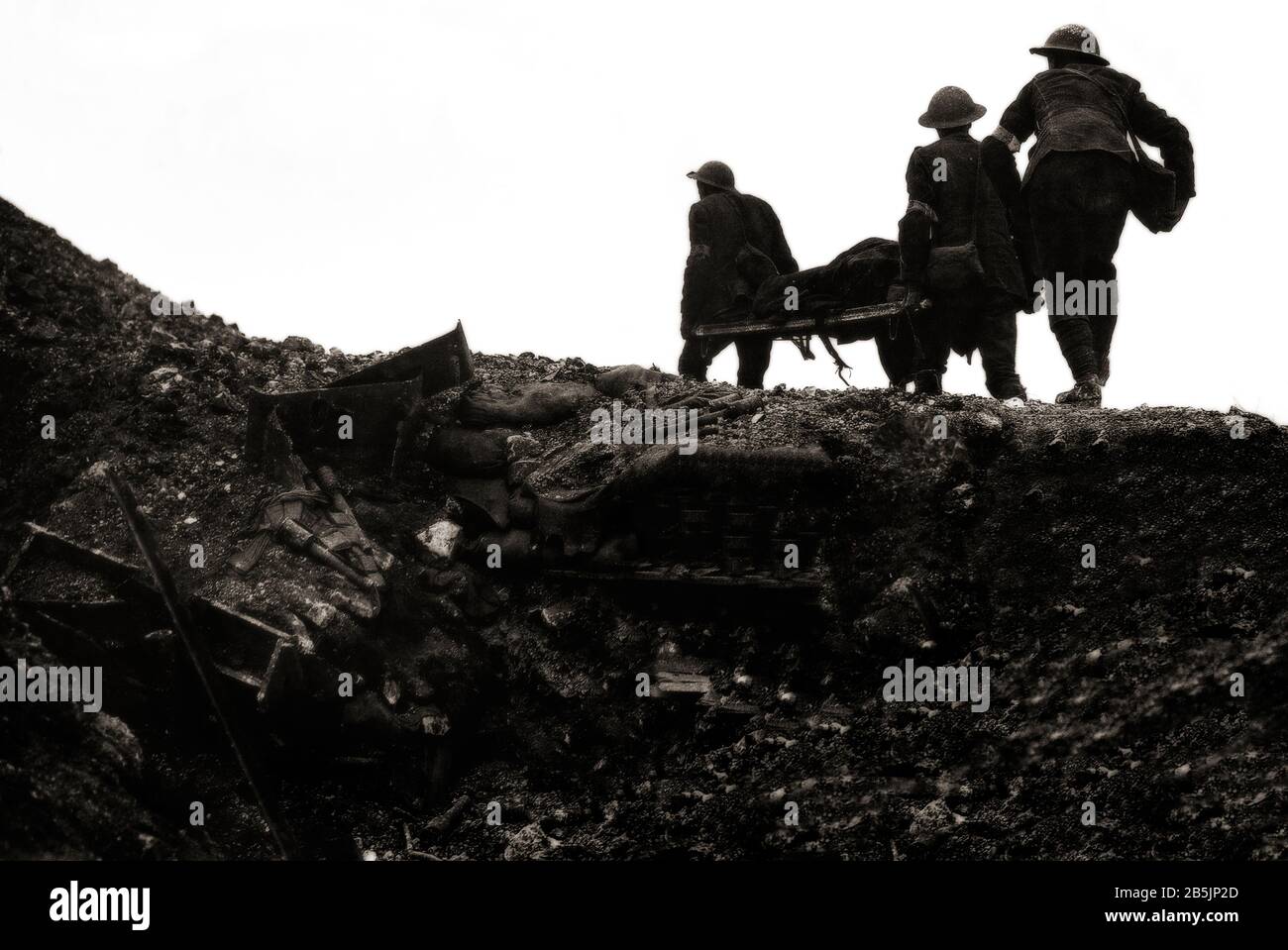 British stretcher bearers carrying a wounded soldier over the top of a trench in the village of Thiepval Wood during the Battle of the Somme in August 1916. Stock Photohttps://www.alamy.com/image-license-details/?v=1https://www.alamy.com/british-stretcher-bearers-carrying-a-wounded-soldier-over-the-top-of-a-trench-in-the-village-of-thiepval-wood-during-the-battle-of-the-somme-in-august-1916-image347693093.html
British stretcher bearers carrying a wounded soldier over the top of a trench in the village of Thiepval Wood during the Battle of the Somme in August 1916. Stock Photohttps://www.alamy.com/image-license-details/?v=1https://www.alamy.com/british-stretcher-bearers-carrying-a-wounded-soldier-over-the-top-of-a-trench-in-the-village-of-thiepval-wood-during-the-battle-of-the-somme-in-august-1916-image347693093.htmlRM2B5JP2D–British stretcher bearers carrying a wounded soldier over the top of a trench in the village of Thiepval Wood during the Battle of the Somme in August 1916.
 A historical view of trenches and the entrance to an armoured bunker on the top of the strategic Craonne plateau, the site of heavy fighting between French and German troops druing the First World War. Stock Photohttps://www.alamy.com/image-license-details/?v=1https://www.alamy.com/a-historical-view-of-trenches-and-the-entrance-to-an-armoured-bunker-on-the-top-of-the-strategic-craonne-plateau-the-site-of-heavy-fighting-between-french-and-german-troops-druing-the-first-world-war-image438702565.html
A historical view of trenches and the entrance to an armoured bunker on the top of the strategic Craonne plateau, the site of heavy fighting between French and German troops druing the First World War. Stock Photohttps://www.alamy.com/image-license-details/?v=1https://www.alamy.com/a-historical-view-of-trenches-and-the-entrance-to-an-armoured-bunker-on-the-top-of-the-strategic-craonne-plateau-the-site-of-heavy-fighting-between-french-and-german-troops-druing-the-first-world-war-image438702565.htmlRM2GDMHGN–A historical view of trenches and the entrance to an armoured bunker on the top of the strategic Craonne plateau, the site of heavy fighting between French and German troops druing the First World War.
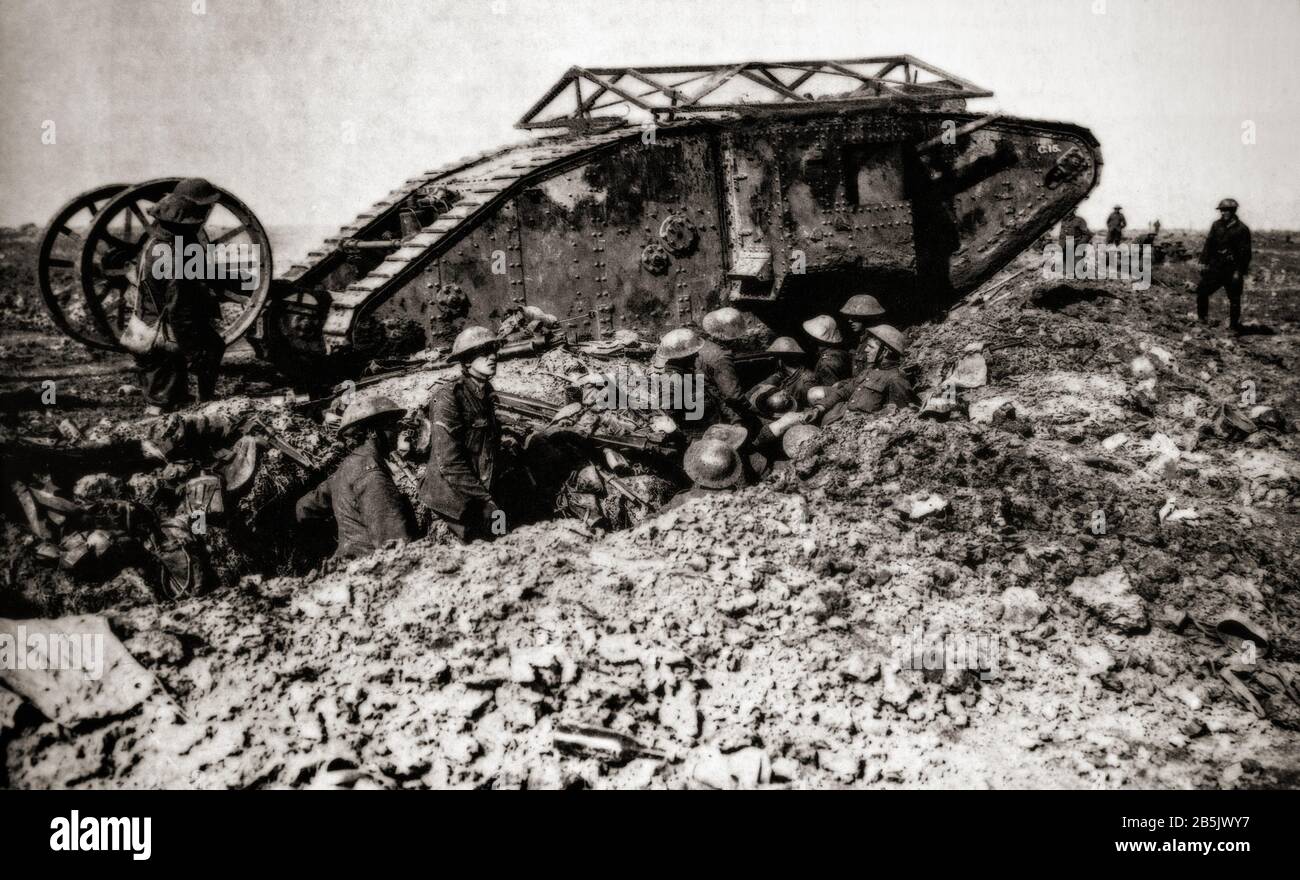 The Mark I was the world's first tank, a tracked, armed, and armoured vehicle, developed in 1915 to break the stalemate of trench warfare. It could survive the machine gun and small-arms fire in 'No Man's Land', travel over difficult terrain, crush barbed wire, and cross trenches to assault fortified enemy positions with powerful armament as seen here as it moves forward during the fight for Thiepval during the Battle of the Somme in August 1916. Stock Photohttps://www.alamy.com/image-license-details/?v=1https://www.alamy.com/the-mark-i-was-the-worlds-first-tank-a-tracked-armed-and-armoured-vehicle-developed-in-1915-to-break-the-stalemate-of-trench-warfare-it-could-survive-the-machine-gun-and-small-arms-fire-in-no-mans-land-travel-over-difficult-terrain-crush-barbed-wire-and-cross-trenches-to-assault-fortified-enemy-positions-with-powerful-armament-as-seen-here-as-it-moves-forward-during-the-fight-for-thiepval-during-the-battle-of-the-somme-in-august-1916-image347696139.html
The Mark I was the world's first tank, a tracked, armed, and armoured vehicle, developed in 1915 to break the stalemate of trench warfare. It could survive the machine gun and small-arms fire in 'No Man's Land', travel over difficult terrain, crush barbed wire, and cross trenches to assault fortified enemy positions with powerful armament as seen here as it moves forward during the fight for Thiepval during the Battle of the Somme in August 1916. Stock Photohttps://www.alamy.com/image-license-details/?v=1https://www.alamy.com/the-mark-i-was-the-worlds-first-tank-a-tracked-armed-and-armoured-vehicle-developed-in-1915-to-break-the-stalemate-of-trench-warfare-it-could-survive-the-machine-gun-and-small-arms-fire-in-no-mans-land-travel-over-difficult-terrain-crush-barbed-wire-and-cross-trenches-to-assault-fortified-enemy-positions-with-powerful-armament-as-seen-here-as-it-moves-forward-during-the-fight-for-thiepval-during-the-battle-of-the-somme-in-august-1916-image347696139.htmlRM2B5JWY7–The Mark I was the world's first tank, a tracked, armed, and armoured vehicle, developed in 1915 to break the stalemate of trench warfare. It could survive the machine gun and small-arms fire in 'No Man's Land', travel over difficult terrain, crush barbed wire, and cross trenches to assault fortified enemy positions with powerful armament as seen here as it moves forward during the fight for Thiepval during the Battle of the Somme in August 1916.
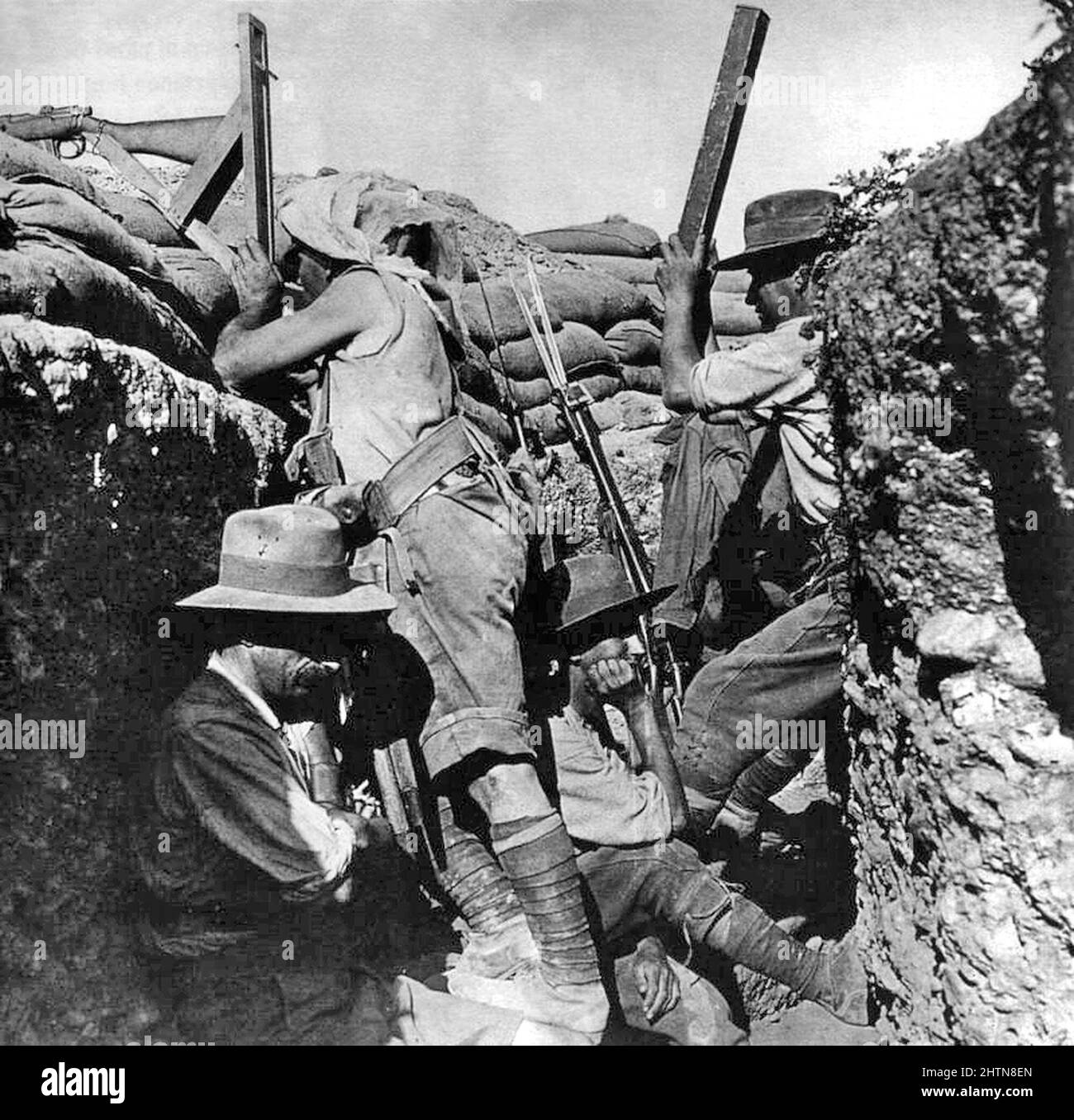 Australian light horseman using a periscope rifle to look over the top of a trench Stock Photohttps://www.alamy.com/image-license-details/?v=1https://www.alamy.com/australian-light-horseman-using-a-periscope-rifle-to-look-over-the-top-of-a-trench-image462688989.html
Australian light horseman using a periscope rifle to look over the top of a trench Stock Photohttps://www.alamy.com/image-license-details/?v=1https://www.alamy.com/australian-light-horseman-using-a-periscope-rifle-to-look-over-the-top-of-a-trench-image462688989.htmlRM2HTN8EN–Australian light horseman using a periscope rifle to look over the top of a trench
 Bulwarks and trenches, 1624-1625, Agger a Spinola iactus palustri loco Lorica, vallis ligneis, munitionibus, aggeribusq. tormentarijs firmatus (title on object), Bulwarks and trenches, in use at the siege of Breda by the Spanish army under Spinola, 1624-1625. Top right legend A-G., print maker: anonymous, print maker: Theodoor Galle (possibly), Southern Netherlands, 1625 - 1626, paper, etching, height 242 mm × width 355 mm Stock Photohttps://www.alamy.com/image-license-details/?v=1https://www.alamy.com/bulwarks-and-trenches-1624-1625-agger-a-spinola-iactus-palustri-loco-lorica-vallis-ligneis-munitionibus-aggeribusq-tormentarijs-firmatus-title-on-object-bulwarks-and-trenches-in-use-at-the-siege-of-breda-by-the-spanish-army-under-spinola-1624-1625-top-right-legend-a-g-print-maker-anonymous-print-maker-theodoor-galle-possibly-southern-netherlands-1625-1626-paper-etching-height-242-mm-width-355-mm-image454362462.html
Bulwarks and trenches, 1624-1625, Agger a Spinola iactus palustri loco Lorica, vallis ligneis, munitionibus, aggeribusq. tormentarijs firmatus (title on object), Bulwarks and trenches, in use at the siege of Breda by the Spanish army under Spinola, 1624-1625. Top right legend A-G., print maker: anonymous, print maker: Theodoor Galle (possibly), Southern Netherlands, 1625 - 1626, paper, etching, height 242 mm × width 355 mm Stock Photohttps://www.alamy.com/image-license-details/?v=1https://www.alamy.com/bulwarks-and-trenches-1624-1625-agger-a-spinola-iactus-palustri-loco-lorica-vallis-ligneis-munitionibus-aggeribusq-tormentarijs-firmatus-title-on-object-bulwarks-and-trenches-in-use-at-the-siege-of-breda-by-the-spanish-army-under-spinola-1624-1625-top-right-legend-a-g-print-maker-anonymous-print-maker-theodoor-galle-possibly-southern-netherlands-1625-1626-paper-etching-height-242-mm-width-355-mm-image454362462.htmlRM2HB5YXP–Bulwarks and trenches, 1624-1625, Agger a Spinola iactus palustri loco Lorica, vallis ligneis, munitionibus, aggeribusq. tormentarijs firmatus (title on object), Bulwarks and trenches, in use at the siege of Breda by the Spanish army under Spinola, 1624-1625. Top right legend A-G., print maker: anonymous, print maker: Theodoor Galle (possibly), Southern Netherlands, 1625 - 1626, paper, etching, height 242 mm × width 355 mm
 Gurkha troops going over the top, Palestine, WW1 Stock Photohttps://www.alamy.com/image-license-details/?v=1https://www.alamy.com/gurkha-troops-going-over-the-top-palestine-ww1-image66158907.html
Gurkha troops going over the top, Palestine, WW1 Stock Photohttps://www.alamy.com/image-license-details/?v=1https://www.alamy.com/gurkha-troops-going-over-the-top-palestine-ww1-image66158907.htmlRMDRHPA3–Gurkha troops going over the top, Palestine, WW1
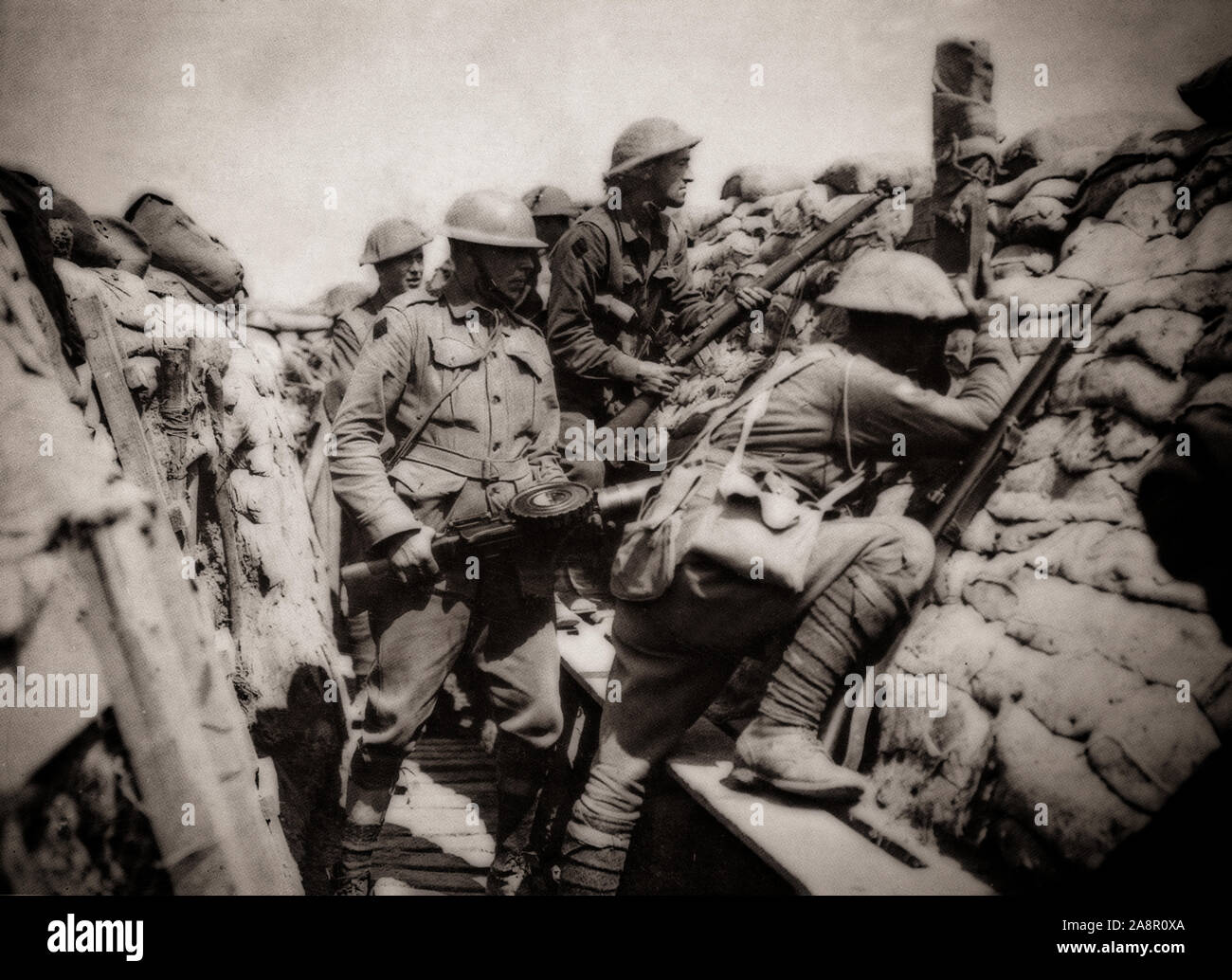 Soldiers of the 2nd Australian Division in the trenches during World War One. They were were initially sent to the region of the Belgian border to gain familiarity with some of the new weapons of modern warfare, including gas. They then moved into the front-line trenches near Armentières in the Nord department in the Hauts-de-France region in northern France. It was an area known as “the nursery” and although it was a relatively quiet sector, there were periods of sharp fighting, shelling, and some heavy raids; by the end of June over 600 men had been killed. Stock Photohttps://www.alamy.com/image-license-details/?v=1https://www.alamy.com/soldiers-of-the-2nd-australian-division-in-the-trenches-during-world-war-one-they-were-were-initially-sent-to-the-region-of-the-belgian-border-to-gain-familiarity-with-some-of-the-new-weapons-of-modern-warfare-including-gas-they-then-moved-into-the-front-line-trenches-near-armentires-in-the-nord-department-in-the-hauts-de-france-region-in-northern-france-it-was-an-area-known-as-the-nursery-and-although-it-was-a-relatively-quiet-sector-there-were-periods-of-sharp-fighting-shelling-and-some-heavy-raids-by-the-end-of-june-over-600-men-had-been-killed-image332419874.html
Soldiers of the 2nd Australian Division in the trenches during World War One. They were were initially sent to the region of the Belgian border to gain familiarity with some of the new weapons of modern warfare, including gas. They then moved into the front-line trenches near Armentières in the Nord department in the Hauts-de-France region in northern France. It was an area known as “the nursery” and although it was a relatively quiet sector, there were periods of sharp fighting, shelling, and some heavy raids; by the end of June over 600 men had been killed. Stock Photohttps://www.alamy.com/image-license-details/?v=1https://www.alamy.com/soldiers-of-the-2nd-australian-division-in-the-trenches-during-world-war-one-they-were-were-initially-sent-to-the-region-of-the-belgian-border-to-gain-familiarity-with-some-of-the-new-weapons-of-modern-warfare-including-gas-they-then-moved-into-the-front-line-trenches-near-armentires-in-the-nord-department-in-the-hauts-de-france-region-in-northern-france-it-was-an-area-known-as-the-nursery-and-although-it-was-a-relatively-quiet-sector-there-were-periods-of-sharp-fighting-shelling-and-some-heavy-raids-by-the-end-of-june-over-600-men-had-been-killed-image332419874.htmlRM2A8R0XA–Soldiers of the 2nd Australian Division in the trenches during World War One. They were were initially sent to the region of the Belgian border to gain familiarity with some of the new weapons of modern warfare, including gas. They then moved into the front-line trenches near Armentières in the Nord department in the Hauts-de-France region in northern France. It was an area known as “the nursery” and although it was a relatively quiet sector, there were periods of sharp fighting, shelling, and some heavy raids; by the end of June over 600 men had been killed.
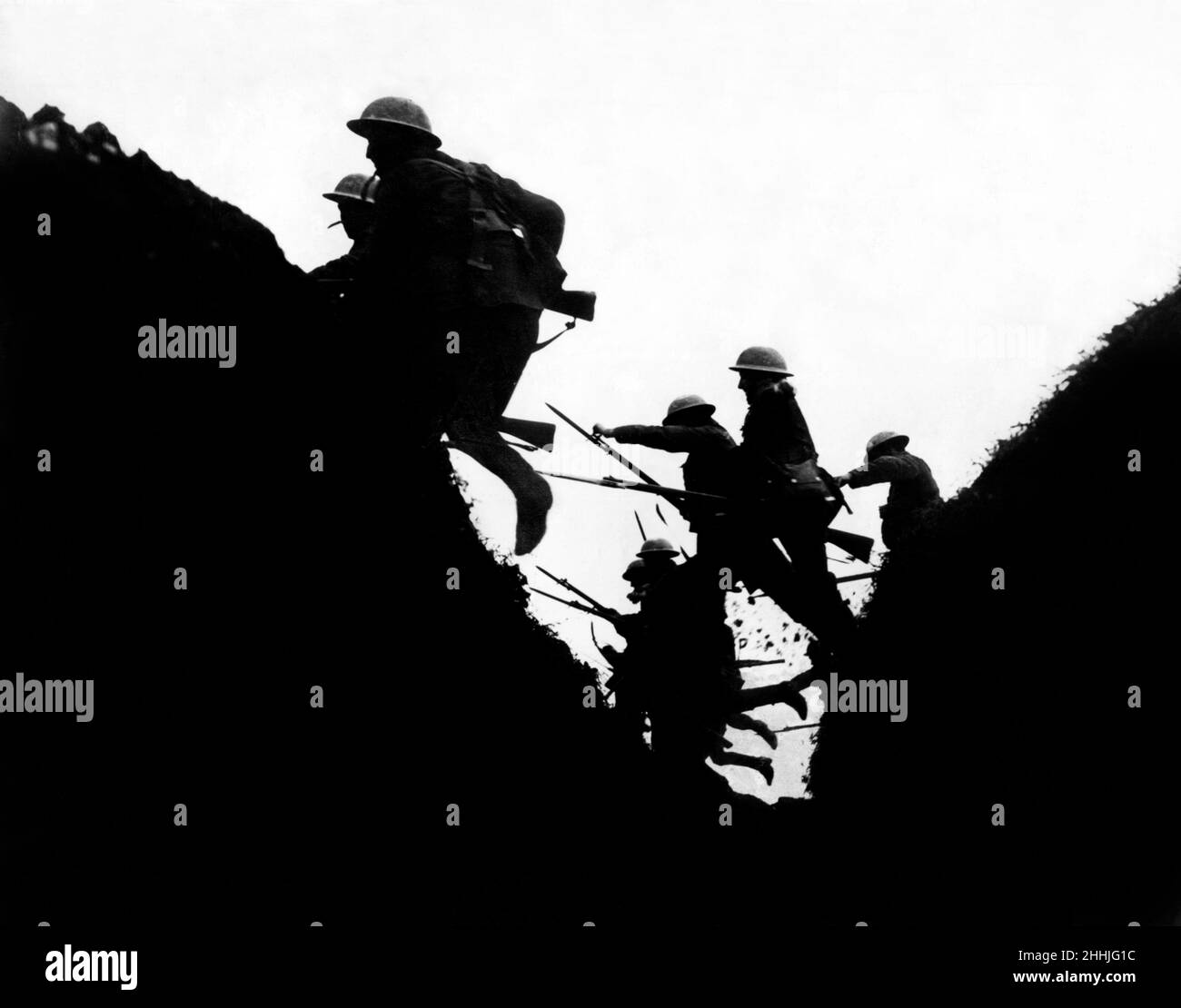 The Great War, ( First World War, WW1, World War One ).British soldiers go 'over the top' in June 1916 during training to attack the German trenches somewhere in France. Circa June 1916. Stock Photohttps://www.alamy.com/image-license-details/?v=1https://www.alamy.com/the-great-war-first-world-war-ww1-world-war-one-british-soldiers-go-over-the-top-in-june-1916-during-training-to-attack-the-german-trenches-somewhere-in-france-circa-june-1916-image458326440.html
The Great War, ( First World War, WW1, World War One ).British soldiers go 'over the top' in June 1916 during training to attack the German trenches somewhere in France. Circa June 1916. Stock Photohttps://www.alamy.com/image-license-details/?v=1https://www.alamy.com/the-great-war-first-world-war-ww1-world-war-one-british-soldiers-go-over-the-top-in-june-1916-during-training-to-attack-the-german-trenches-somewhere-in-france-circa-june-1916-image458326440.htmlRM2HHJG1C–The Great War, ( First World War, WW1, World War One ).British soldiers go 'over the top' in June 1916 during training to attack the German trenches somewhere in France. Circa June 1916.
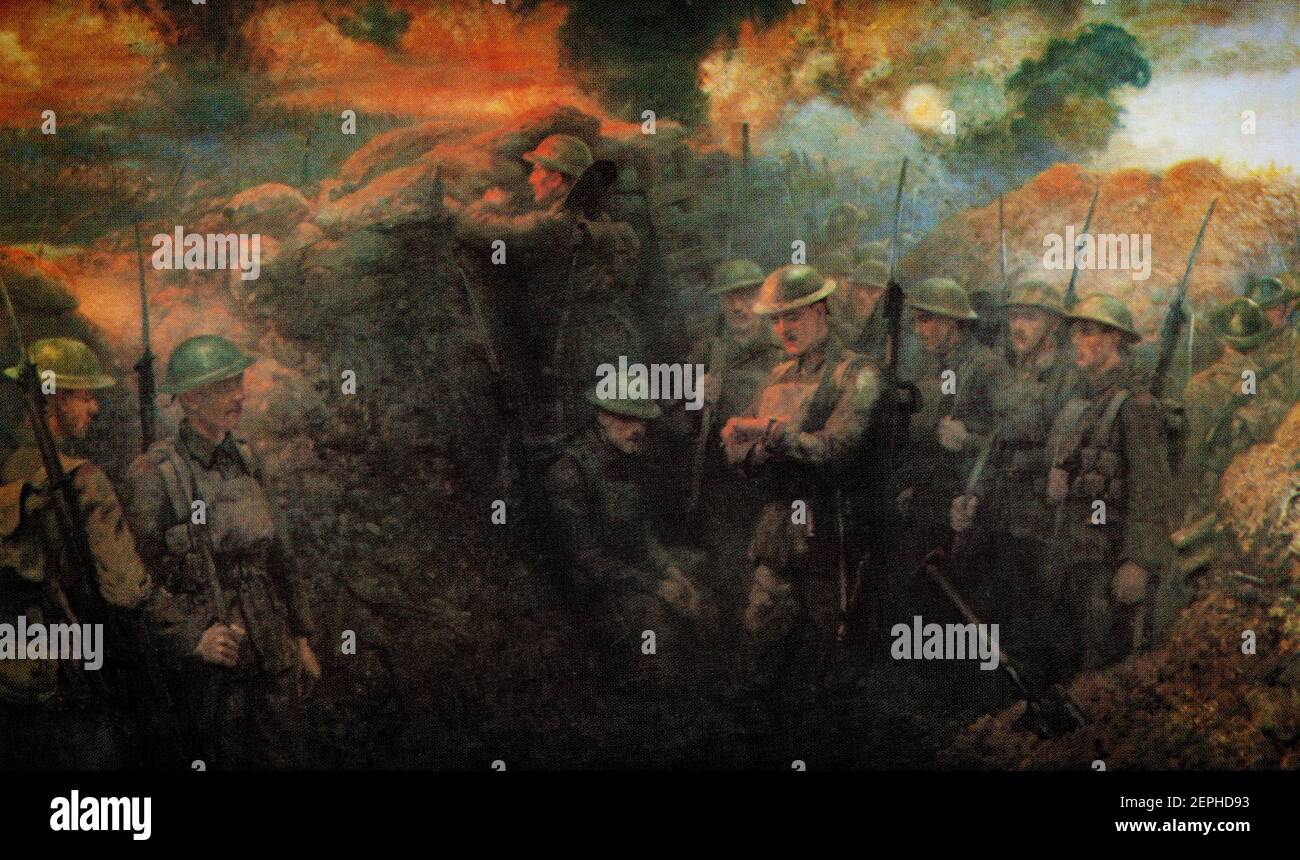 Soldiers prepare to go over the top from the trench during the Battle of the Somme, also known as the Somme Offensive. It was a battle of the First World War fought by the armies of the British Empire and French Third Republic against the German Empire and took place between 1 July and 18 November 1916 on both sides of the upper reaches of the River Somme in France. The battle was intended to hasten a victory for the Allies. More than three million men fought in the battle and one million men were wounded or killed, making it one of the deadliest battles in human history. Stock Photohttps://www.alamy.com/image-license-details/?v=1https://www.alamy.com/soldiers-prepare-to-go-over-the-top-from-the-trench-during-the-battle-of-the-somme-also-known-as-the-somme-offensive-it-was-a-battle-of-the-first-world-war-fought-by-the-armies-of-the-british-empire-and-french-third-republic-against-the-german-empire-and-took-place-between-1-july-and-18-november-1916-on-both-sides-of-the-upper-reaches-of-the-river-somme-in-france-the-battle-was-intended-to-hasten-a-victory-for-the-allies-more-than-three-million-men-fought-in-the-battle-and-one-million-men-were-wounded-or-killed-making-it-one-of-the-deadliest-battles-in-human-history-image409744527.html
Soldiers prepare to go over the top from the trench during the Battle of the Somme, also known as the Somme Offensive. It was a battle of the First World War fought by the armies of the British Empire and French Third Republic against the German Empire and took place between 1 July and 18 November 1916 on both sides of the upper reaches of the River Somme in France. The battle was intended to hasten a victory for the Allies. More than three million men fought in the battle and one million men were wounded or killed, making it one of the deadliest battles in human history. Stock Photohttps://www.alamy.com/image-license-details/?v=1https://www.alamy.com/soldiers-prepare-to-go-over-the-top-from-the-trench-during-the-battle-of-the-somme-also-known-as-the-somme-offensive-it-was-a-battle-of-the-first-world-war-fought-by-the-armies-of-the-british-empire-and-french-third-republic-against-the-german-empire-and-took-place-between-1-july-and-18-november-1916-on-both-sides-of-the-upper-reaches-of-the-river-somme-in-france-the-battle-was-intended-to-hasten-a-victory-for-the-allies-more-than-three-million-men-fought-in-the-battle-and-one-million-men-were-wounded-or-killed-making-it-one-of-the-deadliest-battles-in-human-history-image409744527.htmlRM2EPHD93–Soldiers prepare to go over the top from the trench during the Battle of the Somme, also known as the Somme Offensive. It was a battle of the First World War fought by the armies of the British Empire and French Third Republic against the German Empire and took place between 1 July and 18 November 1916 on both sides of the upper reaches of the River Somme in France. The battle was intended to hasten a victory for the Allies. More than three million men fought in the battle and one million men were wounded or killed, making it one of the deadliest battles in human history.
 World War I British troops charging from the trenches The trenches of World War I have given us some of the most horrific images of the twentieth century By the latter stages of the war the trenches had devloped from small dug outs like this one into a massive network of trenches across the Western Front Millions of men died going over the top during World War I Many men didn t even reach the top of the trench before an enemy bullet cut them down The trenches were littered with corpses and fragments of human debris They were cold and wet and the mud turned to swamp by the incescant shell fire Stock Photohttps://www.alamy.com/image-license-details/?v=1https://www.alamy.com/stock-photo-world-war-i-british-troops-charging-from-the-trenches-the-trenches-20141292.html
World War I British troops charging from the trenches The trenches of World War I have given us some of the most horrific images of the twentieth century By the latter stages of the war the trenches had devloped from small dug outs like this one into a massive network of trenches across the Western Front Millions of men died going over the top during World War I Many men didn t even reach the top of the trench before an enemy bullet cut them down The trenches were littered with corpses and fragments of human debris They were cold and wet and the mud turned to swamp by the incescant shell fire Stock Photohttps://www.alamy.com/image-license-details/?v=1https://www.alamy.com/stock-photo-world-war-i-british-troops-charging-from-the-trenches-the-trenches-20141292.htmlRMB4NEBT–World War I British troops charging from the trenches The trenches of World War I have given us some of the most horrific images of the twentieth century By the latter stages of the war the trenches had devloped from small dug outs like this one into a massive network of trenches across the Western Front Millions of men died going over the top during World War I Many men didn t even reach the top of the trench before an enemy bullet cut them down The trenches were littered with corpses and fragments of human debris They were cold and wet and the mud turned to swamp by the incescant shell fire
 View along trenches, Russell's Top, Gallipoli, Turkey, 1915 Stock Photohttps://www.alamy.com/image-license-details/?v=1https://www.alamy.com/view-along-trenches-russells-top-gallipoli-turkey-1915-image69106150.html
View along trenches, Russell's Top, Gallipoli, Turkey, 1915 Stock Photohttps://www.alamy.com/image-license-details/?v=1https://www.alamy.com/view-along-trenches-russells-top-gallipoli-turkey-1915-image69106150.htmlRME0C1GP–View along trenches, Russell's Top, Gallipoli, Turkey, 1915
 Italian trench of the Great War towards the top of Mount La Sisilla. Piccole Dolomiti, Recoaro Terme, Vicenza province, Veneto, Italy, Europe. Stock Photohttps://www.alamy.com/image-license-details/?v=1https://www.alamy.com/italian-trench-of-the-great-war-towards-the-top-of-mount-la-sisilla-piccole-dolomiti-recoaro-terme-vicenza-province-veneto-italy-europe-image344395013.html
Italian trench of the Great War towards the top of Mount La Sisilla. Piccole Dolomiti, Recoaro Terme, Vicenza province, Veneto, Italy, Europe. Stock Photohttps://www.alamy.com/image-license-details/?v=1https://www.alamy.com/italian-trench-of-the-great-war-towards-the-top-of-mount-la-sisilla-piccole-dolomiti-recoaro-terme-vicenza-province-veneto-italy-europe-image344395013.htmlRM2B08F9W–Italian trench of the Great War towards the top of Mount La Sisilla. Piccole Dolomiti, Recoaro Terme, Vicenza province, Veneto, Italy, Europe.
 Filipino trenches at top of first rise north of Caloocan, 1899 Stock Photohttps://www.alamy.com/image-license-details/?v=1https://www.alamy.com/stock-photo-filipino-trenches-at-top-of-first-rise-north-of-caloocan-1899-139901555.html
Filipino trenches at top of first rise north of Caloocan, 1899 Stock Photohttps://www.alamy.com/image-license-details/?v=1https://www.alamy.com/stock-photo-filipino-trenches-at-top-of-first-rise-north-of-caloocan-1899-139901555.htmlRMJ3H1T3–Filipino trenches at top of first rise north of Caloocan, 1899
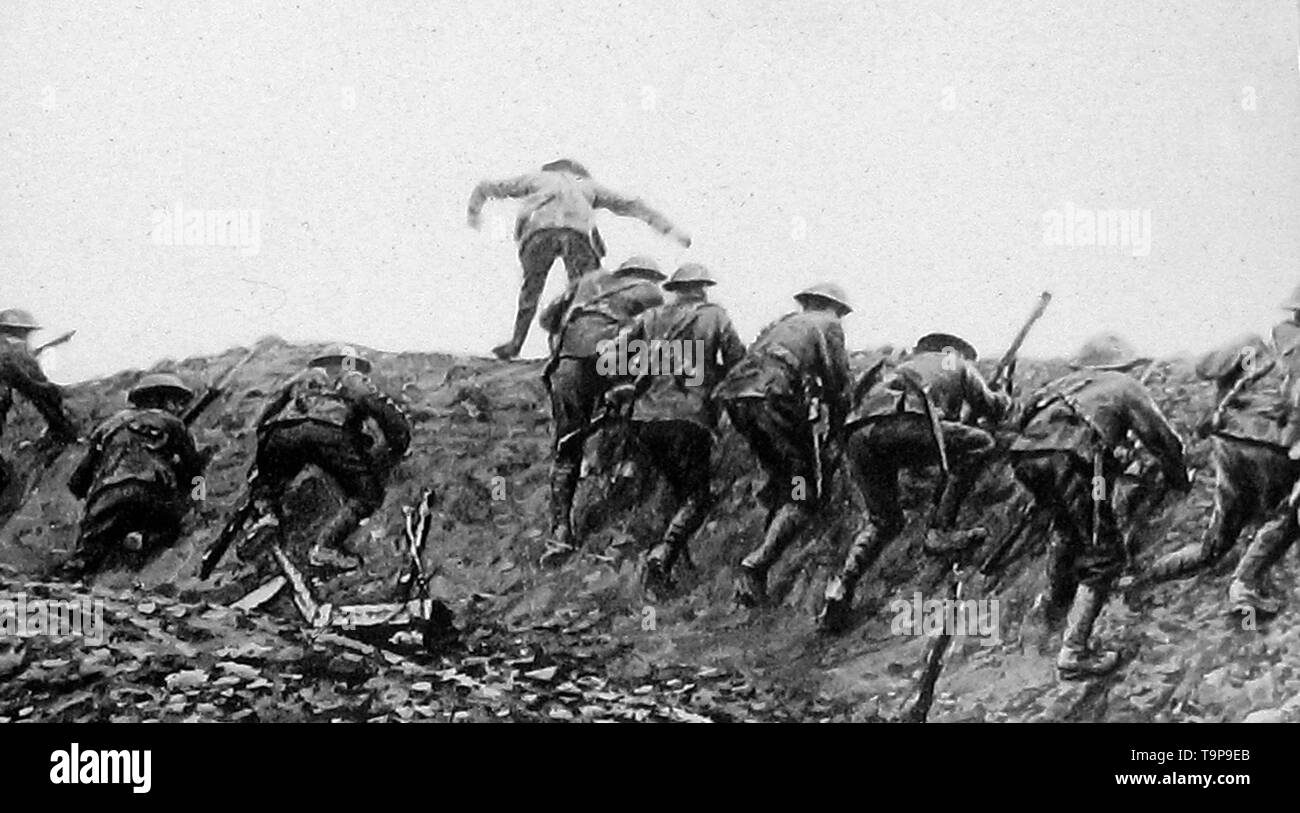 WW1 Troops in trenches going over the top Stock Photohttps://www.alamy.com/image-license-details/?v=1https://www.alamy.com/ww1-troops-in-trenches-going-over-the-top-image246967459.html
WW1 Troops in trenches going over the top Stock Photohttps://www.alamy.com/image-license-details/?v=1https://www.alamy.com/ww1-troops-in-trenches-going-over-the-top-image246967459.htmlRFT9P9EB–WW1 Troops in trenches going over the top
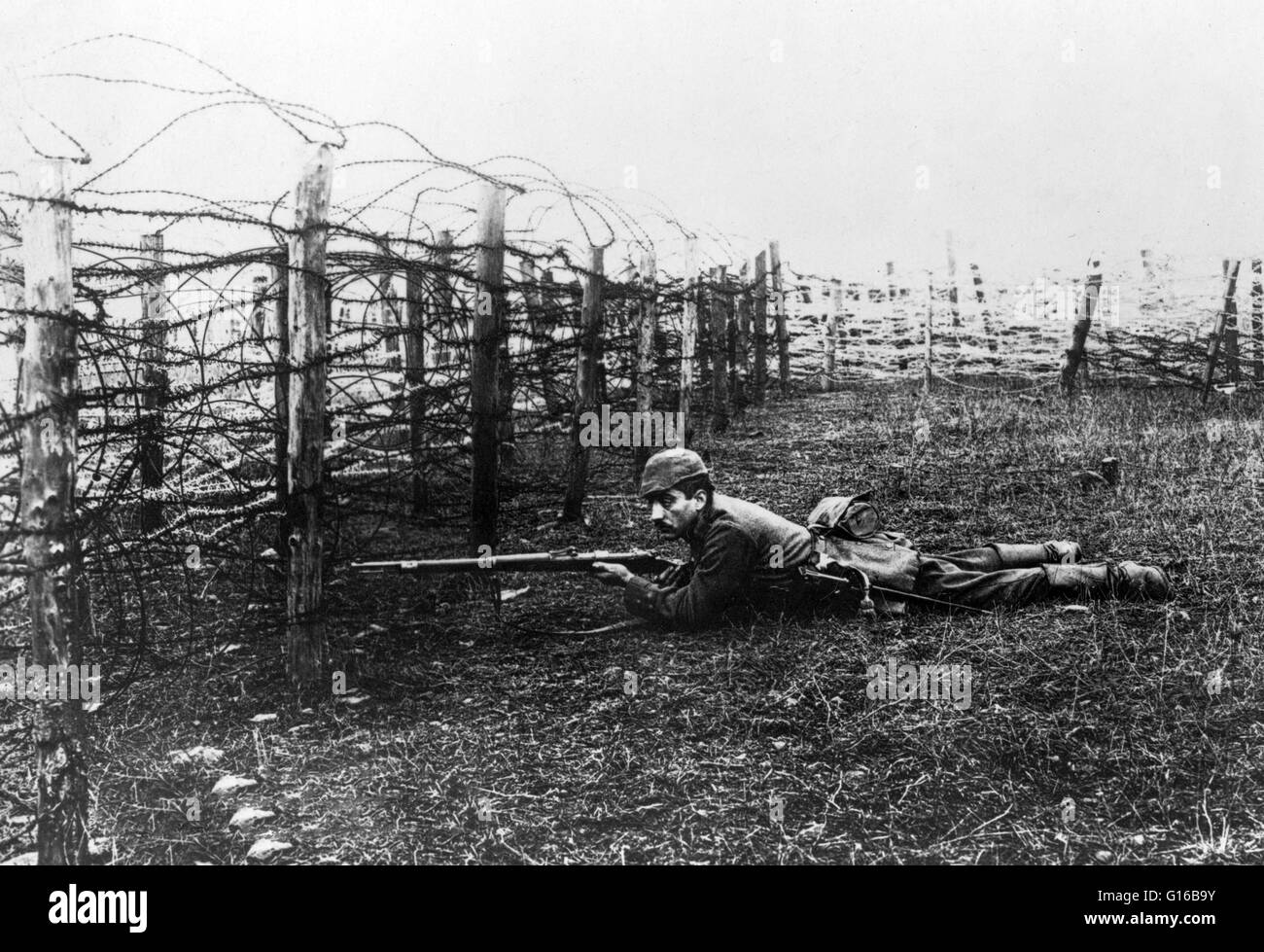 German sniper laying on ground near barbed wire defenses. Throughout World War I, snipers were often used in the trenches in an effort to take out enemy soldiers as their heads peered over the top of the opposing trench. At the start of WW I, only Germany Stock Photohttps://www.alamy.com/image-license-details/?v=1https://www.alamy.com/stock-photo-german-sniper-laying-on-ground-near-barbed-wire-defenses-throughout-104017479.html
German sniper laying on ground near barbed wire defenses. Throughout World War I, snipers were often used in the trenches in an effort to take out enemy soldiers as their heads peered over the top of the opposing trench. At the start of WW I, only Germany Stock Photohttps://www.alamy.com/image-license-details/?v=1https://www.alamy.com/stock-photo-german-sniper-laying-on-ground-near-barbed-wire-defenses-throughout-104017479.htmlRMG16B9Y–German sniper laying on ground near barbed wire defenses. Throughout World War I, snipers were often used in the trenches in an effort to take out enemy soldiers as their heads peered over the top of the opposing trench. At the start of WW I, only Germany
 Art inspired by Bulwarks and trenches, 1624-1625, Agger a Spinola iactus palustri loco Lorica, vallis ligneis, munitionibus, aggeribusq. tormentarijs firmatus, Bulwarks and trenches, in use at the siege of Breda by the Spanish army under Spinola, 1624-1625. Top right legend A-G., print, Classic works modernized by Artotop with a splash of modernity. Shapes, color and value, eye-catching visual impact on art. Emotions through freedom of artworks in a contemporary way. A timeless message pursuing a wildly creative new direction. Artists turning to the digital medium and creating the Artotop NFT Stock Photohttps://www.alamy.com/image-license-details/?v=1https://www.alamy.com/art-inspired-by-bulwarks-and-trenches-1624-1625-agger-a-spinola-iactus-palustri-loco-lorica-vallis-ligneis-munitionibus-aggeribusq-tormentarijs-firmatus-bulwarks-and-trenches-in-use-at-the-siege-of-breda-by-the-spanish-army-under-spinola-1624-1625-top-right-legend-a-g-print-classic-works-modernized-by-artotop-with-a-splash-of-modernity-shapes-color-and-value-eye-catching-visual-impact-on-art-emotions-through-freedom-of-artworks-in-a-contemporary-way-a-timeless-message-pursuing-a-wildly-creative-new-direction-artists-turning-to-the-digital-medium-and-creating-the-artotop-nft-image459724020.html
Art inspired by Bulwarks and trenches, 1624-1625, Agger a Spinola iactus palustri loco Lorica, vallis ligneis, munitionibus, aggeribusq. tormentarijs firmatus, Bulwarks and trenches, in use at the siege of Breda by the Spanish army under Spinola, 1624-1625. Top right legend A-G., print, Classic works modernized by Artotop with a splash of modernity. Shapes, color and value, eye-catching visual impact on art. Emotions through freedom of artworks in a contemporary way. A timeless message pursuing a wildly creative new direction. Artists turning to the digital medium and creating the Artotop NFT Stock Photohttps://www.alamy.com/image-license-details/?v=1https://www.alamy.com/art-inspired-by-bulwarks-and-trenches-1624-1625-agger-a-spinola-iactus-palustri-loco-lorica-vallis-ligneis-munitionibus-aggeribusq-tormentarijs-firmatus-bulwarks-and-trenches-in-use-at-the-siege-of-breda-by-the-spanish-army-under-spinola-1624-1625-top-right-legend-a-g-print-classic-works-modernized-by-artotop-with-a-splash-of-modernity-shapes-color-and-value-eye-catching-visual-impact-on-art-emotions-through-freedom-of-artworks-in-a-contemporary-way-a-timeless-message-pursuing-a-wildly-creative-new-direction-artists-turning-to-the-digital-medium-and-creating-the-artotop-nft-image459724020.htmlRF2HKX6K0–Art inspired by Bulwarks and trenches, 1624-1625, Agger a Spinola iactus palustri loco Lorica, vallis ligneis, munitionibus, aggeribusq. tormentarijs firmatus, Bulwarks and trenches, in use at the siege of Breda by the Spanish army under Spinola, 1624-1625. Top right legend A-G., print, Classic works modernized by Artotop with a splash of modernity. Shapes, color and value, eye-catching visual impact on art. Emotions through freedom of artworks in a contemporary way. A timeless message pursuing a wildly creative new direction. Artists turning to the digital medium and creating the Artotop NFT
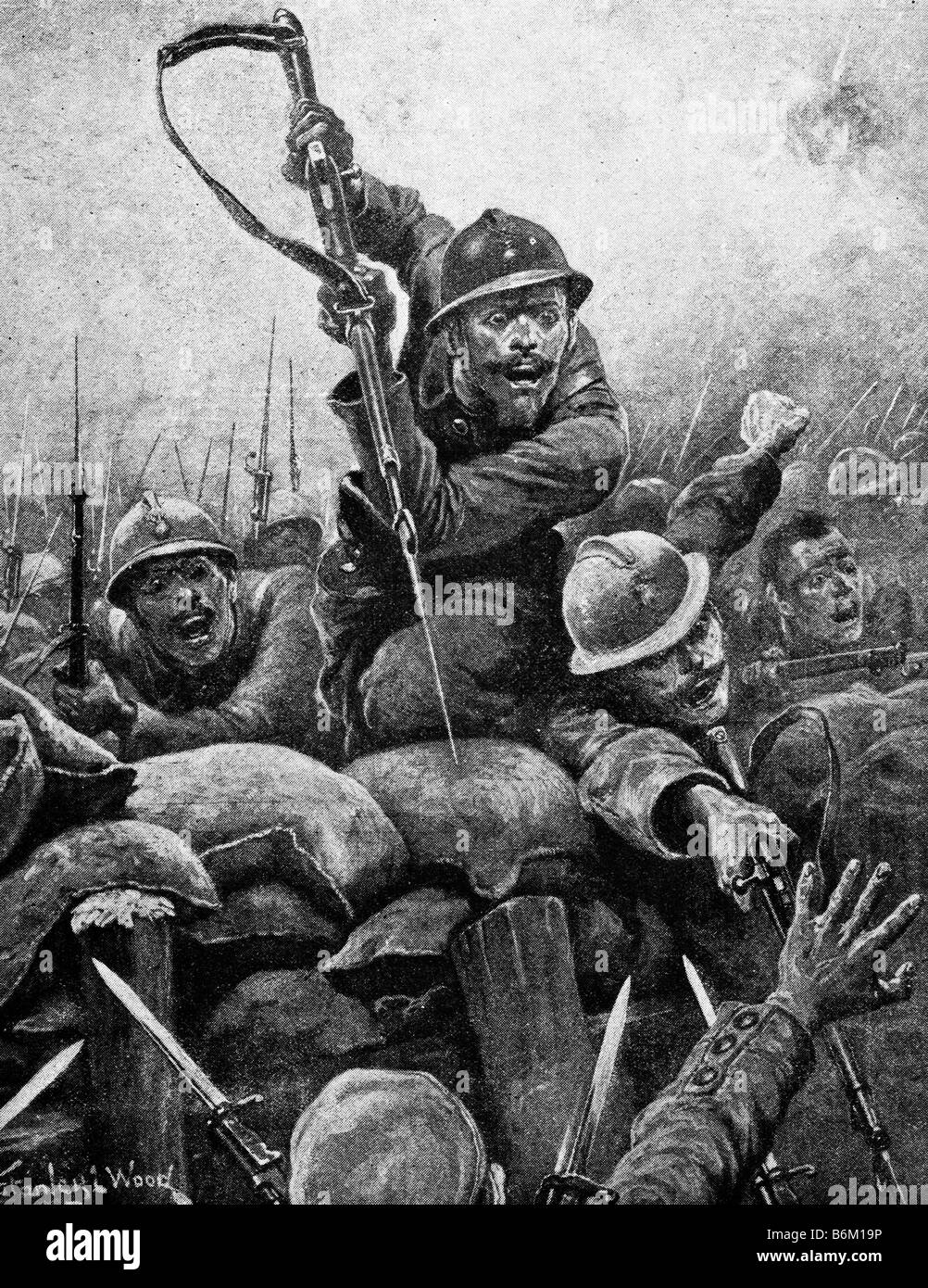 Contemporary World War One illustration of French soldiers storming a German trench. Stock Photohttps://www.alamy.com/image-license-details/?v=1https://www.alamy.com/stock-photo-contemporary-world-war-one-illustration-of-french-soldiers-storming-21338402.html
Contemporary World War One illustration of French soldiers storming a German trench. Stock Photohttps://www.alamy.com/image-license-details/?v=1https://www.alamy.com/stock-photo-contemporary-world-war-one-illustration-of-french-soldiers-storming-21338402.htmlRMB6M19P–Contemporary World War One illustration of French soldiers storming a German trench.
 Filipino trenches at top of first rise north of Caloocan, 1899. Stock Photohttps://www.alamy.com/image-license-details/?v=1https://www.alamy.com/filipino-trenches-at-top-of-first-rise-north-of-caloocan-1899-image329639193.html
Filipino trenches at top of first rise north of Caloocan, 1899. Stock Photohttps://www.alamy.com/image-license-details/?v=1https://www.alamy.com/filipino-trenches-at-top-of-first-rise-north-of-caloocan-1899-image329639193.htmlRM2A48A49–Filipino trenches at top of first rise north of Caloocan, 1899.
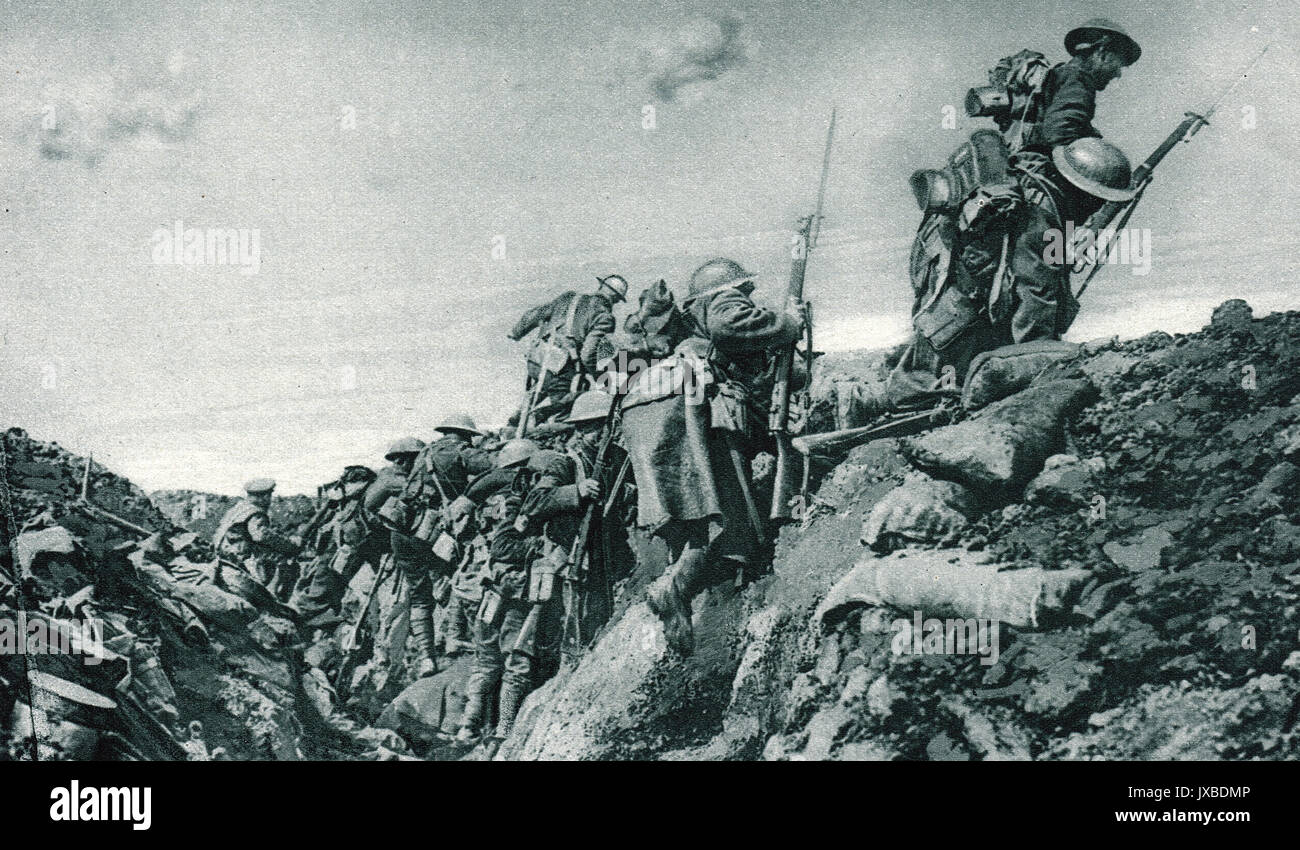 Canadian soldiers going over the top WW1 Stock Photohttps://www.alamy.com/image-license-details/?v=1https://www.alamy.com/canadian-soldiers-going-over-the-top-ww1-image153916246.html
Canadian soldiers going over the top WW1 Stock Photohttps://www.alamy.com/image-license-details/?v=1https://www.alamy.com/canadian-soldiers-going-over-the-top-ww1-image153916246.htmlRMJXBDMP–Canadian soldiers going over the top WW1
 The Saint George Gate, medieval tower and gateway in the City wall of Visby in Gotland, Sweden Stock Photohttps://www.alamy.com/image-license-details/?v=1https://www.alamy.com/the-saint-george-gate-medieval-tower-and-gateway-in-the-city-wall-of-visby-in-gotland-sweden-image461254675.html
The Saint George Gate, medieval tower and gateway in the City wall of Visby in Gotland, Sweden Stock Photohttps://www.alamy.com/image-license-details/?v=1https://www.alamy.com/the-saint-george-gate-medieval-tower-and-gateway-in-the-city-wall-of-visby-in-gotland-sweden-image461254675.htmlRF2HPBY17–The Saint George Gate, medieval tower and gateway in the City wall of Visby in Gotland, Sweden
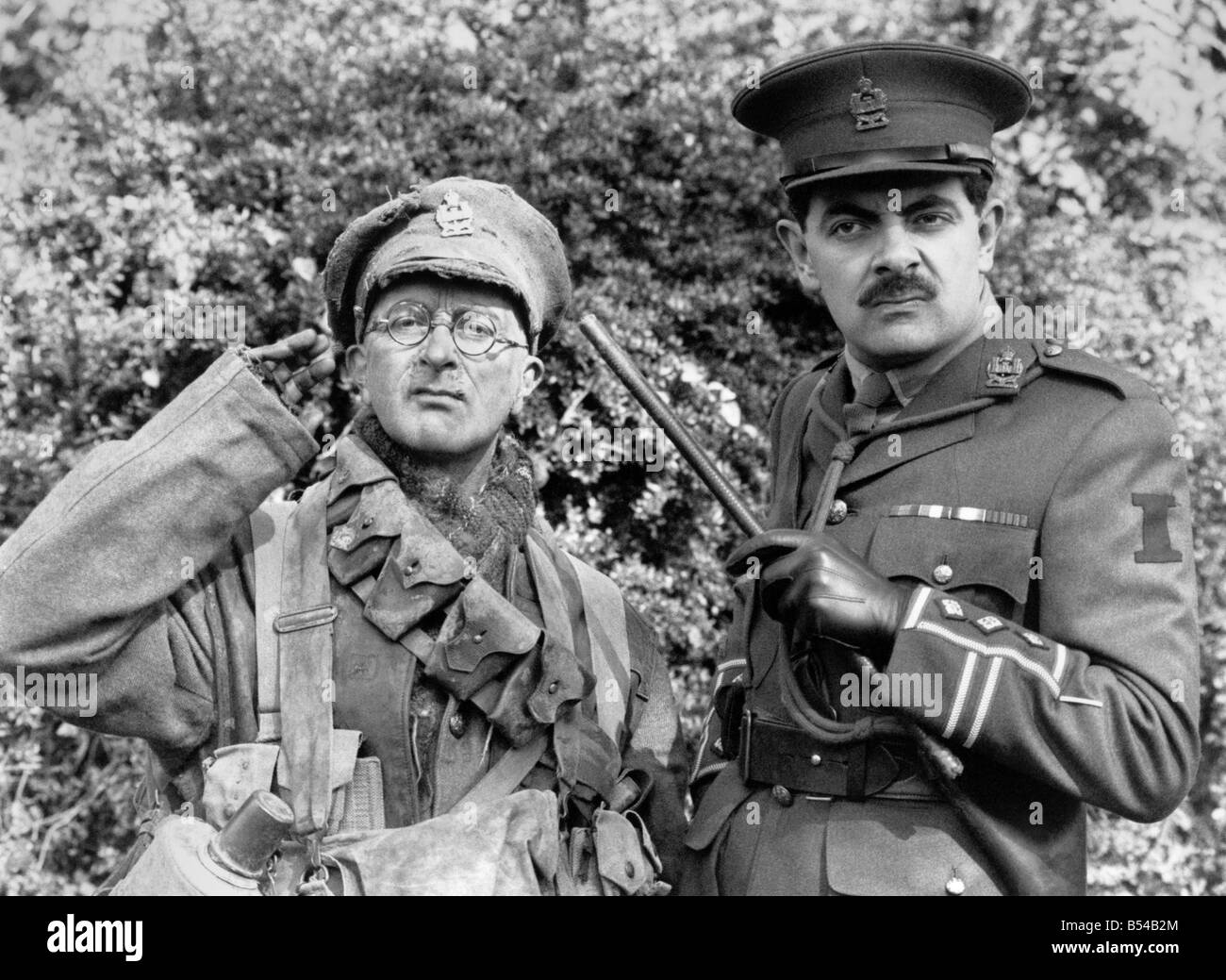 It's Blackadder and Baldrick, going well over the top in a new BBC series set in the trenches of World War one. Rowan Atkinson and Tony Robinson, along with their other old mates, will be back on the box at the end of this month. ;September 1989 ;P017080 Stock Photohttps://www.alamy.com/image-license-details/?v=1https://www.alamy.com/stock-photo-its-blackadder-and-baldrick-going-well-over-the-top-in-a-new-bbc-series-20380156.html
It's Blackadder and Baldrick, going well over the top in a new BBC series set in the trenches of World War one. Rowan Atkinson and Tony Robinson, along with their other old mates, will be back on the box at the end of this month. ;September 1989 ;P017080 Stock Photohttps://www.alamy.com/image-license-details/?v=1https://www.alamy.com/stock-photo-its-blackadder-and-baldrick-going-well-over-the-top-in-a-new-bbc-series-20380156.htmlRMB54B2M–It's Blackadder and Baldrick, going well over the top in a new BBC series set in the trenches of World War one. Rowan Atkinson and Tony Robinson, along with their other old mates, will be back on the box at the end of this month. ;September 1989 ;P017080
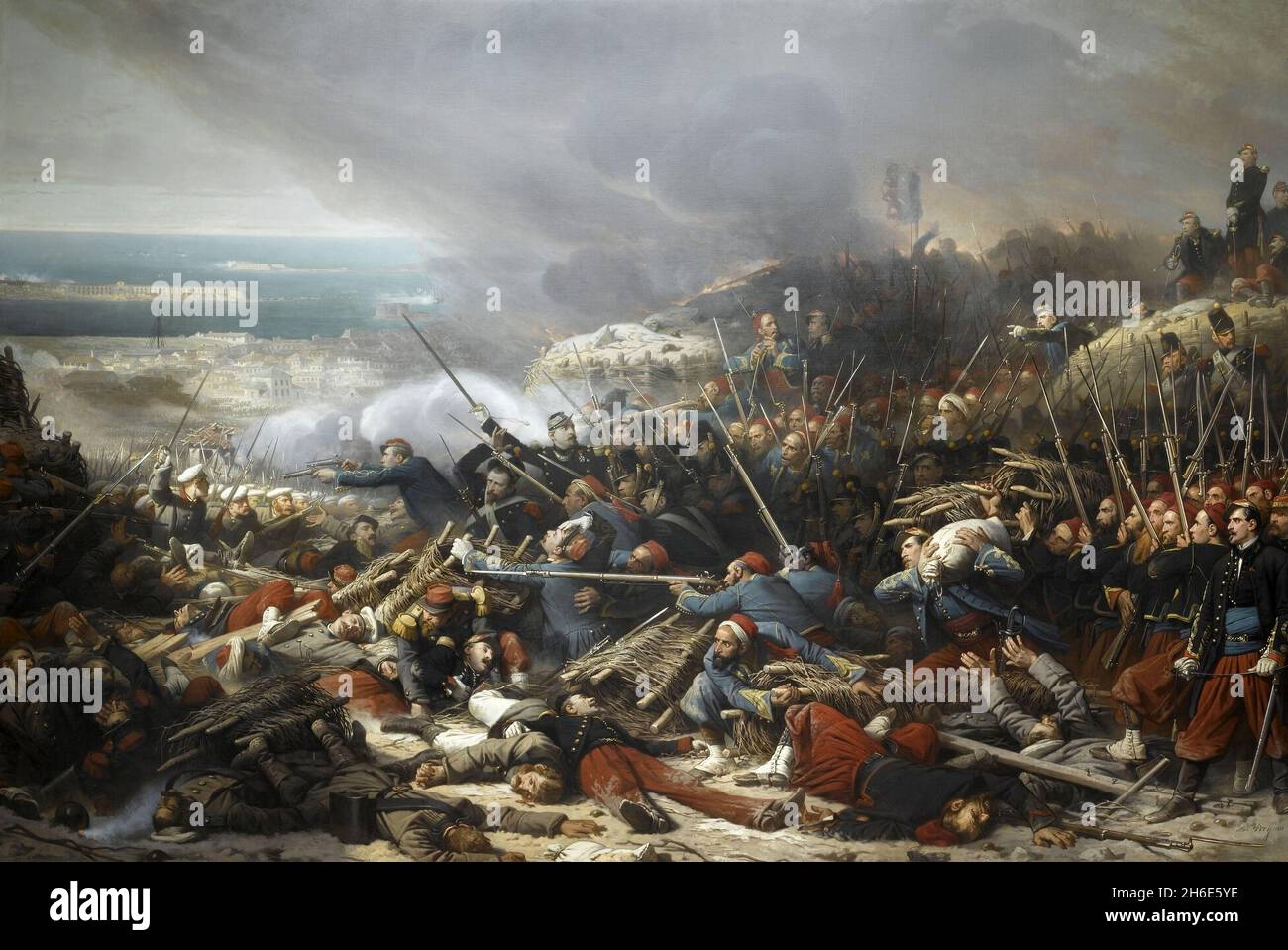 French attacking Russian army at the battle of Malakoff, siege of Sevastopol, Crimean War. a painting by Adolphe Yvon. The Battle of Malakoff was a French attack against Russian forces on the Malakoff redoubt and its subsequent capture on 8 September 1855 as a part of the siege of Sevastopol during the Crimean War. The French army under General MacMahon successfully stormed the Malakoff redoubt, while a simultaneous British attack on the Redan to the south of the Malakoff was repulsed. In one of the war's defining moments, the French zouave Eugène Libaut raised the French flag on the top of th Stock Photohttps://www.alamy.com/image-license-details/?v=1https://www.alamy.com/french-attacking-russian-army-at-the-battle-of-malakoff-siege-of-sevastopol-crimean-war-a-painting-by-adolphe-yvon-the-battle-of-malakoff-was-a-french-attack-against-russian-forces-on-the-malakoff-redoubt-and-its-subsequent-capture-on-8-september-1855-as-a-part-of-the-siege-of-sevastopol-during-the-crimean-war-the-french-army-under-general-macmahon-successfully-stormed-the-malakoff-redoubt-while-a-simultaneous-british-attack-on-the-redan-to-the-south-of-the-malakoff-was-repulsed-in-one-of-the-wars-defining-moments-the-french-zouave-eugne-libaut-raised-the-french-flag-on-the-top-of-th-image451469522.html
French attacking Russian army at the battle of Malakoff, siege of Sevastopol, Crimean War. a painting by Adolphe Yvon. The Battle of Malakoff was a French attack against Russian forces on the Malakoff redoubt and its subsequent capture on 8 September 1855 as a part of the siege of Sevastopol during the Crimean War. The French army under General MacMahon successfully stormed the Malakoff redoubt, while a simultaneous British attack on the Redan to the south of the Malakoff was repulsed. In one of the war's defining moments, the French zouave Eugène Libaut raised the French flag on the top of th Stock Photohttps://www.alamy.com/image-license-details/?v=1https://www.alamy.com/french-attacking-russian-army-at-the-battle-of-malakoff-siege-of-sevastopol-crimean-war-a-painting-by-adolphe-yvon-the-battle-of-malakoff-was-a-french-attack-against-russian-forces-on-the-malakoff-redoubt-and-its-subsequent-capture-on-8-september-1855-as-a-part-of-the-siege-of-sevastopol-during-the-crimean-war-the-french-army-under-general-macmahon-successfully-stormed-the-malakoff-redoubt-while-a-simultaneous-british-attack-on-the-redan-to-the-south-of-the-malakoff-was-repulsed-in-one-of-the-wars-defining-moments-the-french-zouave-eugne-libaut-raised-the-french-flag-on-the-top-of-th-image451469522.htmlRF2H6E5YE–French attacking Russian army at the battle of Malakoff, siege of Sevastopol, Crimean War. a painting by Adolphe Yvon. The Battle of Malakoff was a French attack against Russian forces on the Malakoff redoubt and its subsequent capture on 8 September 1855 as a part of the siege of Sevastopol during the Crimean War. The French army under General MacMahon successfully stormed the Malakoff redoubt, while a simultaneous British attack on the Redan to the south of the Malakoff was repulsed. In one of the war's defining moments, the French zouave Eugène Libaut raised the French flag on the top of th
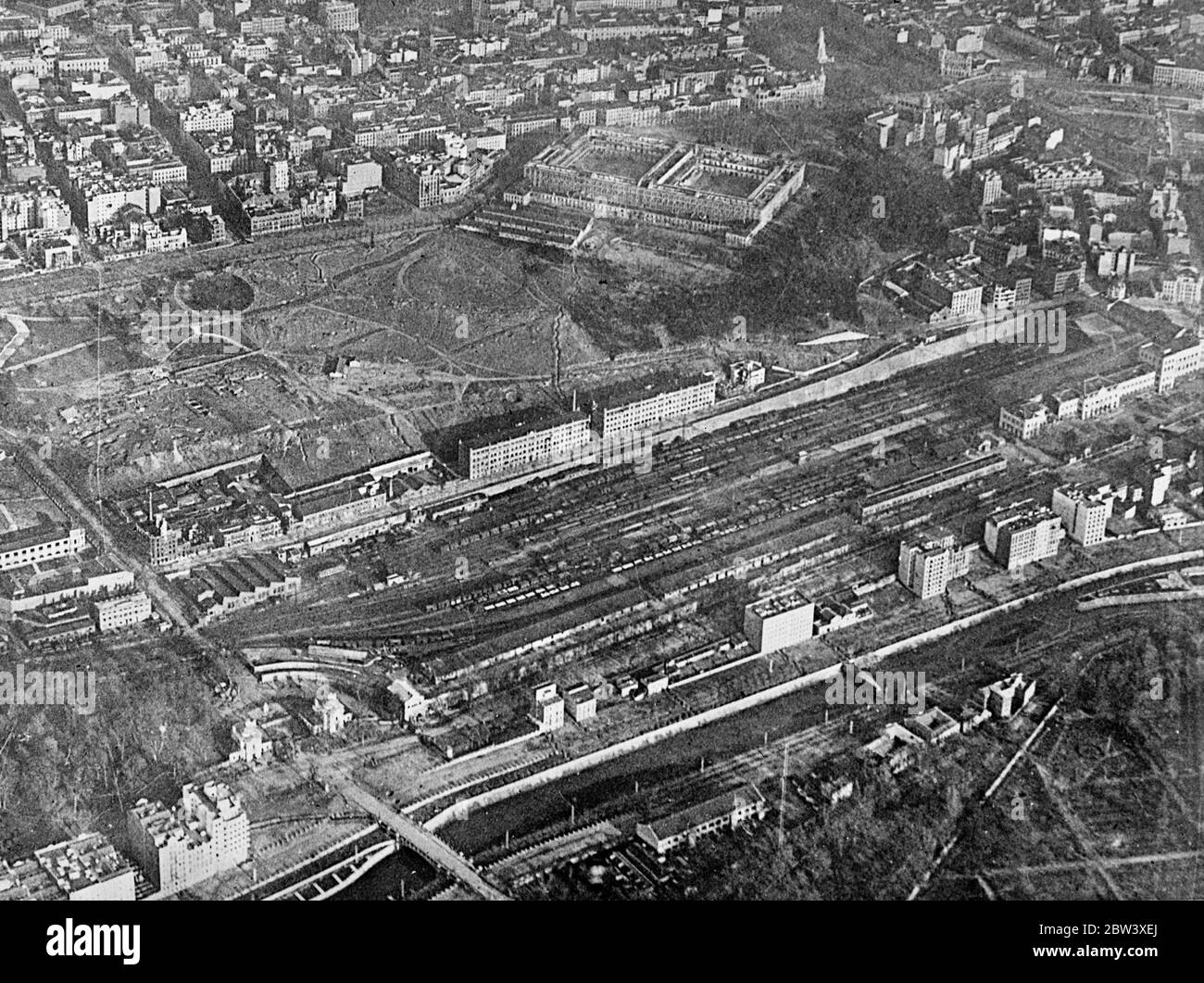 The Madrid battle front from the air . These aeial pictures give a vivid impression of the Madrid battle line where since the beginning of last November , when General Franco first laid siege to the capital , Government defenders and rebel attackers have have launched attack and counter attack in the net work of trenches and defence works on the fringe of the city . Photo shows , an aerial view ofwestern battle front of Madrid with the Manzanaras River below , and a part of the Casa del Campo ( lower right corner ) . The rectangular building top right is the burnt out Montana Barracks , and in Stock Photohttps://www.alamy.com/image-license-details/?v=1https://www.alamy.com/the-madrid-battle-front-from-the-air-these-aeial-pictures-give-a-vivid-impression-of-the-madrid-battle-line-where-since-the-beginning-of-last-november-when-general-franco-first-laid-siege-to-the-capital-government-defenders-and-rebel-attackers-have-have-launched-attack-and-counter-attack-in-the-net-work-of-trenches-and-defence-works-on-the-fringe-of-the-city-photo-shows-an-aerial-view-ofwestern-battle-front-of-madrid-with-the-manzanaras-river-below-and-a-part-of-the-casa-del-campo-lower-right-corner-the-rectangular-building-top-right-is-the-burnt-out-montana-barracks-and-in-image359660410.html
The Madrid battle front from the air . These aeial pictures give a vivid impression of the Madrid battle line where since the beginning of last November , when General Franco first laid siege to the capital , Government defenders and rebel attackers have have launched attack and counter attack in the net work of trenches and defence works on the fringe of the city . Photo shows , an aerial view ofwestern battle front of Madrid with the Manzanaras River below , and a part of the Casa del Campo ( lower right corner ) . The rectangular building top right is the burnt out Montana Barracks , and in Stock Photohttps://www.alamy.com/image-license-details/?v=1https://www.alamy.com/the-madrid-battle-front-from-the-air-these-aeial-pictures-give-a-vivid-impression-of-the-madrid-battle-line-where-since-the-beginning-of-last-november-when-general-franco-first-laid-siege-to-the-capital-government-defenders-and-rebel-attackers-have-have-launched-attack-and-counter-attack-in-the-net-work-of-trenches-and-defence-works-on-the-fringe-of-the-city-photo-shows-an-aerial-view-ofwestern-battle-front-of-madrid-with-the-manzanaras-river-below-and-a-part-of-the-casa-del-campo-lower-right-corner-the-rectangular-building-top-right-is-the-burnt-out-montana-barracks-and-in-image359660410.htmlRM2BW3XEJ–The Madrid battle front from the air . These aeial pictures give a vivid impression of the Madrid battle line where since the beginning of last November , when General Franco first laid siege to the capital , Government defenders and rebel attackers have have launched attack and counter attack in the net work of trenches and defence works on the fringe of the city . Photo shows , an aerial view ofwestern battle front of Madrid with the Manzanaras River below , and a part of the Casa del Campo ( lower right corner ) . The rectangular building top right is the burnt out Montana Barracks , and in
 Entrance to trenches at a road in the Dolomites, Entrée des tranchées de première ligne. -- Sur la route, officers de la mission anglaise. (title on object), On the left, soldiers, probably Italians, stand at the top of a staircase leading to the entrance to trenches in a fortified mountainside. On the right, members of an English mission are walking along a path. Part of Photo album Medical mission H. de Rothschild to the Italian front 1916., photograph, Henri de Rothschild, (attributed to), Dolomieten, 1916, photographic support, gelatin silver print, height, 218 mm × width, 280 mm Stock Photohttps://www.alamy.com/image-license-details/?v=1https://www.alamy.com/entrance-to-trenches-at-a-road-in-the-dolomites-entre-des-tranches-de-premire-ligne-sur-la-route-officers-de-la-mission-anglaise-title-on-object-on-the-left-soldiers-probably-italians-stand-at-the-top-of-a-staircase-leading-to-the-entrance-to-trenches-in-a-fortified-mountainside-on-the-right-members-of-an-english-mission-are-walking-along-a-path-part-of-photo-album-medical-mission-h-de-rothschild-to-the-italian-front-1916-photograph-henri-de-rothschild-attributed-to-dolomieten-1916-photographic-support-gelatin-silver-print-height-218-mm-width-280-mm-image606651713.html
Entrance to trenches at a road in the Dolomites, Entrée des tranchées de première ligne. -- Sur la route, officers de la mission anglaise. (title on object), On the left, soldiers, probably Italians, stand at the top of a staircase leading to the entrance to trenches in a fortified mountainside. On the right, members of an English mission are walking along a path. Part of Photo album Medical mission H. de Rothschild to the Italian front 1916., photograph, Henri de Rothschild, (attributed to), Dolomieten, 1916, photographic support, gelatin silver print, height, 218 mm × width, 280 mm Stock Photohttps://www.alamy.com/image-license-details/?v=1https://www.alamy.com/entrance-to-trenches-at-a-road-in-the-dolomites-entre-des-tranches-de-premire-ligne-sur-la-route-officers-de-la-mission-anglaise-title-on-object-on-the-left-soldiers-probably-italians-stand-at-the-top-of-a-staircase-leading-to-the-entrance-to-trenches-in-a-fortified-mountainside-on-the-right-members-of-an-english-mission-are-walking-along-a-path-part-of-photo-album-medical-mission-h-de-rothschild-to-the-italian-front-1916-photograph-henri-de-rothschild-attributed-to-dolomieten-1916-photographic-support-gelatin-silver-print-height-218-mm-width-280-mm-image606651713.htmlRM2X6YACH–Entrance to trenches at a road in the Dolomites, Entrée des tranchées de première ligne. -- Sur la route, officers de la mission anglaise. (title on object), On the left, soldiers, probably Italians, stand at the top of a staircase leading to the entrance to trenches in a fortified mountainside. On the right, members of an English mission are walking along a path. Part of Photo album Medical mission H. de Rothschild to the Italian front 1916., photograph, Henri de Rothschild, (attributed to), Dolomieten, 1916, photographic support, gelatin silver print, height, 218 mm × width, 280 mm
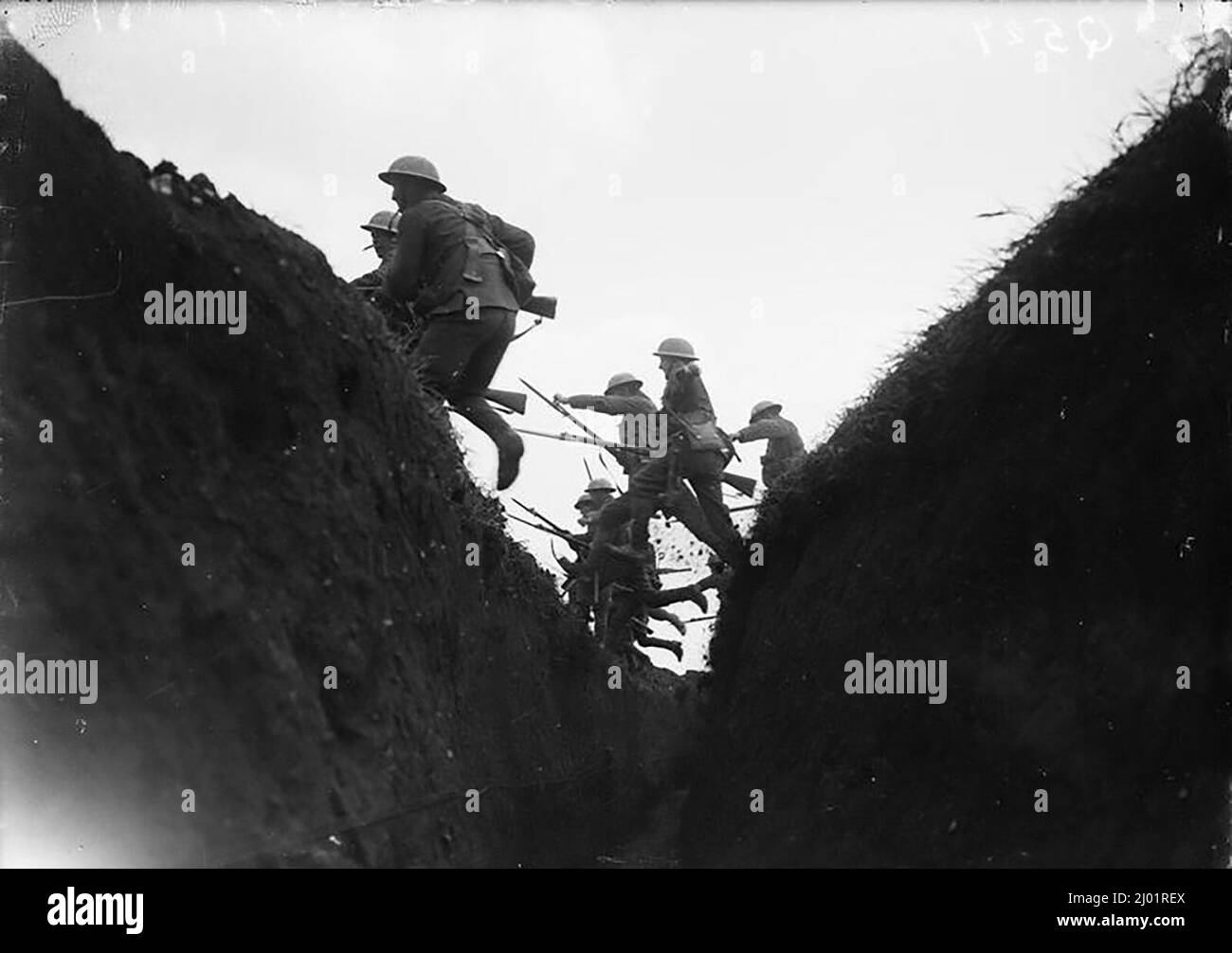 The King's Liverpool Regiment, 55th Division, practising an attack near Blaireville, Wailly, 16th April 1916. Stock Photohttps://www.alamy.com/image-license-details/?v=1https://www.alamy.com/the-kings-liverpool-regiment-55th-division-practising-an-attack-near-blaireville-wailly-16th-april-1916-image464720338.html
The King's Liverpool Regiment, 55th Division, practising an attack near Blaireville, Wailly, 16th April 1916. Stock Photohttps://www.alamy.com/image-license-details/?v=1https://www.alamy.com/the-kings-liverpool-regiment-55th-division-practising-an-attack-near-blaireville-wailly-16th-april-1916-image464720338.htmlRM2J01REX–The King's Liverpool Regiment, 55th Division, practising an attack near Blaireville, Wailly, 16th April 1916.
 U.S. Marines in France building fortifications under the guidance of French instructors. They are passing sandbags filled with foil material used to strengthen the trenches. The marines are hidden from the enemy's sight, while being observed by their fellow Americans. Some American marines can be seen at the top of the trench, wearing leggings. Alpine chasseurs are assisting as instructors in the training process. NOTE: Photograph received on November 11, 1918, assigned number 2122. Stock Photohttps://www.alamy.com/image-license-details/?v=1https://www.alamy.com/us-marines-in-france-building-fortifications-under-the-guidance-of-french-instructors-they-are-passing-sandbags-filled-with-foil-material-used-to-strengthen-the-trenches-the-marines-are-hidden-from-the-enemys-sight-while-being-observed-by-their-fellow-americans-some-american-marines-can-be-seen-at-the-top-of-the-trench-wearing-leggings-alpine-chasseurs-are-assisting-as-instructors-in-the-training-process-note-photograph-received-on-november-11-1918-assigned-number-2122-image558143860.html
U.S. Marines in France building fortifications under the guidance of French instructors. They are passing sandbags filled with foil material used to strengthen the trenches. The marines are hidden from the enemy's sight, while being observed by their fellow Americans. Some American marines can be seen at the top of the trench, wearing leggings. Alpine chasseurs are assisting as instructors in the training process. NOTE: Photograph received on November 11, 1918, assigned number 2122. Stock Photohttps://www.alamy.com/image-license-details/?v=1https://www.alamy.com/us-marines-in-france-building-fortifications-under-the-guidance-of-french-instructors-they-are-passing-sandbags-filled-with-foil-material-used-to-strengthen-the-trenches-the-marines-are-hidden-from-the-enemys-sight-while-being-observed-by-their-fellow-americans-some-american-marines-can-be-seen-at-the-top-of-the-trench-wearing-leggings-alpine-chasseurs-are-assisting-as-instructors-in-the-training-process-note-photograph-received-on-november-11-1918-assigned-number-2122-image558143860.htmlRM2RC1J58–U.S. Marines in France building fortifications under the guidance of French instructors. They are passing sandbags filled with foil material used to strengthen the trenches. The marines are hidden from the enemy's sight, while being observed by their fellow Americans. Some American marines can be seen at the top of the trench, wearing leggings. Alpine chasseurs are assisting as instructors in the training process. NOTE: Photograph received on November 11, 1918, assigned number 2122.
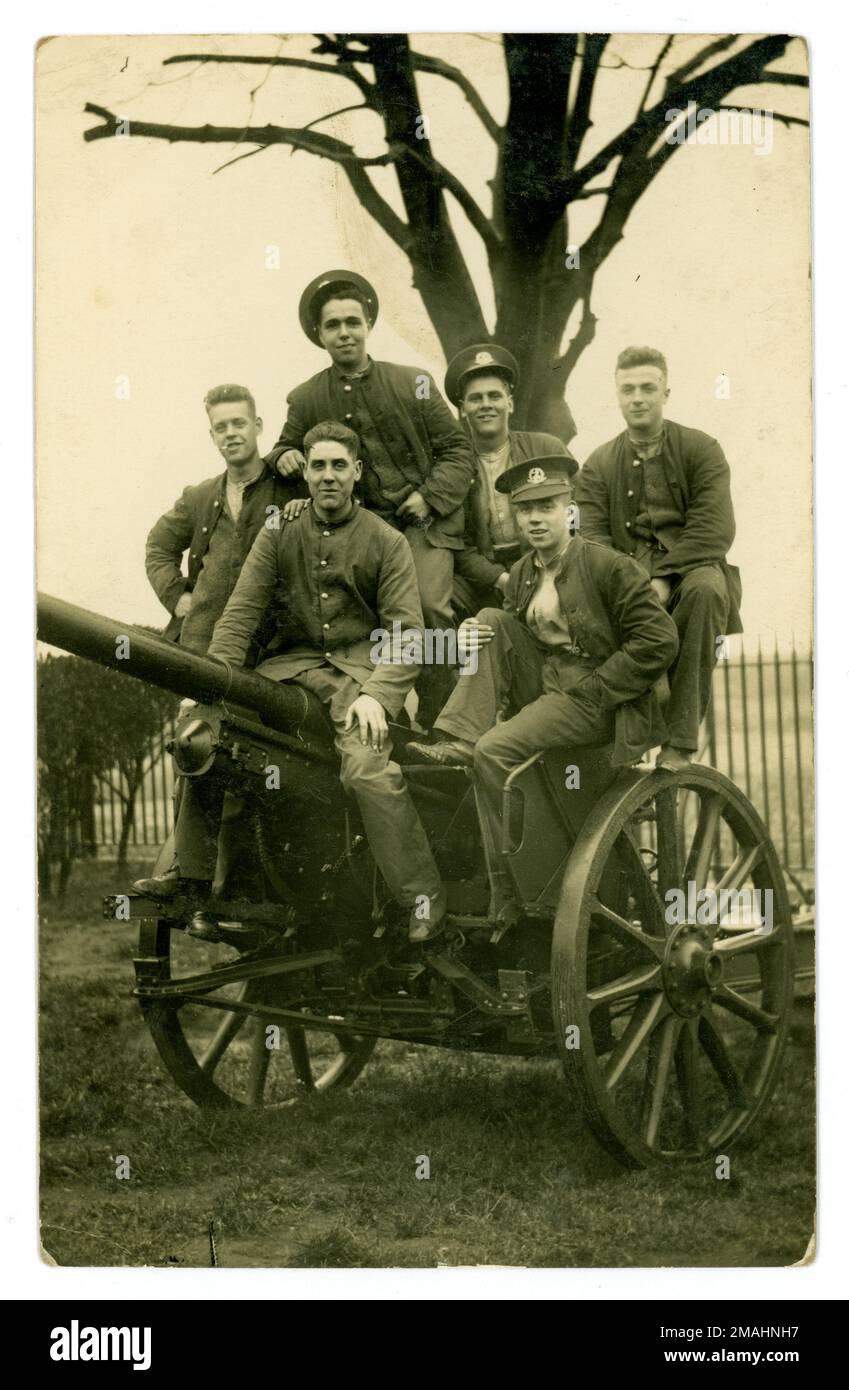 Original WW1 era postcard of a group of young men of the Royal Norfolk Regiment messing about on top of a field gun at a training camp. A rare photograph of young men about to be sent to the front, excited to be leaving home, before they know the horrors of the trenches. Cannon fodder. Circa 1916 U.K. Stock Photohttps://www.alamy.com/image-license-details/?v=1https://www.alamy.com/original-ww1-era-postcard-of-a-group-of-young-men-of-the-royal-norfolk-regiment-messing-about-on-top-of-a-field-gun-at-a-training-camp-a-rare-photograph-of-young-men-about-to-be-sent-to-the-front-excited-to-be-leaving-home-before-they-know-the-horrors-of-the-trenches-cannon-fodder-circa-1916-uk-image505637363.html
Original WW1 era postcard of a group of young men of the Royal Norfolk Regiment messing about on top of a field gun at a training camp. A rare photograph of young men about to be sent to the front, excited to be leaving home, before they know the horrors of the trenches. Cannon fodder. Circa 1916 U.K. Stock Photohttps://www.alamy.com/image-license-details/?v=1https://www.alamy.com/original-ww1-era-postcard-of-a-group-of-young-men-of-the-royal-norfolk-regiment-messing-about-on-top-of-a-field-gun-at-a-training-camp-a-rare-photograph-of-young-men-about-to-be-sent-to-the-front-excited-to-be-leaving-home-before-they-know-the-horrors-of-the-trenches-cannon-fodder-circa-1916-uk-image505637363.htmlRM2MAHNH7–Original WW1 era postcard of a group of young men of the Royal Norfolk Regiment messing about on top of a field gun at a training camp. A rare photograph of young men about to be sent to the front, excited to be leaving home, before they know the horrors of the trenches. Cannon fodder. Circa 1916 U.K.
 Soldiers prepare to go over the top from the trench during the Battle of the Somme, also known as the Somme Offensive. It was a battle of the First World War fought by the armies of the British Empire and French Third Republic against the German Empire and took place between 1 July and 18 November 1916 on both sides of the upper reaches of the River Somme in France. The battle was intended to hasten a victory for the Allies. More than three million men fought in the battle and one million men were wounded or killed, making it one of the deadliest battles in human history. Stock Photohttps://www.alamy.com/image-license-details/?v=1https://www.alamy.com/soldiers-prepare-to-go-over-the-top-from-the-trench-during-the-battle-of-the-somme-also-known-as-the-somme-offensive-it-was-a-battle-of-the-first-world-war-fought-by-the-armies-of-the-british-empire-and-french-third-republic-against-the-german-empire-and-took-place-between-1-july-and-18-november-1916-on-both-sides-of-the-upper-reaches-of-the-river-somme-in-france-the-battle-was-intended-to-hasten-a-victory-for-the-allies-more-than-three-million-men-fought-in-the-battle-and-one-million-men-were-wounded-or-killed-making-it-one-of-the-deadliest-battles-in-human-history-image409745333.html
Soldiers prepare to go over the top from the trench during the Battle of the Somme, also known as the Somme Offensive. It was a battle of the First World War fought by the armies of the British Empire and French Third Republic against the German Empire and took place between 1 July and 18 November 1916 on both sides of the upper reaches of the River Somme in France. The battle was intended to hasten a victory for the Allies. More than three million men fought in the battle and one million men were wounded or killed, making it one of the deadliest battles in human history. Stock Photohttps://www.alamy.com/image-license-details/?v=1https://www.alamy.com/soldiers-prepare-to-go-over-the-top-from-the-trench-during-the-battle-of-the-somme-also-known-as-the-somme-offensive-it-was-a-battle-of-the-first-world-war-fought-by-the-armies-of-the-british-empire-and-french-third-republic-against-the-german-empire-and-took-place-between-1-july-and-18-november-1916-on-both-sides-of-the-upper-reaches-of-the-river-somme-in-france-the-battle-was-intended-to-hasten-a-victory-for-the-allies-more-than-three-million-men-fought-in-the-battle-and-one-million-men-were-wounded-or-killed-making-it-one-of-the-deadliest-battles-in-human-history-image409745333.htmlRM2EPHE9W–Soldiers prepare to go over the top from the trench during the Battle of the Somme, also known as the Somme Offensive. It was a battle of the First World War fought by the armies of the British Empire and French Third Republic against the German Empire and took place between 1 July and 18 November 1916 on both sides of the upper reaches of the River Somme in France. The battle was intended to hasten a victory for the Allies. More than three million men fought in the battle and one million men were wounded or killed, making it one of the deadliest battles in human history.
 The Great British Advance in the West - Raiding party leaves the trenches - Western front, World War I Stock Photohttps://www.alamy.com/image-license-details/?v=1https://www.alamy.com/stock-photo-the-great-british-advance-in-the-west-raiding-party-leaves-the-trenches-81292053.html
The Great British Advance in the West - Raiding party leaves the trenches - Western front, World War I Stock Photohttps://www.alamy.com/image-license-details/?v=1https://www.alamy.com/stock-photo-the-great-british-advance-in-the-west-raiding-party-leaves-the-trenches-81292053.htmlRMEM74RH–The Great British Advance in the West - Raiding party leaves the trenches - Western front, World War I
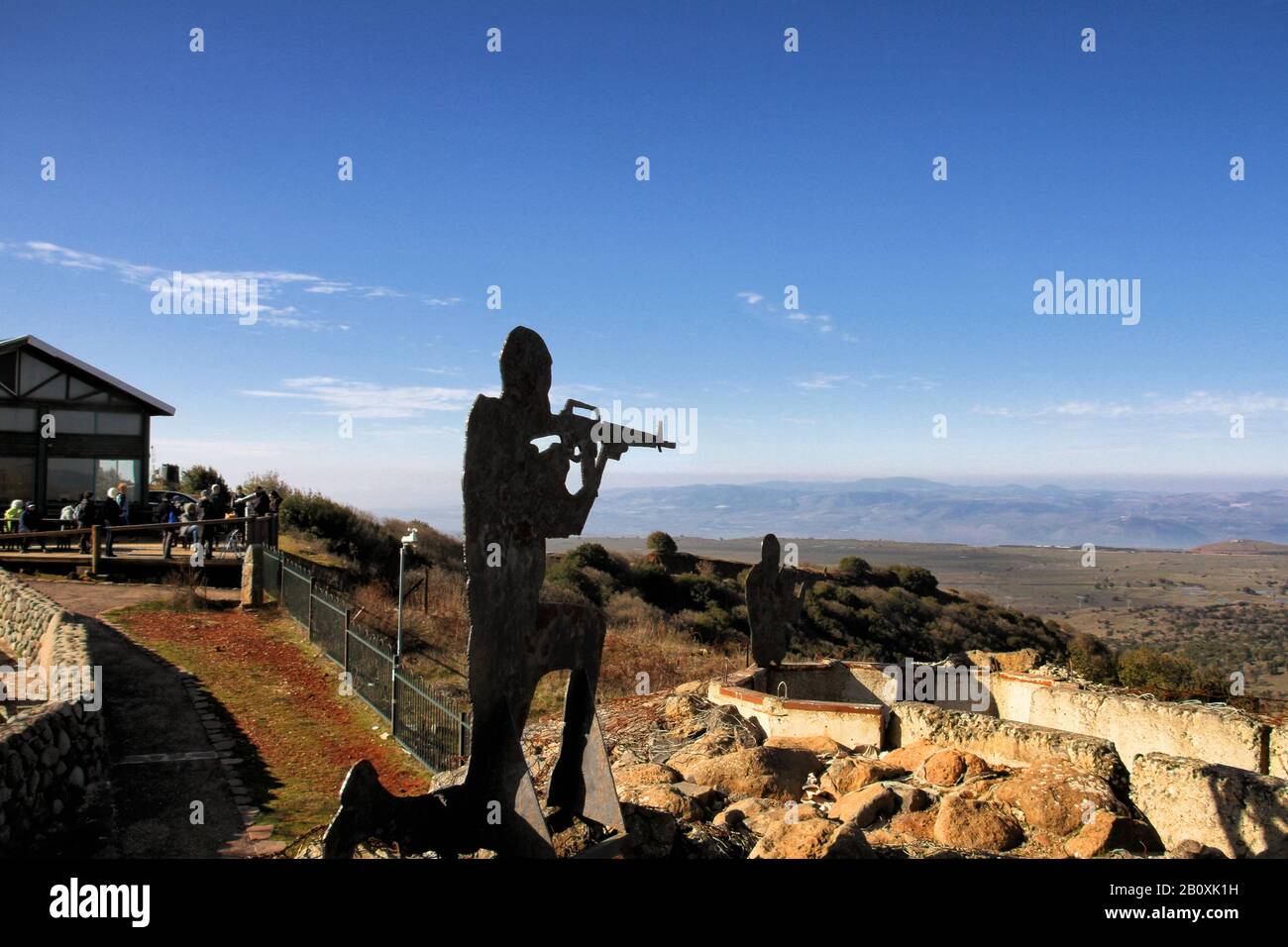 A metal soldier silhouette kneels near the trenches on top of Mount Bental in Israel's Golan Heights, with a view toward Kibbutz Merom Golan. Stock Photohttps://www.alamy.com/image-license-details/?v=1https://www.alamy.com/a-metal-soldier-silhouette-kneels-near-the-trenches-on-top-of-mount-bental-in-israels-golan-heights-with-a-view-toward-kibbutz-merom-golan-image344793053.html
A metal soldier silhouette kneels near the trenches on top of Mount Bental in Israel's Golan Heights, with a view toward Kibbutz Merom Golan. Stock Photohttps://www.alamy.com/image-license-details/?v=1https://www.alamy.com/a-metal-soldier-silhouette-kneels-near-the-trenches-on-top-of-mount-bental-in-israels-golan-heights-with-a-view-toward-kibbutz-merom-golan-image344793053.htmlRM2B0XK1H–A metal soldier silhouette kneels near the trenches on top of Mount Bental in Israel's Golan Heights, with a view toward Kibbutz Merom Golan.
 Italian trench of the Great War towards the top of Mount La Sisilla. Piccole Dolomiti, Recoaro Terme, Vicenza province, Veneto, Italy, Europe. Stock Photohttps://www.alamy.com/image-license-details/?v=1https://www.alamy.com/italian-trench-of-the-great-war-towards-the-top-of-mount-la-sisilla-piccole-dolomiti-recoaro-terme-vicenza-province-veneto-italy-europe-image344395020.html
Italian trench of the Great War towards the top of Mount La Sisilla. Piccole Dolomiti, Recoaro Terme, Vicenza province, Veneto, Italy, Europe. Stock Photohttps://www.alamy.com/image-license-details/?v=1https://www.alamy.com/italian-trench-of-the-great-war-towards-the-top-of-mount-la-sisilla-piccole-dolomiti-recoaro-terme-vicenza-province-veneto-italy-europe-image344395020.htmlRM2B08FA4–Italian trench of the Great War towards the top of Mount La Sisilla. Piccole Dolomiti, Recoaro Terme, Vicenza province, Veneto, Italy, Europe.
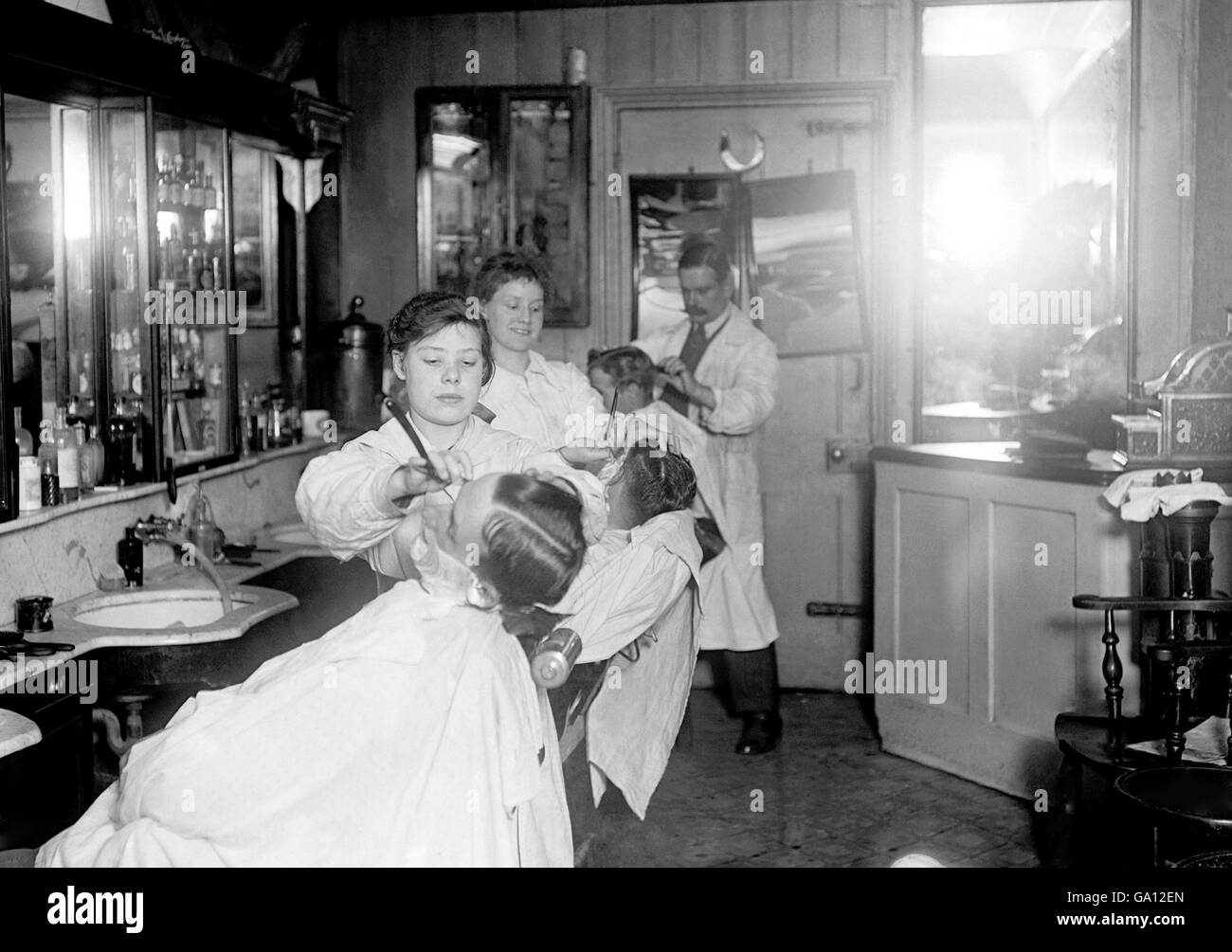 A fifteen year old girl works in a barber's shop near to Waterloo Station. Women were encouraged to take on roles traditionally reserved for men, as many of the men were away fighting in the trenches. Stock Photohttps://www.alamy.com/image-license-details/?v=1https://www.alamy.com/stock-photo-a-fifteen-year-old-girl-works-in-a-barbers-shop-near-to-waterloo-station-109432701.html
A fifteen year old girl works in a barber's shop near to Waterloo Station. Women were encouraged to take on roles traditionally reserved for men, as many of the men were away fighting in the trenches. Stock Photohttps://www.alamy.com/image-license-details/?v=1https://www.alamy.com/stock-photo-a-fifteen-year-old-girl-works-in-a-barbers-shop-near-to-waterloo-station-109432701.htmlRMGA12EN–A fifteen year old girl works in a barber's shop near to Waterloo Station. Women were encouraged to take on roles traditionally reserved for men, as many of the men were away fighting in the trenches.
 The Salonica front Description: Shell bursting. Top of British trench in immediate foreground Annotation: The front at Salonika. Exploding grenade on top of a British trench in the foreground Date: {1914-1918} Location: Greece, Thessaloniki Keywords: WWI, fronts, trenches, explosions Stock Photohttps://www.alamy.com/image-license-details/?v=1https://www.alamy.com/the-salonica-front-description-shell-bursting-top-of-british-trench-in-immediate-foreground-annotation-the-front-at-salonika-exploding-grenade-on-top-of-a-british-trench-in-the-foreground-date-1914-1918-location-greece-thessaloniki-keywords-wwi-fronts-trenches-explosions-image342159732.html
The Salonica front Description: Shell bursting. Top of British trench in immediate foreground Annotation: The front at Salonika. Exploding grenade on top of a British trench in the foreground Date: {1914-1918} Location: Greece, Thessaloniki Keywords: WWI, fronts, trenches, explosions Stock Photohttps://www.alamy.com/image-license-details/?v=1https://www.alamy.com/the-salonica-front-description-shell-bursting-top-of-british-trench-in-immediate-foreground-annotation-the-front-at-salonika-exploding-grenade-on-top-of-a-british-trench-in-the-foreground-date-1914-1918-location-greece-thessaloniki-keywords-wwi-fronts-trenches-explosions-image342159732.htmlRM2ATJM6C–The Salonica front Description: Shell bursting. Top of British trench in immediate foreground Annotation: The front at Salonika. Exploding grenade on top of a British trench in the foreground Date: {1914-1918} Location: Greece, Thessaloniki Keywords: WWI, fronts, trenches, explosions
 Soldiers advancing over the trenches during a battle in WW1. This photograph, titled 'Doughboys going over the top,' was taken by Pvt. Berhens and drawn by Captain Dunn, an official American military artist. The date of the photograph is not specified. Stock Photohttps://www.alamy.com/image-license-details/?v=1https://www.alamy.com/soldiers-advancing-over-the-trenches-during-a-battle-in-ww1-this-photograph-titled-doughboys-going-over-the-top-was-taken-by-pvt-berhens-and-drawn-by-captain-dunn-an-official-american-military-artist-the-date-of-the-photograph-is-not-specified-image558578576.html
Soldiers advancing over the trenches during a battle in WW1. This photograph, titled 'Doughboys going over the top,' was taken by Pvt. Berhens and drawn by Captain Dunn, an official American military artist. The date of the photograph is not specified. Stock Photohttps://www.alamy.com/image-license-details/?v=1https://www.alamy.com/soldiers-advancing-over-the-trenches-during-a-battle-in-ww1-this-photograph-titled-doughboys-going-over-the-top-was-taken-by-pvt-berhens-and-drawn-by-captain-dunn-an-official-american-military-artist-the-date-of-the-photograph-is-not-specified-image558578576.htmlRM2RCNCJT–Soldiers advancing over the trenches during a battle in WW1. This photograph, titled 'Doughboys going over the top,' was taken by Pvt. Berhens and drawn by Captain Dunn, an official American military artist. The date of the photograph is not specified.
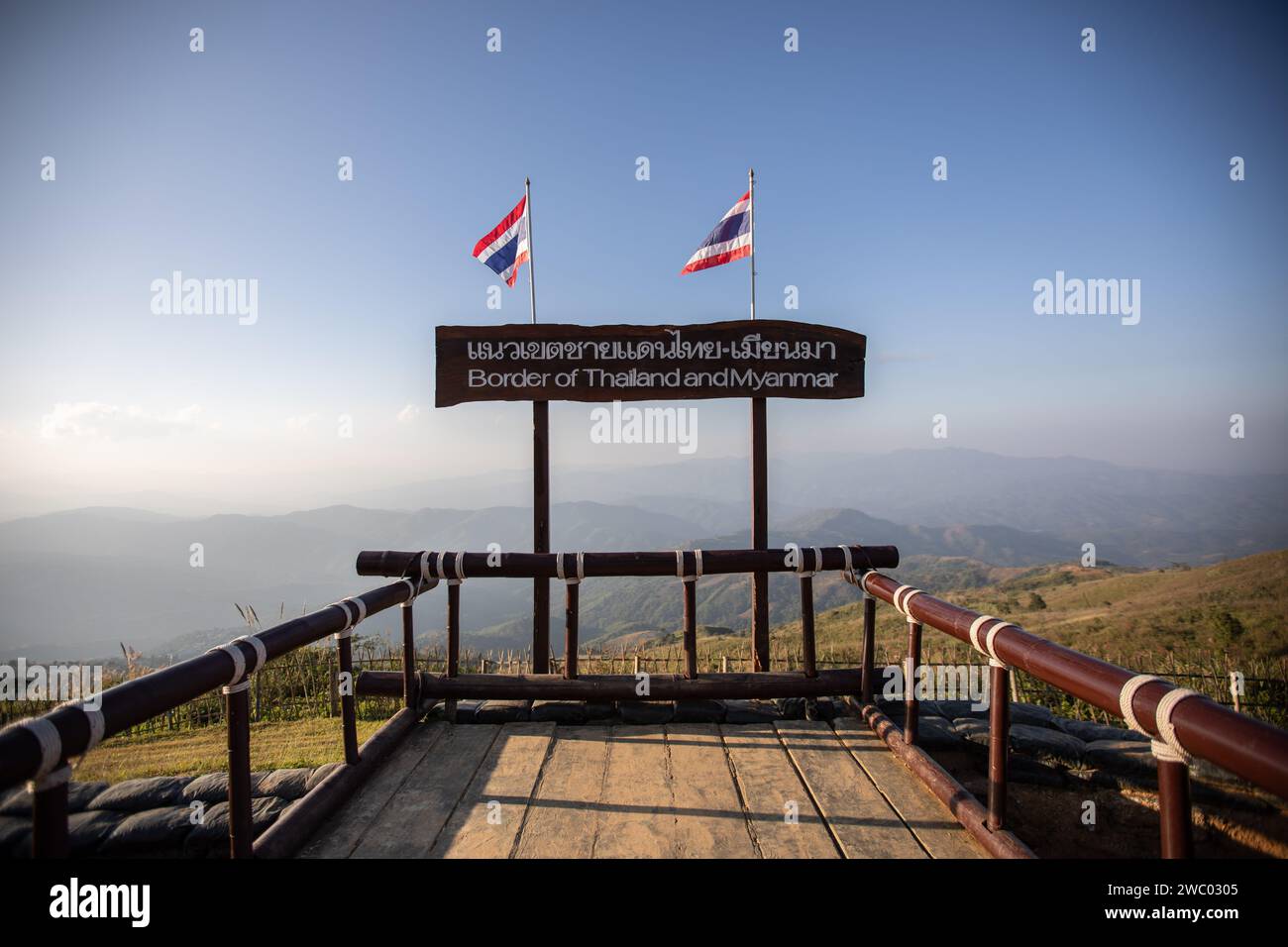 A sign depicting the Thai-Myanmar border with Thailand flags on top. The Chang Moob Military Outpost now turned into a tourist attraction spot, used to be a Thai Royal Army location to prevent drug smuggling and keep an eye on other suspicious activities on the Myanmar side (mostly in the 1990s). Also called the 'Doi Tung Trenches' It starts off with a narrow pathway through high bamboo fences before reaching the main spot with deep trenches along the northernmost sections of the Thai-Myanmar border, with a stunning view of Myanmar mountains. Stock Photohttps://www.alamy.com/image-license-details/?v=1https://www.alamy.com/a-sign-depicting-the-thai-myanmar-border-with-thailand-flags-on-top-the-chang-moob-military-outpost-now-turned-into-a-tourist-attraction-spot-used-to-be-a-thai-royal-army-location-to-prevent-drug-smuggling-and-keep-an-eye-on-other-suspicious-activities-on-the-myanmar-side-mostly-in-the-1990s-also-called-the-doi-tung-trenches-it-starts-off-with-a-narrow-pathway-through-high-bamboo-fences-before-reaching-the-main-spot-with-deep-trenches-along-the-northernmost-sections-of-the-thai-myanmar-border-with-a-stunning-view-of-myanmar-mountains-image592530741.html
A sign depicting the Thai-Myanmar border with Thailand flags on top. The Chang Moob Military Outpost now turned into a tourist attraction spot, used to be a Thai Royal Army location to prevent drug smuggling and keep an eye on other suspicious activities on the Myanmar side (mostly in the 1990s). Also called the 'Doi Tung Trenches' It starts off with a narrow pathway through high bamboo fences before reaching the main spot with deep trenches along the northernmost sections of the Thai-Myanmar border, with a stunning view of Myanmar mountains. Stock Photohttps://www.alamy.com/image-license-details/?v=1https://www.alamy.com/a-sign-depicting-the-thai-myanmar-border-with-thailand-flags-on-top-the-chang-moob-military-outpost-now-turned-into-a-tourist-attraction-spot-used-to-be-a-thai-royal-army-location-to-prevent-drug-smuggling-and-keep-an-eye-on-other-suspicious-activities-on-the-myanmar-side-mostly-in-the-1990s-also-called-the-doi-tung-trenches-it-starts-off-with-a-narrow-pathway-through-high-bamboo-fences-before-reaching-the-main-spot-with-deep-trenches-along-the-northernmost-sections-of-the-thai-myanmar-border-with-a-stunning-view-of-myanmar-mountains-image592530741.htmlRM2WC0305–A sign depicting the Thai-Myanmar border with Thailand flags on top. The Chang Moob Military Outpost now turned into a tourist attraction spot, used to be a Thai Royal Army location to prevent drug smuggling and keep an eye on other suspicious activities on the Myanmar side (mostly in the 1990s). Also called the 'Doi Tung Trenches' It starts off with a narrow pathway through high bamboo fences before reaching the main spot with deep trenches along the northernmost sections of the Thai-Myanmar border, with a stunning view of Myanmar mountains.
 American soldiers emerge from their trenches, the first troops to go over the top during the Cantigny Battle, France, August 1, 1918. This capture marks the initial major victory for the American military in Europe. Photographer: Inter. Film Ser. (Image: 111-SC-20705) Stock Photohttps://www.alamy.com/image-license-details/?v=1https://www.alamy.com/american-soldiers-emerge-from-their-trenches-the-first-troops-to-go-over-the-top-during-the-cantigny-battle-france-august-1-1918-this-capture-marks-the-initial-major-victory-for-the-american-military-in-europe-photographer-inter-film-ser-image-111-sc-20705-image558569814.html
American soldiers emerge from their trenches, the first troops to go over the top during the Cantigny Battle, France, August 1, 1918. This capture marks the initial major victory for the American military in Europe. Photographer: Inter. Film Ser. (Image: 111-SC-20705) Stock Photohttps://www.alamy.com/image-license-details/?v=1https://www.alamy.com/american-soldiers-emerge-from-their-trenches-the-first-troops-to-go-over-the-top-during-the-cantigny-battle-france-august-1-1918-this-capture-marks-the-initial-major-victory-for-the-american-military-in-europe-photographer-inter-film-ser-image-111-sc-20705-image558569814.htmlRM2RCN1DX–American soldiers emerge from their trenches, the first troops to go over the top during the Cantigny Battle, France, August 1, 1918. This capture marks the initial major victory for the American military in Europe. Photographer: Inter. Film Ser. (Image: 111-SC-20705)
 Going over the top. Recreation of life in the trenches of World War One at the Imperial War Museum, London, UK. Stock Photohttps://www.alamy.com/image-license-details/?v=1https://www.alamy.com/stock-photo-going-over-the-top-recreation-of-life-in-the-trenches-of-world-war-31517245.html
Going over the top. Recreation of life in the trenches of World War One at the Imperial War Museum, London, UK. Stock Photohttps://www.alamy.com/image-license-details/?v=1https://www.alamy.com/stock-photo-going-over-the-top-recreation-of-life-in-the-trenches-of-world-war-31517245.htmlRMBR7MFW–Going over the top. Recreation of life in the trenches of World War One at the Imperial War Museum, London, UK.
 Sgt. Paul W. Cloud standing at the top of a hill near Fliry, France on September 24, 1918. This location was where the Germans were defeated on September 12, 1918. A small American cemetery can be seen in front of the trenches to the left. This photograph was taken during World War I. Stock Photohttps://www.alamy.com/image-license-details/?v=1https://www.alamy.com/sgt-paul-w-cloud-standing-at-the-top-of-a-hill-near-fliry-france-on-september-24-1918-this-location-was-where-the-germans-were-defeated-on-september-12-1918-a-small-american-cemetery-can-be-seen-in-front-of-the-trenches-to-the-left-this-photograph-was-taken-during-world-war-i-image558549585.html
Sgt. Paul W. Cloud standing at the top of a hill near Fliry, France on September 24, 1918. This location was where the Germans were defeated on September 12, 1918. A small American cemetery can be seen in front of the trenches to the left. This photograph was taken during World War I. Stock Photohttps://www.alamy.com/image-license-details/?v=1https://www.alamy.com/sgt-paul-w-cloud-standing-at-the-top-of-a-hill-near-fliry-france-on-september-24-1918-this-location-was-where-the-germans-were-defeated-on-september-12-1918-a-small-american-cemetery-can-be-seen-in-front-of-the-trenches-to-the-left-this-photograph-was-taken-during-world-war-i-image558549585.htmlRM2RCM3KD–Sgt. Paul W. Cloud standing at the top of a hill near Fliry, France on September 24, 1918. This location was where the Germans were defeated on September 12, 1918. A small American cemetery can be seen in front of the trenches to the left. This photograph was taken during World War I.
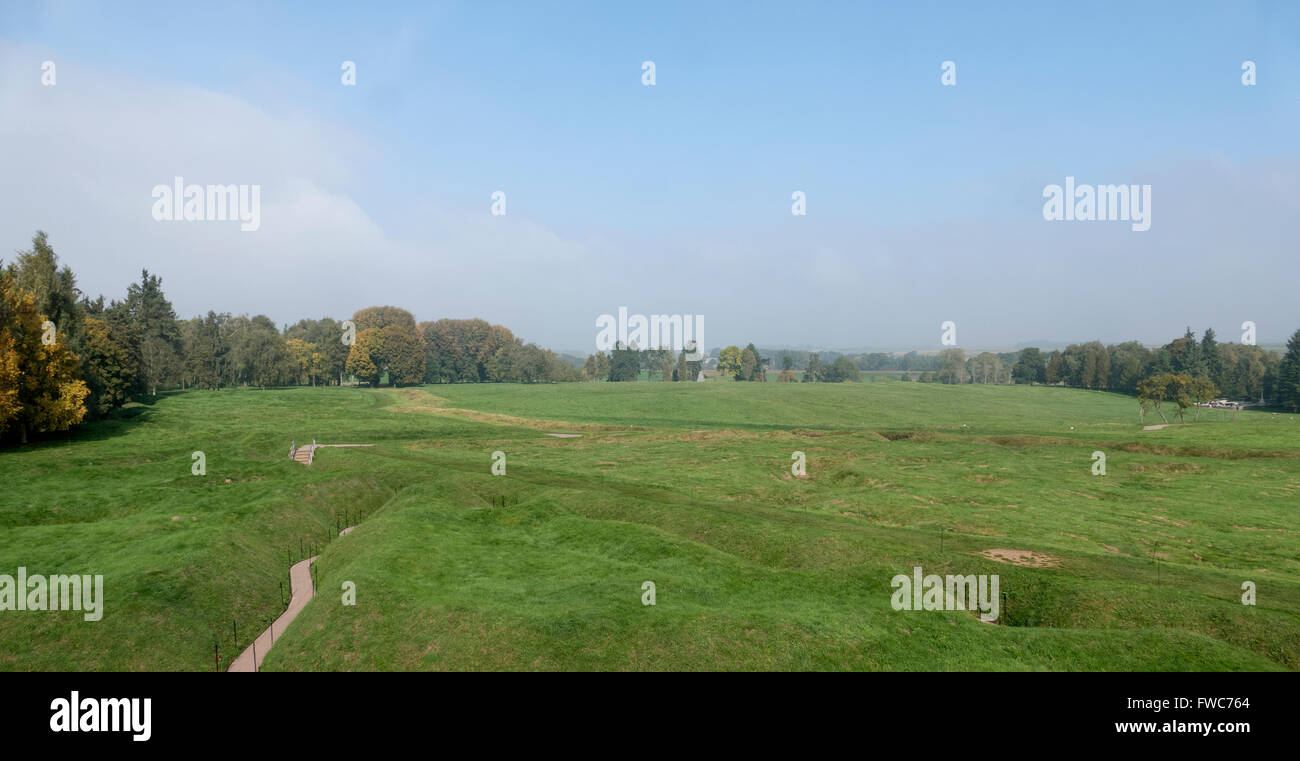 Remains of Canadian Army trenches (bottom) and German army trenches (top). No-mans land spanned only a few yards. Stock Photohttps://www.alamy.com/image-license-details/?v=1https://www.alamy.com/stock-photo-remains-of-canadian-army-trenches-bottom-and-german-army-trenches-101687324.html
Remains of Canadian Army trenches (bottom) and German army trenches (top). No-mans land spanned only a few yards. Stock Photohttps://www.alamy.com/image-license-details/?v=1https://www.alamy.com/stock-photo-remains-of-canadian-army-trenches-bottom-and-german-army-trenches-101687324.htmlRMFWC764–Remains of Canadian Army trenches (bottom) and German army trenches (top). No-mans land spanned only a few yards.
 World War I British troops charging from the trenches 4402 B45 The trenches of World War I have given us some of the most horrific images of the twentieth century By the latter stages of the war the trenches had devloped from small dug outs like this one into a massive network of trenches across the Western Front Millions of men died going over the top during World War I Many men didn t even reach the top of the trench before an enemy bullet cut them down The trenches were littered with corpses and fragments of human debris They were cold and wet and the mud turned to swamp by the incescant Stock Photohttps://www.alamy.com/image-license-details/?v=1https://www.alamy.com/stock-photo-world-war-i-british-troops-charging-from-the-trenches-4402-b45-the-20229213.html
World War I British troops charging from the trenches 4402 B45 The trenches of World War I have given us some of the most horrific images of the twentieth century By the latter stages of the war the trenches had devloped from small dug outs like this one into a massive network of trenches across the Western Front Millions of men died going over the top during World War I Many men didn t even reach the top of the trench before an enemy bullet cut them down The trenches were littered with corpses and fragments of human debris They were cold and wet and the mud turned to swamp by the incescant Stock Photohttps://www.alamy.com/image-license-details/?v=1https://www.alamy.com/stock-photo-world-war-i-british-troops-charging-from-the-trenches-4402-b45-the-20229213.htmlRMB4WEFW–World War I British troops charging from the trenches 4402 B45 The trenches of World War I have given us some of the most horrific images of the twentieth century By the latter stages of the war the trenches had devloped from small dug outs like this one into a massive network of trenches across the Western Front Millions of men died going over the top during World War I Many men didn t even reach the top of the trench before an enemy bullet cut them down The trenches were littered with corpses and fragments of human debris They were cold and wet and the mud turned to swamp by the incescant
 Belgian infantry soldiers advancing in the trenches during World War I. They are seen going 'over the top,' meaning they are leaving the relative safety of the trenches to charge towards enemy lines. This photograph was taken by an official Belgian photographer and received by the Synsol Bo studio. The description and notes provide limited additional information. Stock Photohttps://www.alamy.com/image-license-details/?v=1https://www.alamy.com/belgian-infantry-soldiers-advancing-in-the-trenches-during-world-war-i-they-are-seen-going-over-the-top-meaning-they-are-leaving-the-relative-safety-of-the-trenches-to-charge-towards-enemy-lines-this-photograph-was-taken-by-an-official-belgian-photographer-and-received-by-the-synsol-bo-studio-the-description-and-notes-provide-limited-additional-information-image558445205.html
Belgian infantry soldiers advancing in the trenches during World War I. They are seen going 'over the top,' meaning they are leaving the relative safety of the trenches to charge towards enemy lines. This photograph was taken by an official Belgian photographer and received by the Synsol Bo studio. The description and notes provide limited additional information. Stock Photohttps://www.alamy.com/image-license-details/?v=1https://www.alamy.com/belgian-infantry-soldiers-advancing-in-the-trenches-during-world-war-i-they-are-seen-going-over-the-top-meaning-they-are-leaving-the-relative-safety-of-the-trenches-to-charge-towards-enemy-lines-this-photograph-was-taken-by-an-official-belgian-photographer-and-received-by-the-synsol-bo-studio-the-description-and-notes-provide-limited-additional-information-image558445205.htmlRM2RCFAFH–Belgian infantry soldiers advancing in the trenches during World War I. They are seen going 'over the top,' meaning they are leaving the relative safety of the trenches to charge towards enemy lines. This photograph was taken by an official Belgian photographer and received by the Synsol Bo studio. The description and notes provide limited additional information.
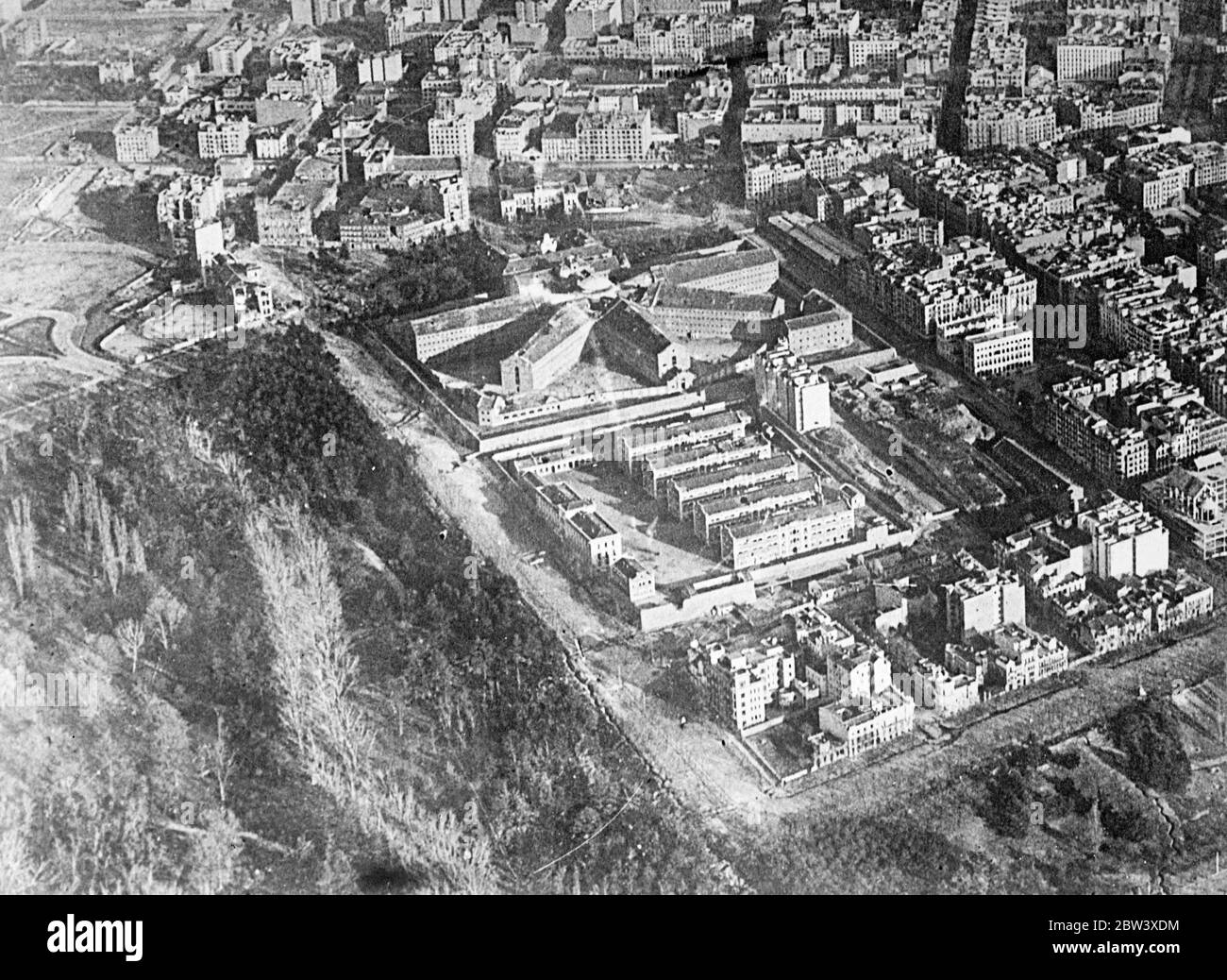 The Madrid battle front from the air . These aeial pictures give a vivid impression of the Madrid battle line where since the beginning of last November , when General Franco first laid siege to the capital , Government defenders and rebel attackers have have launched attack and counter attack in the net work of trenches and defence works on the fringe of the city . Photo shows , an aerial view of the north western battle zone of Madrid . the star shaped building in centre is the Model Prison . The trees on left are the West Park . trenches can be seen in the open space top left . 30 March 193 Stock Photohttps://www.alamy.com/image-license-details/?v=1https://www.alamy.com/the-madrid-battle-front-from-the-air-these-aeial-pictures-give-a-vivid-impression-of-the-madrid-battle-line-where-since-the-beginning-of-last-november-when-general-franco-first-laid-siege-to-the-capital-government-defenders-and-rebel-attackers-have-have-launched-attack-and-counter-attack-in-the-net-work-of-trenches-and-defence-works-on-the-fringe-of-the-city-photo-shows-an-aerial-view-of-the-north-western-battle-zone-of-madrid-the-star-shaped-building-in-centre-is-the-model-prison-the-trees-on-left-are-the-west-park-trenches-can-be-seen-in-the-open-space-top-left-30-march-193-image359660384.html
The Madrid battle front from the air . These aeial pictures give a vivid impression of the Madrid battle line where since the beginning of last November , when General Franco first laid siege to the capital , Government defenders and rebel attackers have have launched attack and counter attack in the net work of trenches and defence works on the fringe of the city . Photo shows , an aerial view of the north western battle zone of Madrid . the star shaped building in centre is the Model Prison . The trees on left are the West Park . trenches can be seen in the open space top left . 30 March 193 Stock Photohttps://www.alamy.com/image-license-details/?v=1https://www.alamy.com/the-madrid-battle-front-from-the-air-these-aeial-pictures-give-a-vivid-impression-of-the-madrid-battle-line-where-since-the-beginning-of-last-november-when-general-franco-first-laid-siege-to-the-capital-government-defenders-and-rebel-attackers-have-have-launched-attack-and-counter-attack-in-the-net-work-of-trenches-and-defence-works-on-the-fringe-of-the-city-photo-shows-an-aerial-view-of-the-north-western-battle-zone-of-madrid-the-star-shaped-building-in-centre-is-the-model-prison-the-trees-on-left-are-the-west-park-trenches-can-be-seen-in-the-open-space-top-left-30-march-193-image359660384.htmlRM2BW3XDM–The Madrid battle front from the air . These aeial pictures give a vivid impression of the Madrid battle line where since the beginning of last November , when General Franco first laid siege to the capital , Government defenders and rebel attackers have have launched attack and counter attack in the net work of trenches and defence works on the fringe of the city . Photo shows , an aerial view of the north western battle zone of Madrid . the star shaped building in centre is the Model Prison . The trees on left are the West Park . trenches can be seen in the open space top left . 30 March 193
 Recapture of La Bassée by Francisco de Melo, 1642, Plan de La Bassee, Attaque par les Armes de S.M. Catholique dous la Conduite de son Excellence Don Francisco de Mello, Le 21. Avriel et gaigner le 13. Mey. 1642 (title on object), Map showing the reconquest of the fortified city of La Bassée by the Spanish army under Governor Francisco de Melo on May 11 after a siege begun on April 19, 1642. At the top part of the fortified city, below the dikes and trenches constructed by the besiegers. At the top right of a rug is a map of the larger area. Bottom left the legend A-Q in French, bottom right Stock Photohttps://www.alamy.com/image-license-details/?v=1https://www.alamy.com/recapture-of-la-basse-by-francisco-de-melo-1642-plan-de-la-bassee-attaque-par-les-armes-de-sm-catholique-dous-la-conduite-de-son-excellence-don-francisco-de-mello-le-21-avriel-et-gaigner-le-13-mey-1642-title-on-object-map-showing-the-reconquest-of-the-fortified-city-of-la-basse-by-the-spanish-army-under-governor-francisco-de-melo-on-may-11-after-a-siege-begun-on-april-19-1642-at-the-top-part-of-the-fortified-city-below-the-dikes-and-trenches-constructed-by-the-besiegers-at-the-top-right-of-a-rug-is-a-map-of-the-larger-area-bottom-left-the-legend-a-q-in-french-bottom-right-image606627438.html
Recapture of La Bassée by Francisco de Melo, 1642, Plan de La Bassee, Attaque par les Armes de S.M. Catholique dous la Conduite de son Excellence Don Francisco de Mello, Le 21. Avriel et gaigner le 13. Mey. 1642 (title on object), Map showing the reconquest of the fortified city of La Bassée by the Spanish army under Governor Francisco de Melo on May 11 after a siege begun on April 19, 1642. At the top part of the fortified city, below the dikes and trenches constructed by the besiegers. At the top right of a rug is a map of the larger area. Bottom left the legend A-Q in French, bottom right Stock Photohttps://www.alamy.com/image-license-details/?v=1https://www.alamy.com/recapture-of-la-basse-by-francisco-de-melo-1642-plan-de-la-bassee-attaque-par-les-armes-de-sm-catholique-dous-la-conduite-de-son-excellence-don-francisco-de-mello-le-21-avriel-et-gaigner-le-13-mey-1642-title-on-object-map-showing-the-reconquest-of-the-fortified-city-of-la-basse-by-the-spanish-army-under-governor-francisco-de-melo-on-may-11-after-a-siege-begun-on-april-19-1642-at-the-top-part-of-the-fortified-city-below-the-dikes-and-trenches-constructed-by-the-besiegers-at-the-top-right-of-a-rug-is-a-map-of-the-larger-area-bottom-left-the-legend-a-q-in-french-bottom-right-image606627438.htmlRM2X6X7DJ–Recapture of La Bassée by Francisco de Melo, 1642, Plan de La Bassee, Attaque par les Armes de S.M. Catholique dous la Conduite de son Excellence Don Francisco de Mello, Le 21. Avriel et gaigner le 13. Mey. 1642 (title on object), Map showing the reconquest of the fortified city of La Bassée by the Spanish army under Governor Francisco de Melo on May 11 after a siege begun on April 19, 1642. At the top part of the fortified city, below the dikes and trenches constructed by the besiegers. At the top right of a rug is a map of the larger area. Bottom left the legend A-Q in French, bottom right
 Lt. Paul W. Black, S.C., photographed this image on Sept. 17, 1918, during the St. Mihiel drive. The photo shows the 2nd line trenches in the foreground and the first line on top of the hill in the distance. The location is Fliry, Meurthe et Moselle, France. This image has been censored by the A.E.P. censor, but the date of censorship is unknown. Stock Photohttps://www.alamy.com/image-license-details/?v=1https://www.alamy.com/lt-paul-w-black-sc-photographed-this-image-on-sept-17-1918-during-the-st-mihiel-drive-the-photo-shows-the-2nd-line-trenches-in-the-foreground-and-the-first-line-on-top-of-the-hill-in-the-distance-the-location-is-fliry-meurthe-et-moselle-france-this-image-has-been-censored-by-the-aep-censor-but-the-date-of-censorship-is-unknown-image558567121.html
Lt. Paul W. Black, S.C., photographed this image on Sept. 17, 1918, during the St. Mihiel drive. The photo shows the 2nd line trenches in the foreground and the first line on top of the hill in the distance. The location is Fliry, Meurthe et Moselle, France. This image has been censored by the A.E.P. censor, but the date of censorship is unknown. Stock Photohttps://www.alamy.com/image-license-details/?v=1https://www.alamy.com/lt-paul-w-black-sc-photographed-this-image-on-sept-17-1918-during-the-st-mihiel-drive-the-photo-shows-the-2nd-line-trenches-in-the-foreground-and-the-first-line-on-top-of-the-hill-in-the-distance-the-location-is-fliry-meurthe-et-moselle-france-this-image-has-been-censored-by-the-aep-censor-but-the-date-of-censorship-is-unknown-image558567121.htmlRM2RCMX1N–Lt. Paul W. Black, S.C., photographed this image on Sept. 17, 1918, during the St. Mihiel drive. The photo shows the 2nd line trenches in the foreground and the first line on top of the hill in the distance. The location is Fliry, Meurthe et Moselle, France. This image has been censored by the A.E.P. censor, but the date of censorship is unknown.
 German World War One trench mortar with the Sanctuary Wood trenches in the background. Stock Photohttps://www.alamy.com/image-license-details/?v=1https://www.alamy.com/stock-photo-german-world-war-one-trench-mortar-with-the-sanctuary-wood-trenches-54151577.html
German World War One trench mortar with the Sanctuary Wood trenches in the background. Stock Photohttps://www.alamy.com/image-license-details/?v=1https://www.alamy.com/stock-photo-german-world-war-one-trench-mortar-with-the-sanctuary-wood-trenches-54151577.htmlRMD42PTW–German World War One trench mortar with the Sanctuary Wood trenches in the background.
 General view of open storage at Int. Q.M. Depot No. 1 in Nevers, Nievre, France. The photograph, taken by Sunder Photographer Sot. G. Ryden.S.C., shows the storage area from the top of a pile of office tables. Despite the overflow of the nearby river, the low-lying land has been effectively drained through the use of trenches. This image was taken on January 8, 1919. Stock Photohttps://www.alamy.com/image-license-details/?v=1https://www.alamy.com/general-view-of-open-storage-at-int-qm-depot-no-1-in-nevers-nievre-france-the-photograph-taken-by-sunder-photographer-sot-g-rydensc-shows-the-storage-area-from-the-top-of-a-pile-of-office-tables-despite-the-overflow-of-the-nearby-river-the-low-lying-land-has-been-effectively-drained-through-the-use-of-trenches-this-image-was-taken-on-january-8-1919-image558506229.html
General view of open storage at Int. Q.M. Depot No. 1 in Nevers, Nievre, France. The photograph, taken by Sunder Photographer Sot. G. Ryden.S.C., shows the storage area from the top of a pile of office tables. Despite the overflow of the nearby river, the low-lying land has been effectively drained through the use of trenches. This image was taken on January 8, 1919. Stock Photohttps://www.alamy.com/image-license-details/?v=1https://www.alamy.com/general-view-of-open-storage-at-int-qm-depot-no-1-in-nevers-nievre-france-the-photograph-taken-by-sunder-photographer-sot-g-rydensc-shows-the-storage-area-from-the-top-of-a-pile-of-office-tables-despite-the-overflow-of-the-nearby-river-the-low-lying-land-has-been-effectively-drained-through-the-use-of-trenches-this-image-was-taken-on-january-8-1919-image558506229.htmlRM2RCJ4B1–General view of open storage at Int. Q.M. Depot No. 1 in Nevers, Nievre, France. The photograph, taken by Sunder Photographer Sot. G. Ryden.S.C., shows the storage area from the top of a pile of office tables. Despite the overflow of the nearby river, the low-lying land has been effectively drained through the use of trenches. This image was taken on January 8, 1919.
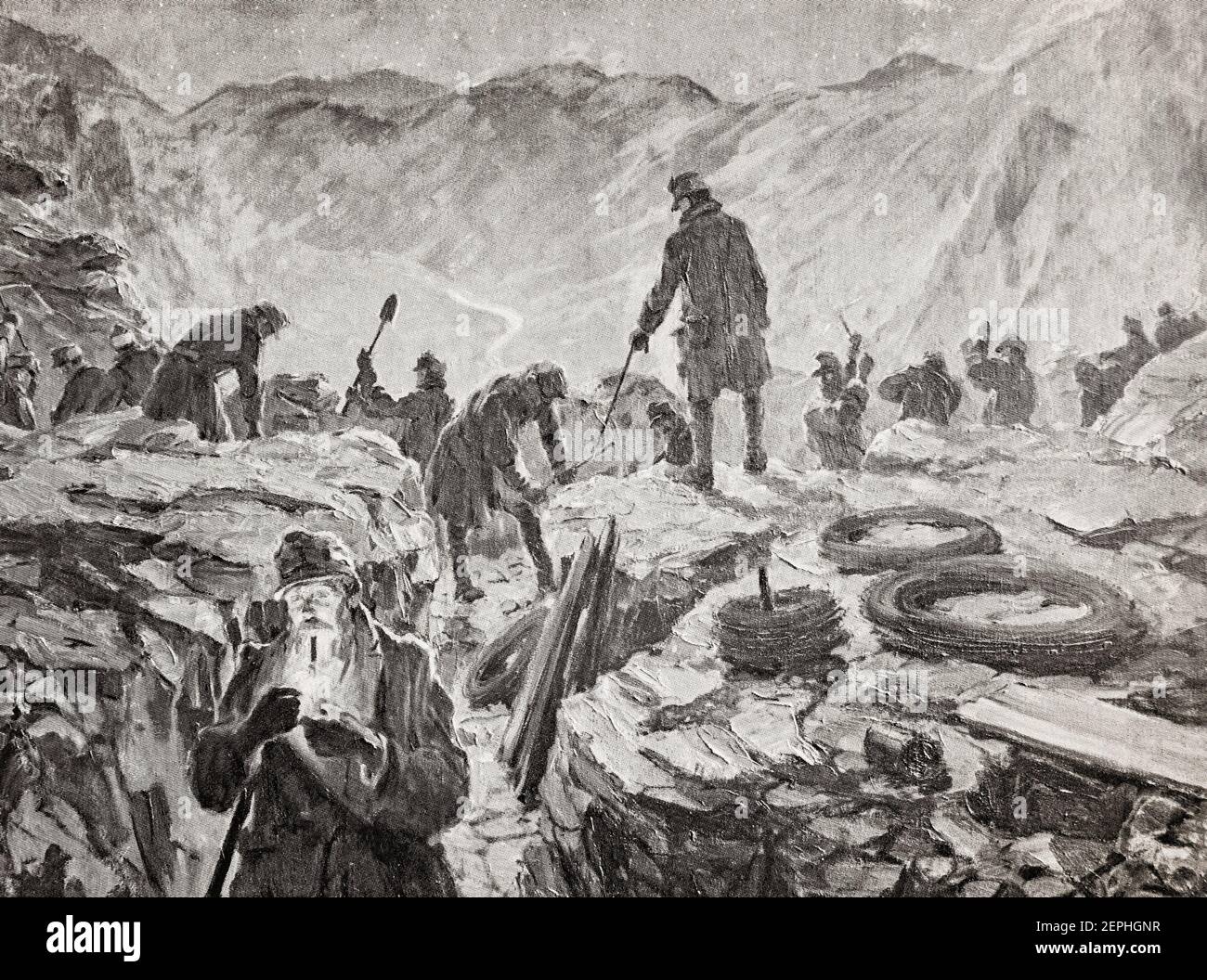 Digging trenches during the little known Dolomites front, bitterly fought over between Italy and Austria from 1915 to 1917. Because of the challenging mountain terrain, both countries had to rely on innovative methods of warfare and outstanding acts of bravery, both sides used to attack and mine tunnels that they created to help survive the harsh climates including heavy snowfall and avalanches. Stock Photohttps://www.alamy.com/image-license-details/?v=1https://www.alamy.com/digging-trenches-during-the-little-known-dolomites-front-bitterly-fought-over-between-italy-and-austria-from-1915-to-1917-because-of-the-challenging-mountain-terrain-both-countries-had-to-rely-on-innovative-methods-of-warfare-and-outstanding-acts-of-bravery-both-sides-used-to-attack-and-mine-tunnels-that-they-created-to-help-survive-the-harsh-climates-including-heavy-snowfall-and-avalanches-image409747235.html
Digging trenches during the little known Dolomites front, bitterly fought over between Italy and Austria from 1915 to 1917. Because of the challenging mountain terrain, both countries had to rely on innovative methods of warfare and outstanding acts of bravery, both sides used to attack and mine tunnels that they created to help survive the harsh climates including heavy snowfall and avalanches. Stock Photohttps://www.alamy.com/image-license-details/?v=1https://www.alamy.com/digging-trenches-during-the-little-known-dolomites-front-bitterly-fought-over-between-italy-and-austria-from-1915-to-1917-because-of-the-challenging-mountain-terrain-both-countries-had-to-rely-on-innovative-methods-of-warfare-and-outstanding-acts-of-bravery-both-sides-used-to-attack-and-mine-tunnels-that-they-created-to-help-survive-the-harsh-climates-including-heavy-snowfall-and-avalanches-image409747235.htmlRM2EPHGNR–Digging trenches during the little known Dolomites front, bitterly fought over between Italy and Austria from 1915 to 1917. Because of the challenging mountain terrain, both countries had to rely on innovative methods of warfare and outstanding acts of bravery, both sides used to attack and mine tunnels that they created to help survive the harsh climates including heavy snowfall and avalanches.
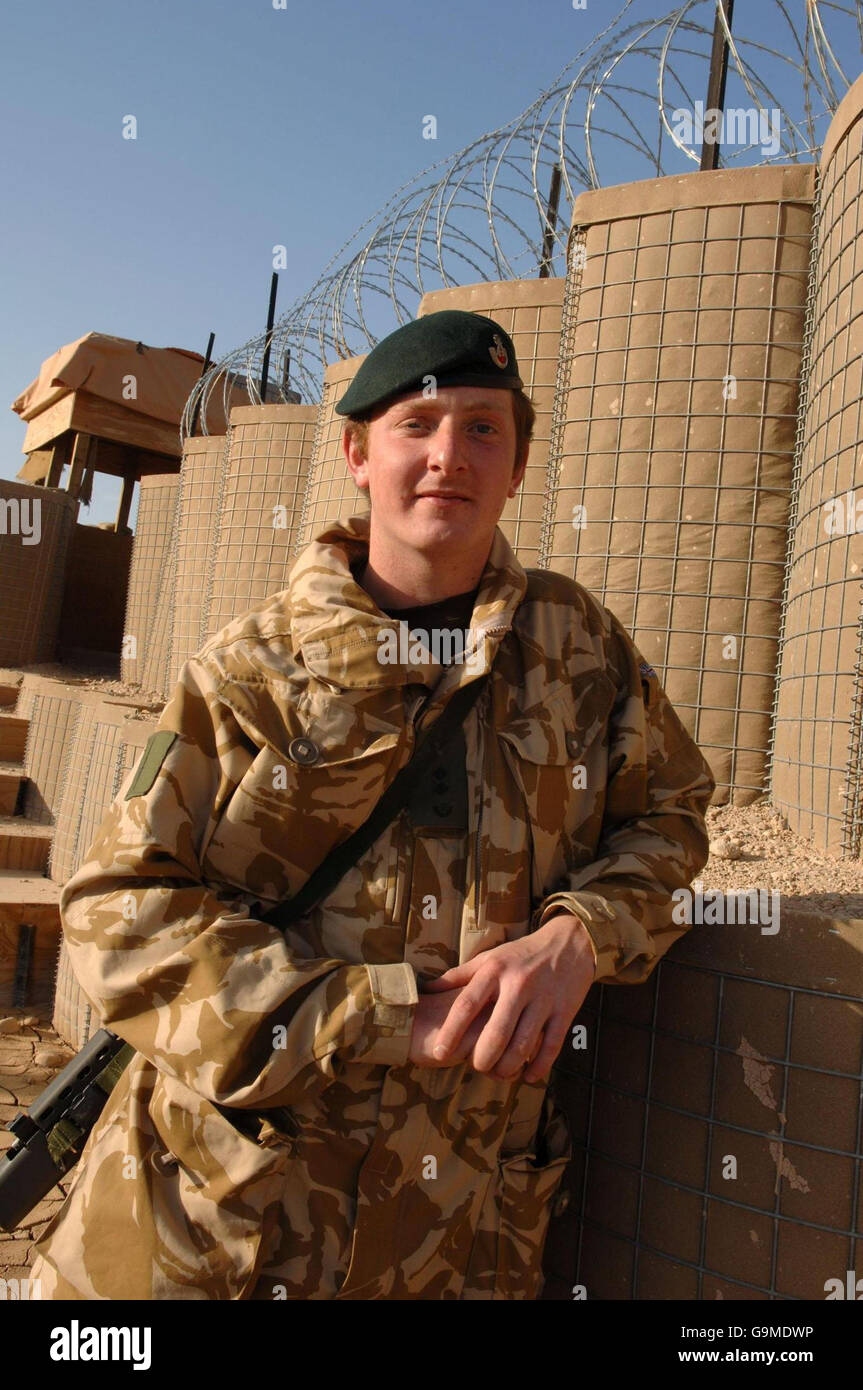 Lieutenant Tom Payne of Exeter is a member of the 2nd Battalion Light Infantry stationed at FOB Price near Gersehk, Afghanistan. Stock Photohttps://www.alamy.com/image-license-details/?v=1https://www.alamy.com/stock-photo-lieutenant-tom-payne-of-exeter-is-a-member-of-the-2nd-battalion-light-109244066.html
Lieutenant Tom Payne of Exeter is a member of the 2nd Battalion Light Infantry stationed at FOB Price near Gersehk, Afghanistan. Stock Photohttps://www.alamy.com/image-license-details/?v=1https://www.alamy.com/stock-photo-lieutenant-tom-payne-of-exeter-is-a-member-of-the-2nd-battalion-light-109244066.htmlRMG9MDWP–Lieutenant Tom Payne of Exeter is a member of the 2nd Battalion Light Infantry stationed at FOB Price near Gersehk, Afghanistan.
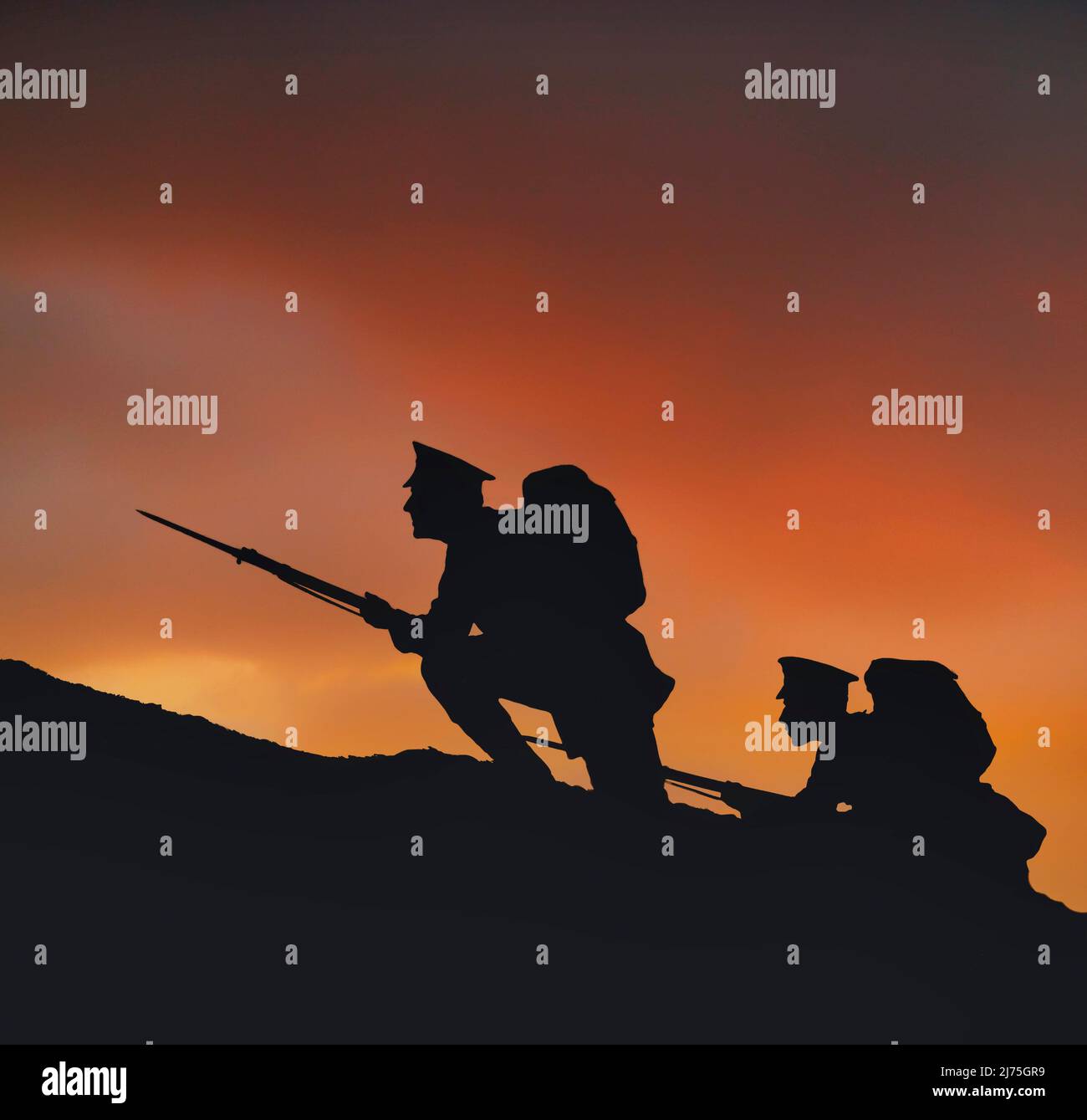 Two soldiers on a dawn raid with rifles and fixed bayonets. Silhouetted against a reddening sky, they climb a hill on the frontline during World War One, 1914-1918. Stock Photohttps://www.alamy.com/image-license-details/?v=1https://www.alamy.com/two-soldiers-on-a-dawn-raid-with-rifles-and-fixed-bayonets-silhouetted-against-a-reddening-sky-they-climb-a-hill-on-the-frontline-during-world-war-one-1914-1918-image469105485.html
Two soldiers on a dawn raid with rifles and fixed bayonets. Silhouetted against a reddening sky, they climb a hill on the frontline during World War One, 1914-1918. Stock Photohttps://www.alamy.com/image-license-details/?v=1https://www.alamy.com/two-soldiers-on-a-dawn-raid-with-rifles-and-fixed-bayonets-silhouetted-against-a-reddening-sky-they-climb-a-hill-on-the-frontline-during-world-war-one-1914-1918-image469105485.htmlRM2J75GR9–Two soldiers on a dawn raid with rifles and fixed bayonets. Silhouetted against a reddening sky, they climb a hill on the frontline during World War One, 1914-1918.
 Italian trench of the Great War towards the top of Mount La Sisilla. Piccole Dolomiti, Recoaro Terme, Vicenza province, Veneto, Italy, Europe. Stock Photohttps://www.alamy.com/image-license-details/?v=1https://www.alamy.com/italian-trench-of-the-great-war-towards-the-top-of-mount-la-sisilla-piccole-dolomiti-recoaro-terme-vicenza-province-veneto-italy-europe-image344395023.html
Italian trench of the Great War towards the top of Mount La Sisilla. Piccole Dolomiti, Recoaro Terme, Vicenza province, Veneto, Italy, Europe. Stock Photohttps://www.alamy.com/image-license-details/?v=1https://www.alamy.com/italian-trench-of-the-great-war-towards-the-top-of-mount-la-sisilla-piccole-dolomiti-recoaro-terme-vicenza-province-veneto-italy-europe-image344395023.htmlRM2B08FA7–Italian trench of the Great War towards the top of Mount La Sisilla. Piccole Dolomiti, Recoaro Terme, Vicenza province, Veneto, Italy, Europe.
 Hudons military whistle '1915' Stock Photohttps://www.alamy.com/image-license-details/?v=1https://www.alamy.com/hudons-military-whistle-1915-image68372674.html
Hudons military whistle '1915' Stock Photohttps://www.alamy.com/image-license-details/?v=1https://www.alamy.com/hudons-military-whistle-1915-image68372674.htmlRFDY6J16–Hudons military whistle '1915'
 Trenches of the Great War at Mount Fior. The famous novel 'Un anno sull'altipiano' by Emilio Lussu is set in this area. Asiago Plateau, Veneto, Italy. Stock Photohttps://www.alamy.com/image-license-details/?v=1https://www.alamy.com/trenches-of-the-great-war-at-mount-fior-the-famous-novel-un-anno-sullaltipiano-by-emilio-lussu-is-set-in-this-area-asiago-plateau-veneto-italy-image273069363.html
Trenches of the Great War at Mount Fior. The famous novel 'Un anno sull'altipiano' by Emilio Lussu is set in this area. Asiago Plateau, Veneto, Italy. Stock Photohttps://www.alamy.com/image-license-details/?v=1https://www.alamy.com/trenches-of-the-great-war-at-mount-fior-the-famous-novel-un-anno-sullaltipiano-by-emilio-lussu-is-set-in-this-area-asiago-plateau-veneto-italy-image273069363.htmlRMWT7AN7–Trenches of the Great War at Mount Fior. The famous novel 'Un anno sull'altipiano' by Emilio Lussu is set in this area. Asiago Plateau, Veneto, Italy.
 The front in France Description: Red Cross is carrying wounded over the top of the trench in Thiepval village. Annotation: The front in France. Red Cross carry wounded men on the edge of the trench in Thiepval. Date: {1914-1918} Location: France, Thiepval Keywords: stretcher irish, first world war, fronts, wounded, trenches Stock Photohttps://www.alamy.com/image-license-details/?v=1https://www.alamy.com/the-front-in-france-description-red-cross-is-carrying-wounded-over-the-top-of-the-trench-in-thiepval-village-annotation-the-front-in-france-red-cross-carry-wounded-men-on-the-edge-of-the-trench-in-thiepval-date-1914-1918-location-france-thiepval-keywords-stretcher-irish-first-world-war-fronts-wounded-trenches-image342159051.html
The front in France Description: Red Cross is carrying wounded over the top of the trench in Thiepval village. Annotation: The front in France. Red Cross carry wounded men on the edge of the trench in Thiepval. Date: {1914-1918} Location: France, Thiepval Keywords: stretcher irish, first world war, fronts, wounded, trenches Stock Photohttps://www.alamy.com/image-license-details/?v=1https://www.alamy.com/the-front-in-france-description-red-cross-is-carrying-wounded-over-the-top-of-the-trench-in-thiepval-village-annotation-the-front-in-france-red-cross-carry-wounded-men-on-the-edge-of-the-trench-in-thiepval-date-1914-1918-location-france-thiepval-keywords-stretcher-irish-first-world-war-fronts-wounded-trenches-image342159051.htmlRM2ATJKA3–The front in France Description: Red Cross is carrying wounded over the top of the trench in Thiepval village. Annotation: The front in France. Red Cross carry wounded men on the edge of the trench in Thiepval. Date: {1914-1918} Location: France, Thiepval Keywords: stretcher irish, first world war, fronts, wounded, trenches
 France, Haut Rhin, Hautes Vosges, Hartmannswillerkopf or Old Armand, trenches that mix at the top and the cross of Hartmannswillerkopf, renamed Vieil Armand after the First World War, is a rocky pyramid spur, in the massif Vosges, overlooking 956 meters the plain of Alsace Haut Rhin Stock Photohttps://www.alamy.com/image-license-details/?v=1https://www.alamy.com/france-haut-rhin-hautes-vosges-hartmannswillerkopf-or-old-armand-trenches-that-mix-at-the-top-and-the-cross-of-hartmannswillerkopf-renamed-vieil-armand-after-the-first-world-war-is-a-rocky-pyramid-spur-in-the-massif-vosges-overlooking-956-meters-the-plain-of-alsace-haut-rhin-image246269651.html
France, Haut Rhin, Hautes Vosges, Hartmannswillerkopf or Old Armand, trenches that mix at the top and the cross of Hartmannswillerkopf, renamed Vieil Armand after the First World War, is a rocky pyramid spur, in the massif Vosges, overlooking 956 meters the plain of Alsace Haut Rhin Stock Photohttps://www.alamy.com/image-license-details/?v=1https://www.alamy.com/france-haut-rhin-hautes-vosges-hartmannswillerkopf-or-old-armand-trenches-that-mix-at-the-top-and-the-cross-of-hartmannswillerkopf-renamed-vieil-armand-after-the-first-world-war-is-a-rocky-pyramid-spur-in-the-massif-vosges-overlooking-956-meters-the-plain-of-alsace-haut-rhin-image246269651.htmlRMT8JFCK–France, Haut Rhin, Hautes Vosges, Hartmannswillerkopf or Old Armand, trenches that mix at the top and the cross of Hartmannswillerkopf, renamed Vieil Armand after the First World War, is a rocky pyramid spur, in the massif Vosges, overlooking 956 meters the plain of Alsace Haut Rhin
 A sign depicting the Thai-Myanmar border with Thailand flags on top. The Chang Moob Military Outpost now turned into a tourist attraction spot, used to be a Thai Royal Army location to prevent drug smuggling and keep an eye on other suspicious activities on the Myanmar side (mostly in the 1990s). Also called the 'Doi Tung Trenches' It starts off with a narrow pathway through high bamboo fences before reaching the main spot with deep trenches along the northernmost sections of the Thai-Myanmar border, with a stunning view of Myanmar mountains. (Photo by Guillaume Payen/SOPA Images/Sipa USA) Stock Photohttps://www.alamy.com/image-license-details/?v=1https://www.alamy.com/a-sign-depicting-the-thai-myanmar-border-with-thailand-flags-on-top-the-chang-moob-military-outpost-now-turned-into-a-tourist-attraction-spot-used-to-be-a-thai-royal-army-location-to-prevent-drug-smuggling-and-keep-an-eye-on-other-suspicious-activities-on-the-myanmar-side-mostly-in-the-1990s-also-called-the-doi-tung-trenches-it-starts-off-with-a-narrow-pathway-through-high-bamboo-fences-before-reaching-the-main-spot-with-deep-trenches-along-the-northernmost-sections-of-the-thai-myanmar-border-with-a-stunning-view-of-myanmar-mountains-photo-by-guillaume-payensopa-imagessipa-usa-image592531454.html
A sign depicting the Thai-Myanmar border with Thailand flags on top. The Chang Moob Military Outpost now turned into a tourist attraction spot, used to be a Thai Royal Army location to prevent drug smuggling and keep an eye on other suspicious activities on the Myanmar side (mostly in the 1990s). Also called the 'Doi Tung Trenches' It starts off with a narrow pathway through high bamboo fences before reaching the main spot with deep trenches along the northernmost sections of the Thai-Myanmar border, with a stunning view of Myanmar mountains. (Photo by Guillaume Payen/SOPA Images/Sipa USA) Stock Photohttps://www.alamy.com/image-license-details/?v=1https://www.alamy.com/a-sign-depicting-the-thai-myanmar-border-with-thailand-flags-on-top-the-chang-moob-military-outpost-now-turned-into-a-tourist-attraction-spot-used-to-be-a-thai-royal-army-location-to-prevent-drug-smuggling-and-keep-an-eye-on-other-suspicious-activities-on-the-myanmar-side-mostly-in-the-1990s-also-called-the-doi-tung-trenches-it-starts-off-with-a-narrow-pathway-through-high-bamboo-fences-before-reaching-the-main-spot-with-deep-trenches-along-the-northernmost-sections-of-the-thai-myanmar-border-with-a-stunning-view-of-myanmar-mountains-photo-by-guillaume-payensopa-imagessipa-usa-image592531454.htmlRM2WC03WJ–A sign depicting the Thai-Myanmar border with Thailand flags on top. The Chang Moob Military Outpost now turned into a tourist attraction spot, used to be a Thai Royal Army location to prevent drug smuggling and keep an eye on other suspicious activities on the Myanmar side (mostly in the 1990s). Also called the 'Doi Tung Trenches' It starts off with a narrow pathway through high bamboo fences before reaching the main spot with deep trenches along the northernmost sections of the Thai-Myanmar border, with a stunning view of Myanmar mountains. (Photo by Guillaume Payen/SOPA Images/Sipa USA)
 Chiang Rai, Thailand. 9th Jan, 2024. A sign depicting the Thai-Myanmar border with Thailand flags on top. The Chang Moob Military Outpost now turned into a tourist attraction spot, used to be a Thai Royal Army location to prevent drug smuggling and keep an eye on other suspicious activities on the Myanmar side (mostly in the 1990s). Also called the ''Doi Tung Trenches'' It starts off with a narrow pathway through high bamboo fences before reaching the main spot with deep trenches along the northernmost sections of the Thai-Myanmar border, with a stunning view of Myanmar mountains. (Credit Im Stock Photohttps://www.alamy.com/image-license-details/?v=1https://www.alamy.com/chiang-rai-thailand-9th-jan-2024-a-sign-depicting-the-thai-myanmar-border-with-thailand-flags-on-top-the-chang-moob-military-outpost-now-turned-into-a-tourist-attraction-spot-used-to-be-a-thai-royal-army-location-to-prevent-drug-smuggling-and-keep-an-eye-on-other-suspicious-activities-on-the-myanmar-side-mostly-in-the-1990s-also-called-the-doi-tung-trenches-it-starts-off-with-a-narrow-pathway-through-high-bamboo-fences-before-reaching-the-main-spot-with-deep-trenches-along-the-northernmost-sections-of-the-thai-myanmar-border-with-a-stunning-view-of-myanmar-mountains-credit-im-image592530700.html
Chiang Rai, Thailand. 9th Jan, 2024. A sign depicting the Thai-Myanmar border with Thailand flags on top. The Chang Moob Military Outpost now turned into a tourist attraction spot, used to be a Thai Royal Army location to prevent drug smuggling and keep an eye on other suspicious activities on the Myanmar side (mostly in the 1990s). Also called the ''Doi Tung Trenches'' It starts off with a narrow pathway through high bamboo fences before reaching the main spot with deep trenches along the northernmost sections of the Thai-Myanmar border, with a stunning view of Myanmar mountains. (Credit Im Stock Photohttps://www.alamy.com/image-license-details/?v=1https://www.alamy.com/chiang-rai-thailand-9th-jan-2024-a-sign-depicting-the-thai-myanmar-border-with-thailand-flags-on-top-the-chang-moob-military-outpost-now-turned-into-a-tourist-attraction-spot-used-to-be-a-thai-royal-army-location-to-prevent-drug-smuggling-and-keep-an-eye-on-other-suspicious-activities-on-the-myanmar-side-mostly-in-the-1990s-also-called-the-doi-tung-trenches-it-starts-off-with-a-narrow-pathway-through-high-bamboo-fences-before-reaching-the-main-spot-with-deep-trenches-along-the-northernmost-sections-of-the-thai-myanmar-border-with-a-stunning-view-of-myanmar-mountains-credit-im-image592530700.htmlRM2WC02XM–Chiang Rai, Thailand. 9th Jan, 2024. A sign depicting the Thai-Myanmar border with Thailand flags on top. The Chang Moob Military Outpost now turned into a tourist attraction spot, used to be a Thai Royal Army location to prevent drug smuggling and keep an eye on other suspicious activities on the Myanmar side (mostly in the 1990s). Also called the ''Doi Tung Trenches'' It starts off with a narrow pathway through high bamboo fences before reaching the main spot with deep trenches along the northernmost sections of the Thai-Myanmar border, with a stunning view of Myanmar mountains. (Credit Im
 World War I, The Tribune Graphic, top: 'French soldiers testing new apparatus for shooting liquid fire', bottom: British soldiers, after the capture of German trenches at St. Eloi, France, June 18, 1916. Stock Photohttps://www.alamy.com/image-license-details/?v=1https://www.alamy.com/stock-photo-world-war-i-the-tribune-graphic-top-french-soldiers-testing-new-apparatus-32372572.html
World War I, The Tribune Graphic, top: 'French soldiers testing new apparatus for shooting liquid fire', bottom: British soldiers, after the capture of German trenches at St. Eloi, France, June 18, 1916. Stock Photohttps://www.alamy.com/image-license-details/?v=1https://www.alamy.com/stock-photo-world-war-i-the-tribune-graphic-top-french-soldiers-testing-new-apparatus-32372572.htmlRMBTJKF8–World War I, The Tribune Graphic, top: 'French soldiers testing new apparatus for shooting liquid fire', bottom: British soldiers, after the capture of German trenches at St. Eloi, France, June 18, 1916.
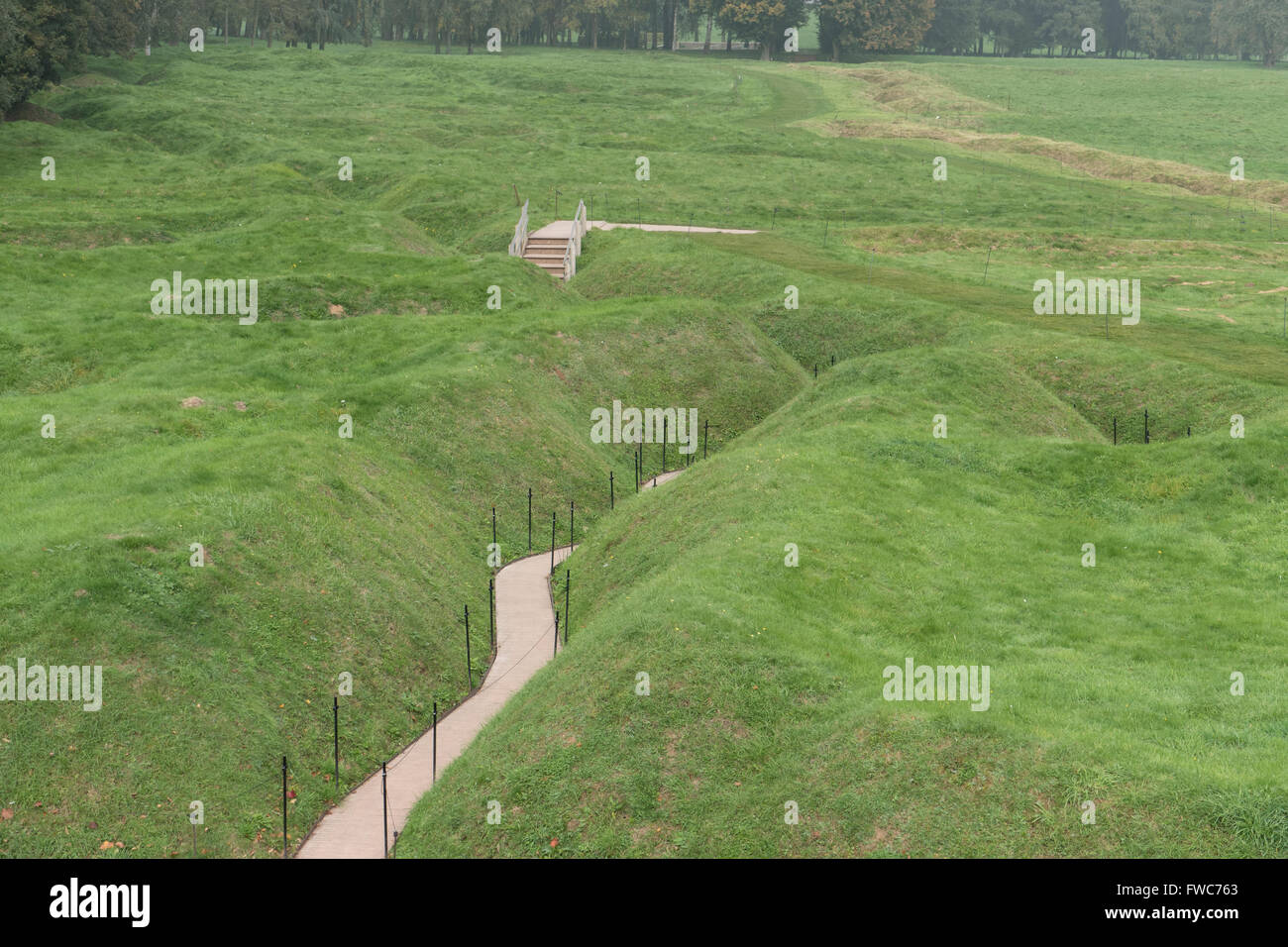 Remains of Canadian Army trenches (left) and German army trenches (top right). No-mans land spanned only a few yards. Stock Photohttps://www.alamy.com/image-license-details/?v=1https://www.alamy.com/stock-photo-remains-of-canadian-army-trenches-left-and-german-army-trenches-top-101687323.html
Remains of Canadian Army trenches (left) and German army trenches (top right). No-mans land spanned only a few yards. Stock Photohttps://www.alamy.com/image-license-details/?v=1https://www.alamy.com/stock-photo-remains-of-canadian-army-trenches-left-and-german-army-trenches-top-101687323.htmlRMFWC763–Remains of Canadian Army trenches (left) and German army trenches (top right). No-mans land spanned only a few yards.
 World War 1. Turkish troops leaving their trenches for a charge in a battle with French and British Troops in the early stages Stock Photohttps://www.alamy.com/image-license-details/?v=1https://www.alamy.com/stock-photo-world-war-1-turkish-troops-leaving-their-trenches-for-a-charge-in-59777564.html
World War 1. Turkish troops leaving their trenches for a charge in a battle with French and British Troops in the early stages Stock Photohttps://www.alamy.com/image-license-details/?v=1https://www.alamy.com/stock-photo-world-war-1-turkish-troops-leaving-their-trenches-for-a-charge-in-59777564.htmlRMDD72W0–World War 1. Turkish troops leaving their trenches for a charge in a battle with French and British Troops in the early stages
 Memorial with added realism Stock Photohttps://www.alamy.com/image-license-details/?v=1https://www.alamy.com/stock-photo-memorial-with-added-realism-51196962.html
Memorial with added realism Stock Photohttps://www.alamy.com/image-license-details/?v=1https://www.alamy.com/stock-photo-memorial-with-added-realism-51196962.htmlRMCY866X–Memorial with added realism
 World War 1. Battle of Arras (April 9-12, 1917). The second wave of British infantry leaves their trenches. The battle was planned to draw German forces away from the Nivelle Offensive, 80 miles to the South. After initial successes, the battle became one of attrition, with 158,000 British and 125,000 German causalities. April 9-May 16, 1917. (BSLOC 2013 1 138) Stock Photohttps://www.alamy.com/image-license-details/?v=1https://www.alamy.com/stock-photo-world-war-1-battle-of-arras-april-9-12-1917-the-second-wave-of-british-170553007.html
World War 1. Battle of Arras (April 9-12, 1917). The second wave of British infantry leaves their trenches. The battle was planned to draw German forces away from the Nivelle Offensive, 80 miles to the South. After initial successes, the battle became one of attrition, with 158,000 British and 125,000 German causalities. April 9-May 16, 1917. (BSLOC 2013 1 138) Stock Photohttps://www.alamy.com/image-license-details/?v=1https://www.alamy.com/stock-photo-world-war-1-battle-of-arras-april-9-12-1917-the-second-wave-of-british-170553007.htmlRMKWDA2R–World War 1. Battle of Arras (April 9-12, 1917). The second wave of British infantry leaves their trenches. The battle was planned to draw German forces away from the Nivelle Offensive, 80 miles to the South. After initial successes, the battle became one of attrition, with 158,000 British and 125,000 German causalities. April 9-May 16, 1917. (BSLOC 2013 1 138)